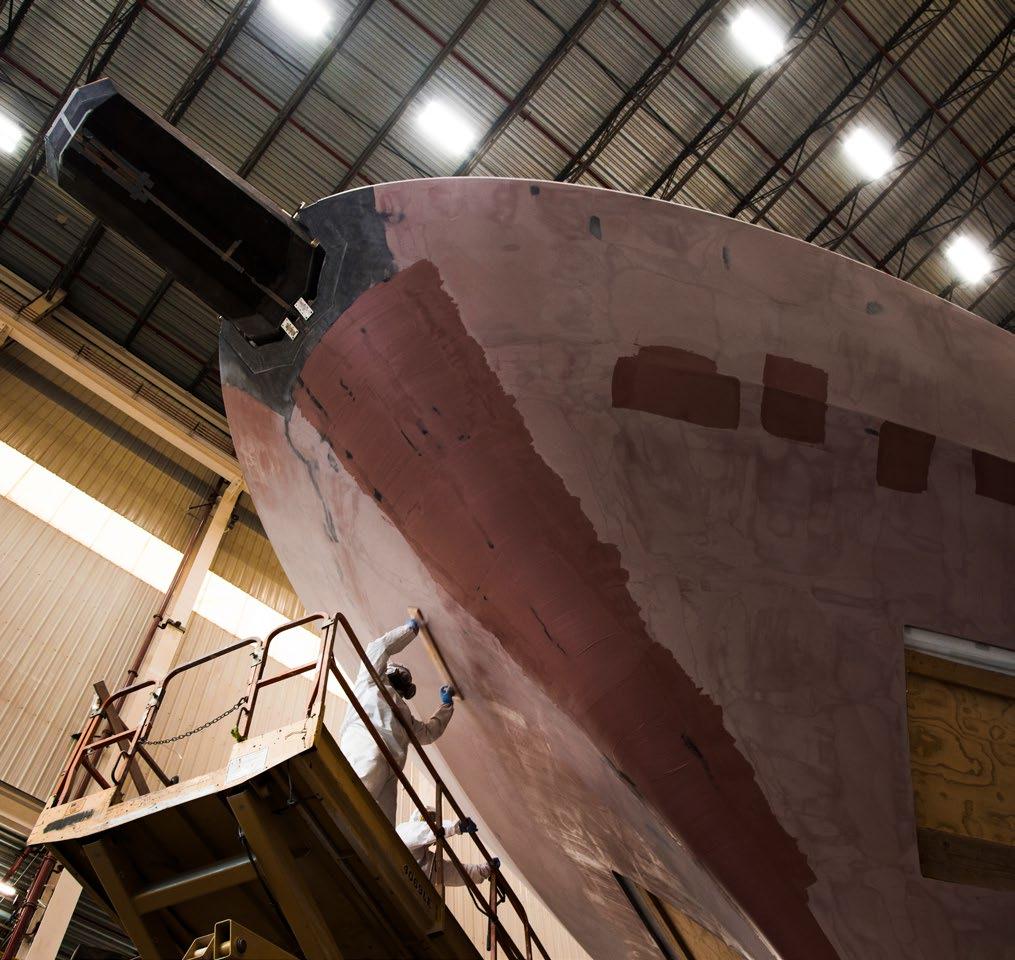




The technical magazine for those involved in the design, construction and refit of superyachts
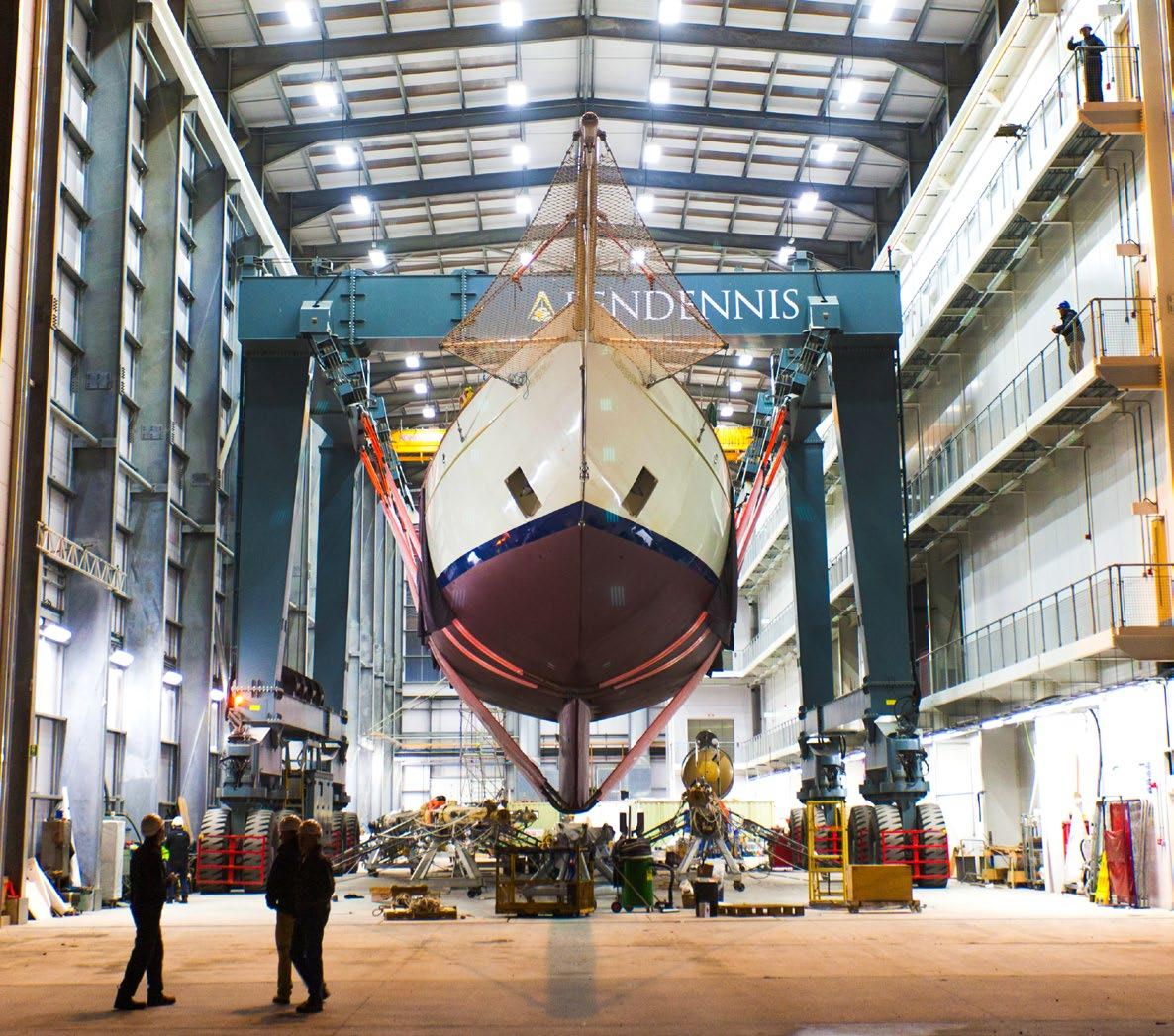







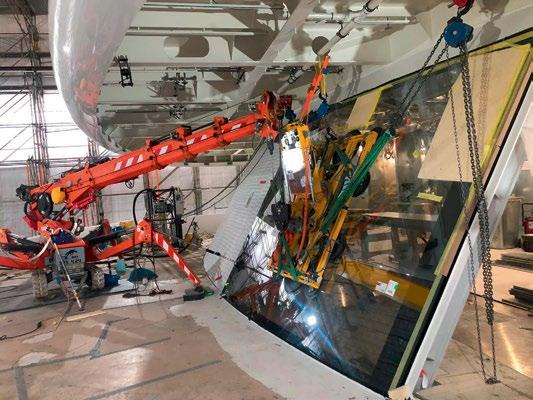

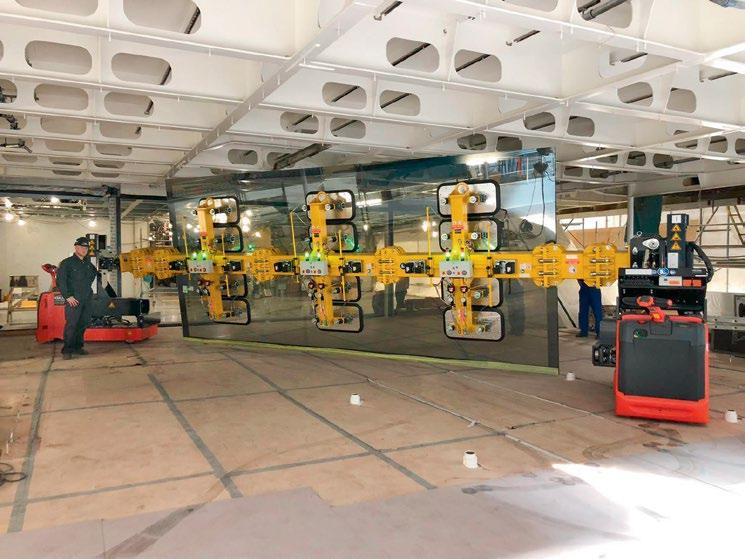
EDITORIAL
EDITOR IN CHIEF
EDITOR | HOW TO BUILD IT
EDITORIAL CONTRIBUTOR
FEATURES EDITOR
FEATURES WRITER
NEWS EDITOR
WRITER
CONTENT CREATOR
CONTENT CREATOR
Francesca Webster
Justin Ratcliffe
Charlotte Thomas
Leona Caanen
Enrico Chhibber
Sophie Spicknell
Andrea Pefianco
Nick Smits
Fabio Lima
DESIGN PRODUCTION
CREATIVE DIRECTOR
GRAPHIC DESIGNER
Ivo Nupoort
Beatriz Ramos
INTELLIGENCE
HEAD OF INTELLIGENCE
RESEARCH ANALYST
DATABASE MANAGER
Ralph Dazert
Adil Zaman
Syrine Mellakh
SALES & ADVERTISING
HEAD OF SALES
SALES MANAGER
SALES MANAGER
SALES MANAGER
SALES MANAGER
CLIENT SERVICE MANAGER
SALES ITALY
Marieke de Vries
Mitchell Cassee
Charly van den Enden
Nuri Ozkaya
Sabine van Hooidonk
Johanna Borreli
info@admarex.com
CORPORATE
FOUNDER & DIRECTOR
TECHNOLOGY DIRECTOR
FINANCE DIRECTOR
COMMERICAL DIRECTOR
Merijn de Waard
Fabian Tollenaar
Laura Weber
Bart Beemsterboer
SuperYacht Times B.V. Silodam 256, 1013 AS, Amsterdam, The Netherlands 31 (0) 20 773 28 64 info@superyachttimes.com www.superyachttimes.com
Cover Images:
Project Zembra by Justin Ratcliffe
REV Ocean by Justin Ratcliffe Pendennis by Rupert Pearce
How to Build It is published by SuperYacht Times B.V., a company registered at the Chamber of Commerce in Amsterdam, The Netherlands with registration number 52966461. The magazine was printed in October 2025.




Heinen & Hopman’s HVAC&R solutions seamlessly integrate into your yacht’s design, delivering silent, precise comfort in every space. Our systems ensure optimal air quality, temperature, and humidityallowing you to enjoy every journey in effortless comfort.



GET IN TOUCH WITH OUR TEAM OF SPECIALISTS
The yachting industry is increasingly subject to environmental, economic and geopolitical pressures. In this scenario, the one theme that keeps coming up is rethinking the fundamentals – a central topic of this issue of How to Build It.
At one end of the scale, Antonini Navi in La Spezia is proving that bold thinking isn’t only reserved for the biggest boats. As demand grows for robustness, custom design and fast delivery, this young yard with a background in the oil and gas sector is betting on metal construction and modular platforms in a size bracket usually dominated by GRP.
Meanwhile, Delta Marine’s Project Zembra takes an adventurous approach to what an explorer yacht can be – in this case a 48-metre yacht built in composite with the payload of a much larger vessel. Able to carry everything from a mini sub to a seaplane, it’s a reminder that with a little creative design and engineering you can pack an awful lot into a compact package.
At the opposite extreme is REV Ocean. A decade in development, this 195-metre research vessel and superyacht represents the confluence of luxury, science, and environmental advocacy. A reminder that true innovation often happens on long timelines, she is being built thanks to the resources and patience of a man who could afford to wait for the right solutions, which are rarely the fastest ones.
Avant-garde projects don’t always reach the water. Our revisit of Neonemo, a 2008 concept for Tom Perkins by Ken Freivokh in collaboration with naval architect Patrick Bray, reveals a technical design that was ahead of its time. Though shelved due to circumstance, its innovations remain relevant today and we’re reminded how some of the best ideas aren’t always the most visible.
We also take a look at developments in rig design. Masts and spars on sailing boats or sail-assisted motor yachts are no longer just sail carriers: they can also be power generators, ventilation systems, and testbeds for materials science.
The common thread in all these stories is a willingness to rethink convention. Technical design, when well-executed, doesn’t need to shout. It’s in the structure, the integration and the way a yacht works – or doesn’t – when far from shore.

Justin Ratcliffe - Editor

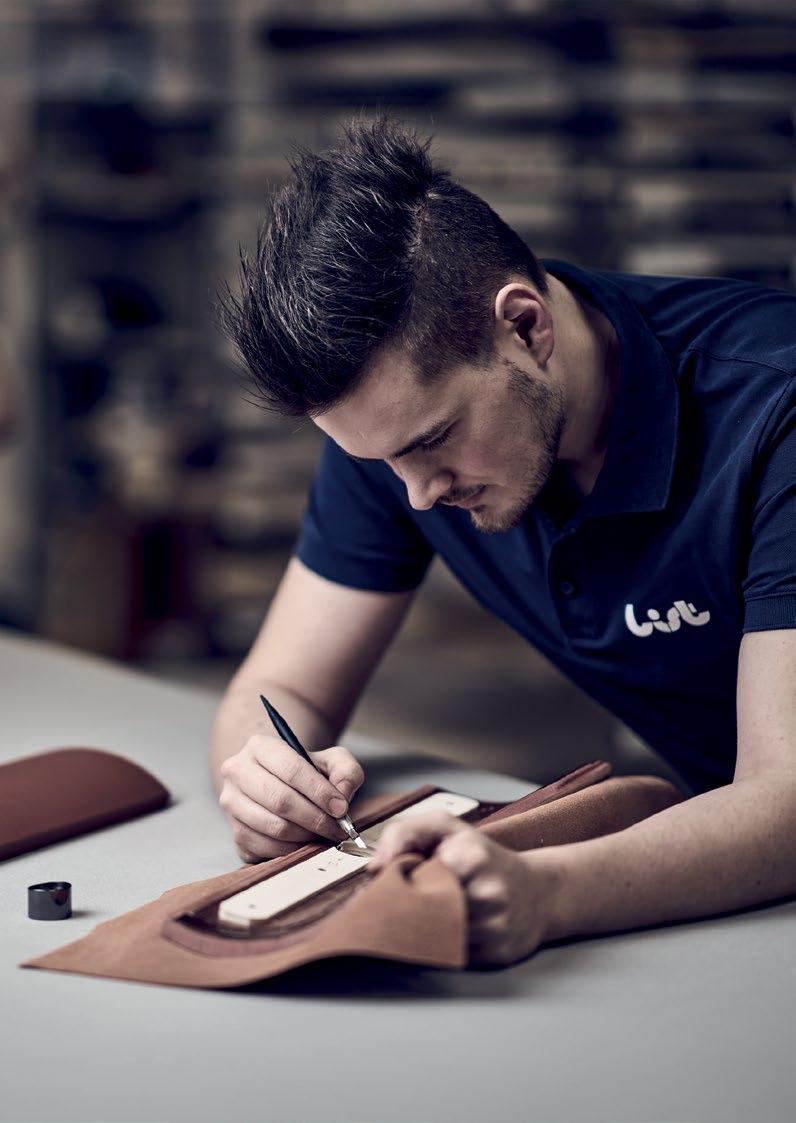

For generations, we have been realizing the most extraordinary living spaces with dedication and expertise. On water and on land. As a leading international partner in interior+ outfitting, we turn visions for living into reality – for both indoor and outdoor areas.
We are crafting visions.


Some
19 Supplier Spotlight: Multiplex
At the 1986 Admiral’s Cup in Cowes, Jan Reiners turned a rudder failure into the spark for Multiplex – a company that recognised early on the power of carbon fibre.
22 CEO in Conversation: Toni Salom of Nautipaints Group
Toni Salom on the family firm’s evolution from Mallorca’s first yacht chandlery to a full-service refit powerhouse as the group plans to move into new builds.
27 Business Brief: Masters of Versatility
From classic renovations to custom tenders, a visit to Falmouth reveals how Pendennis has blended rebuilds, refits, and new-builds into an ongoing success story.
40 Build Report: Quite a Journey
We step aboard 195-metre REV Ocean, the groundbreaking blend of research vessel and superyacht designed to push the boundaries of marine science and sustainability.
53 Concept in Focus: Ahead of Its Time
In 2008, a British designer and a Canadian naval architect collaborated on a forward-thinking explorer concept for an American venture capitalist. Although it was never built, the design remains cutting-edge to this day.

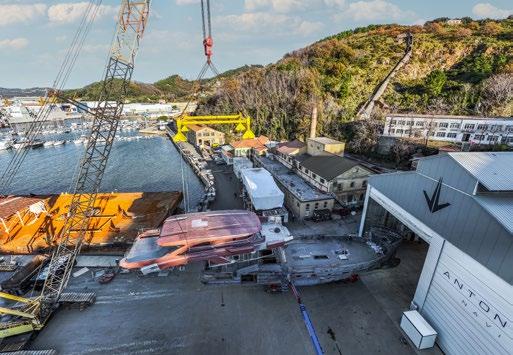
62 Industry Events: Metstrade 2025
Metstrade has been the stage for marine innovation since 1988, and this year’s edition set to break records. We take a look at just some of the new products being showcased in the Superyacht Zone.
76 Build Report: Carry That Weight
Project Zembra, Delta Marine’s 48-metre composite explorer, is a showcase example of how an ambitious brief has been met with innovative design and engineering.
88 Inside Angle: Sailing Meets Strategy
From teenage sailing instructor to round-the-world skipper, Arrow Monaco COO James Allen brings his hands-on experience and leadership skills to yacht management.
93 Onboard Systems: Waste Not, Want Not
As environmental restrictions tighten, modern superyachts must integrate advanced wastewater treatment from the design stage. We look into what needs to be taken into account.
105 Spars & Appendages: Mast, Present & Future
Over the last two decades, innovations in advanced composites have pushed the limits of what’s possible and transformed the masts and spars of today’s super-sailing projects.
114 Build Report: Proof of Concept
Young shipyard Antonini Navi is going head-to-head with composite builders by targeting the sub-300GT market with two steel-hulled sister ships due to launch shortly.
127 Industry Insight: The Hidden Energy Ogre
Accounting for half of onboard energy use, HVAC systems are evolving from 25-year-old standards to connected, intelligent solutions, says Patrick Voorn of Synergy | The HVAC Consultancy.

Two of Europe’s leading marine glass manufacturers, Yachtglass (Germany) and Hard Glass (Italy), have joined forces to launch Ocean Glass, a new joint venture aimed at revolutionising glazing solutions for the global superyacht market.
Ocean Glass brings together German engineering and Italian design at a time when demand for highspecification marine glass is surging. With the increasing use of expansive glazing on both the exteriors and interiors of luxury yachts, the new venture is poised to deliver precision, safety, and innovation at scale. Both companies will continue to operate independently and
maintain their existing customer relationships, but Ocean Glass will serve as a dedicated platform to develop new markets and deliver innovative solutions to emerging shipyards around the world.
“This partnership merges our strengths to serve new markets and deliver custom solutions where quality matters most,” said Silvia Buck, CEO of Yachtglass. “We’re especially focused on Turkey, the Middle East, and Asia.”
Fiorenzo Furlan, President of Hard Glass, adds: “Ocean Glass sets a new benchmark for performance and aesthetics in marine glazing. Together, we’re building the future of glass at sea.”
Alfa Laval has announced the appointment of Martijn Bergink as President of its Marine Division. He will also continue in his current roles as President of Business Unit Pumping Systems and Managing Director of Framo, an Alfa Laval-owned company.
Bergink, who joined Alfa Laval in 1998, has held several senior leadership positions within the Marine Division. In his new role, he will join the Group Management team. He succeeds Sameer Kalra, EVP and current President of the Marine Division, who is retiring after leading the business through significant growth and its transition toward decarbonization.
“I am honoured and excited by the opportunity to lead the Marine Division,” said Bergink. “I look forward to further developing the business to meet future customer needs as we continue the decarbonization journey and seize the opportunities ahead.”

The Marine Division, which accounted for 40 percent of Alfa Laval’s order intake in 2024, employs 6,300 people and focuses on energy efficiency, decarbonization, digitalisation, and environmental compliance.



















No matter what the age or what vibe you’re looking for on a cruise, keep the suds in the tub with our high performance, MAGLift™ Rotors.
An absolute dream at slow or zero speed™. Spread the word!





Castoldi, known for its waterjet drives and series tender production, has announced a new Jet Tender 34 Limo, its first venture into the limousine segment. The Italian brand has worked with the Nauta Design studio to deliver a sophisticated ship-to-shore guest experience for a fleet of ultra-luxury cruise ships operated by the Aman Group, currently under construction at the Mariotti Shipyard. With the hull mould already complete, the first unit of the Castoldi Jet Tender 34 Limo is scheduled for delivery at the end of 2025.
The clean-cut design incorporates generous headroom, multiple boarding options, a configurable cockpit with a range of seating arrangements and wrap-around windows, plus a dual-purpose pantry and bathroom area. The customisable platform can be evolved to suit different superyacht requirements, including Open Limo and Support Vessel versions.
“This collaboration between Castoldi and Nauta has ensured that the design didn’t just look beautiful but performed at the highest level,” says Giacomo Castoldi, CEO of Castoldi. “We’ve integrated technical systems in a way that enhances both comfort and aesthetics, creating an experience where innovation and luxury go hand-in-hand.”


Green Energy Storage (GES), an Italian innovator in the field of green energy storage, has signed a framework agreement with RINA, the multinational engineering consultancy, inspection and certification group, to develop a new hydrogen battery. The first prototype is scheduled to be presented in December 2025.
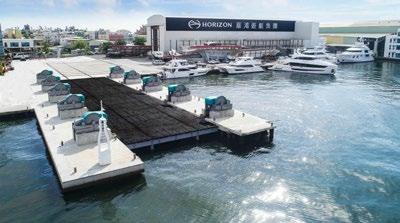
Horizon Group has completed a state-of-theart shiplift system at its Premier Shipyard in Kaohsiung, Taiwan, after two years of development. The yard, which spans 24,000 square metres and 200 metres of waterfront, is designed to accommodate yachts over 70 metres. Its new Pearlson Shiplift System measures 160 metres by 13.7 metres and can handle up to 1,800 metric tons. The installation follows Horizon’s $15 million expansion of the facility in 2021.
The company says the upgrade cements Premier Shipyard’s reputation as a destination for refits and maintenance The yard has serviced more than 30 yachts globally, including projects on vessels up to 69 metres and brands such as Feadship and Riva.
“We are very excited about this latest upgrade with the new Pearlson Shiplift System, as it marks a significant step in the Horizon Group’s ongoing expansion,” says John Lu, CEO of Horizon Group. “The shiplift provides our shipyard with vastly increased capabilities and capacity, helping to fulfill unprecedented demand for global superyacht owners.”
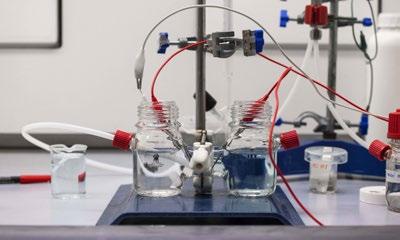
The battery is based on a hybrid hydrogen/liquid technology that uses a manganese-based liquid electrolyte. The system integrates hydrogen production and re-absorption in a closed cycle, eliminating the need for external tanks. This approach combines green chemistry, with abundant, non-toxic and recyclable active materials, with a modular and scalable design in which the energy and power components are independent, allowing the system to be expanded up to the megawatt scale. Its life cycle is expected to exceed 12,000 cycles, equal to about 15 to 20 years of use.
The collaboration with RINA marks a strategic step in guiding GES from a laboratory-scale prototype to a market-ready product. RINA will play an active role in validating the technology and facilitating the entry of the technology into the energy sector.
Sam, Electrical
1 OF 500 SKILLED CRAFTSPEOPLE

Whether refit, restoration or build, every Pendennis project is a true team effort. Our time-served tradespeople are experts in their field, crafting precise and perfect work at every step of the way.










































www.multiplexgmbh.com




























































New projects in early stages of construction that present opportunities for OEMs, suppliers and subcontractors.
The fully custom yacht will be constructed by Lynx Yachts and features a masculine exterior design by Weel Sluijter. With a beam of 8.85-metres, a draft of 2.25-metres and a gross tonnage of 199 GT, she has been tailored to a highly specific brief. Below deck, two 14.5 square-metre rooms can be adapted to suit the owner’s requirements. Meanwhile, a 62 squaremetre lazarette, located aft of the engine room, provides generous storage for inflatable toys, surfboards, canoes and scuba-diving equipment.

LENGTH: 32.55metres BUILDER: Lynx GT: 199 GT COUNTRY OF BUILD: The Netherlands DELIVERY YEAR: 2027 NAVAL ARCHITECTURE: Diana Yacht Design EXTERIOR DESIGNER: Weel Sluijter INTERIOR DESIGNER: Julian Moore Design
The commission marks the largest project in the yard’s history and was sold in cooperation with 26 North Yachts as build broker, with Arrow Monaco acting as the owner’s representative and new build management team. With an 11.6-metre beam and a volume of 1,513 GT, Project YN258 can accommodate up to 14 guests across seven staterooms, including two dedicated owners’ suites, one located on the bridge deck and the other occupying an entire private owners’ deck.

LENGTH: 70.1-metres BUILDER: Royal Hakvoort GT: 1,513 GT COUNTRY OF BUILD: The Netherlands DELIVERY YEAR: 2029 NAVAL ARCHITECTURE: Diana Yacht Design EXTERIOR & INTERIOR DESIGNER: Sinot Yacht Architecture & Design
Vard has announced its partnership with USbased marine research organisation Inkfish for the design and construction of the 100-metre custom-built research vessel RV6000, based on the Vard 9 33 design. The contract is valued at over €200 million. Fincantieri, owner of Vard, will also be involved in the project and RV6000 will join the Inkfish fleet alongside vessels Hydra and Dagon .
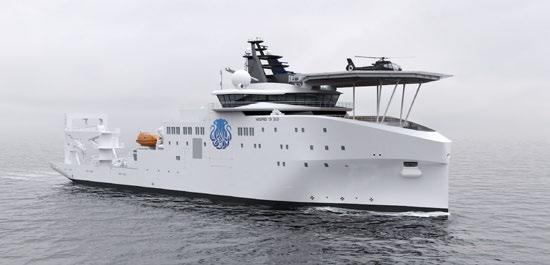
LENGTH: 100-metres BUILDER: Vard Group AS GT: C.6,000 GT
COUNTRY OF BUILD: Norway DELIVERY YEAR: 2028
NAVAL ARCHITECTURE: Vard Group AS EXTERIOR DESIGNER: Vard Group AS INTERIOR DESIGNER: Unknown
In July Maiora, part of the NEXT Yacht Group unveiled its latest project, the 42-metre Exuma with the first hull already sold. All guest accommodations are located on the main deck, with the main saloon and entertainment areas located on the upper deck. The yacht offers two engine configurations: twin Volvo Penta engines delivering a cruising speed of 16 knots and a top speed of 20 knots, and triple MTU engines providing a cruising speed of 26 knots with a top speed of 30 knots.

LENGTH: 42.49-metres BUILDER: Maiora Yachts GT: 430 GT COUNTRY OF BUILD: Italy DELIVERY YEAR: 2027
NAVAL ARCHITECTURE: Maiora EXT. DESIGNER: Cassetta Yacht Designers INT. DESIGNER: Carlo Colombo of A++ and Elie Saab
As the inaugural model in the series, she also represents the first in-build yacht sale for the Tureddi Group. Azzurra will be constructed in steel and aluminium and will feature naval architecture penned by Van Oossanen Naval Architects, with exterior design from Giamboi Designs. Azzurra’s general arrangement focuses on liveable spaces and onboard comfort.

LENGTH: 36.7-metres BUILDER: Cantieri Navali Tureddi GT: 350 GT
NAVAL ARCHITECTURE: Van Oossanen Naval Architects
COUNTRY OF BUILD: Italy DELIVERY YEAR: 2027
EXTERIOR DESIGNER: Giamboi Designs INT. DESIGNER: N/A
Described as a “grand coupé of the sea,” the ISA 100m Custom combines a sleek, automotive-inspired profile with the shipyard’s iconic ISA arch, reinterpreted with a strikingly dynamic strength. A fusion of power, elegance and functionality, the yacht features a steel hull and aluminium superstructure, 2,999 GT of interior volume and a certified helideck.
LENGTH: 100-metres BUILDER: ISA Yachts GT: 2,999 GT
NAVAL ARCHITECTURE: Palumbo Superyachts

COUNTRY OF BUILD: Italy DELIVERY YEAR: 2029
EXTERIOR & INTERIOR DESIGNER: Team for Design - Enrico Gobbi
At a volume of 499 GT and being built with a steel hull and aluminum superstructure, the NL 47 Plus XL offers accommodation for 10 guests across five staterooms, supported by crew cabins for up to nine. The design blends timeless exterior lines with contemporary interiors that can be fully customised to each owner’s preferences.
LENGTH: 47.6-metres BUILDER: Mengi Yay GT: 499 GT
NAVAL ARCHITECTURE: Ginton Naval Architects

COUNTRY OF BUILD: Turkey DELIVERY YEAR: 2027
EXTERIOR & INTERIOR DESIGNER: Nuvolari Lenard
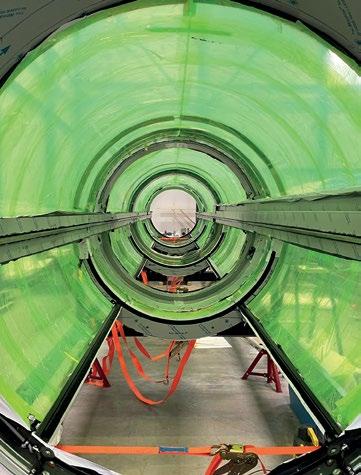





























The story of Multiplex begins in Cowes, England, at the 1986 Admiral’s Cup. Battling fierce winds during the regatta, keen sailor and boat builder Jan Reiners experienced issues with his boat’s rudder blades. Frustration turned to inspiration when he reached for a then little-used material in yachting: carbon fibre. Strong, light, and resilient, it solved his performance problems and sparked the idea for an innovative company with a product portfolio based entirely on carbon composites.
BY GEORGIA TINDALE

Jan Reiners
Nearly four decades later, the German composite specialist is a global leader.
From humble beginnings, multiplex products – ranging from gangways and swim ladders to fenders, awnings, and stairs – are now found on around 80 percent of the world’s largest sailing and motor superyachts.
“Multiplex began with basically nothing,” recalls CEO and founder Jan Reiners. “I had a 40-foot container with an oven inside, which I heated up to 130 degrees. Nowadays, we have our 2,500-square-metre facility in Bremen, which uses all of the latest cutting-edge techniques to produce the parts we need.”
The early years were a period of experimentation. Multiplex even ventured briefly into yachtbuilding, producing a tender, a 50foot day sailor, and a 72-foot high-performance sailing yacht. But Reiners quickly realised the future lay in perfecting components, not whole boats. The company has streamlined its focus to a tight but growing portfolio of seven product lines – all crafted from carbon fibre.
While the catalogue has remained largely unchanged for more than 35 years, the yachts themselves have not. As superyachts have grown in scale, so too have the Multiplex systems. Reiners points to his first product, the multiflap gangway, which has been in production for over 35 years, but over that time the scale of it has changed completely to match the growing size of yachts. Notwithstanding this scaling up of products, however, they never exceed 25 kilograms in weight. This is because ease of operation for the crew is a top priority.
“Everything is still completely manually operated,” Reiners explains. “There is no pushbutton system. The crew need to grab a swim ladder or a gangway the moment the owner or guests ask for it – so it has to be light, reliable, easy to handle, and of high quality.”
A watershed year for the company came in 2019, when Reiners chose to expand the company’s project capacity six-fold – from 20 to 120 – in one fell swoop. It was a bold gamble, requiring a major shift in operations, staffing, and supply chain management. Manufacturing and engineering moved partly out of house, which required new focus on project oversight and quality control.
“It was absolutely the right decision,” says Reiners. “We now have it entirely under control and are running 87 projects simultaneously. At peak season, I expect we’ll reach 120 or even 130. In five years, the aim is to be handling 130 to 150 projects. But we don’t want endless growth – we’re not in the automotive industry.”
Recent acquisitions, such as German filament-winding specialist Vinco, have strengthened Multiplex’s ability to deliver at scale while freeing up its in-house team for innovation. New products are already on the horizon, with several due to be unveiled at this autumn’s Metstrade show.
With sun awnings accounting for around 50 percent of production, its most technically complex standard product is the multistair, a fully carbon fibre, extendable and foldable side-boarding ladder of up to 14 steps, which has a production time of 8-12 weeks. But Multiplex also breaks ground with bespoke solutions on occasion. One such is a fully integrated steering station made entirely of carbon for a 38-metre yacht, for which the company was responsible for the complete production and project management. Behind the scenes, the team is developing new products and refining existing ones, with some set to debut at this year’s Metstrade show.
For Reiners, the journey has never been about chasing scale for its own sake. Instead, it has been about identifying problems, creating lightweight, durable solutions, and ensuring they can be deployed quickly and effectively on board. That ethos – born out of a rudder issue in Cowes nearly 40 years ago – remains at the heart of Multiplex today.
YOUR BEST CHOICE FOR NEWBUILD AND REFIT.

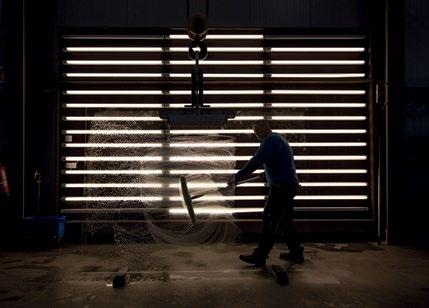
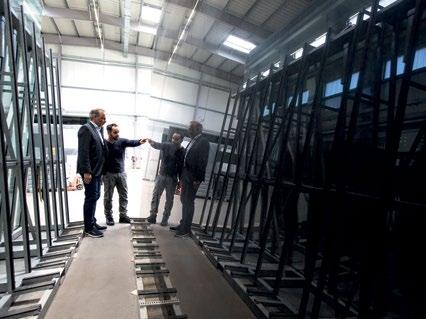
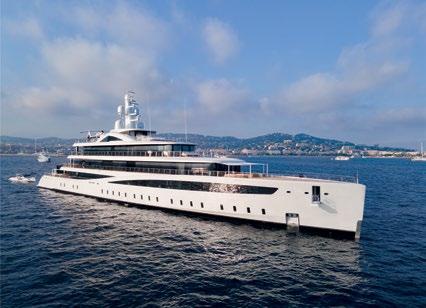


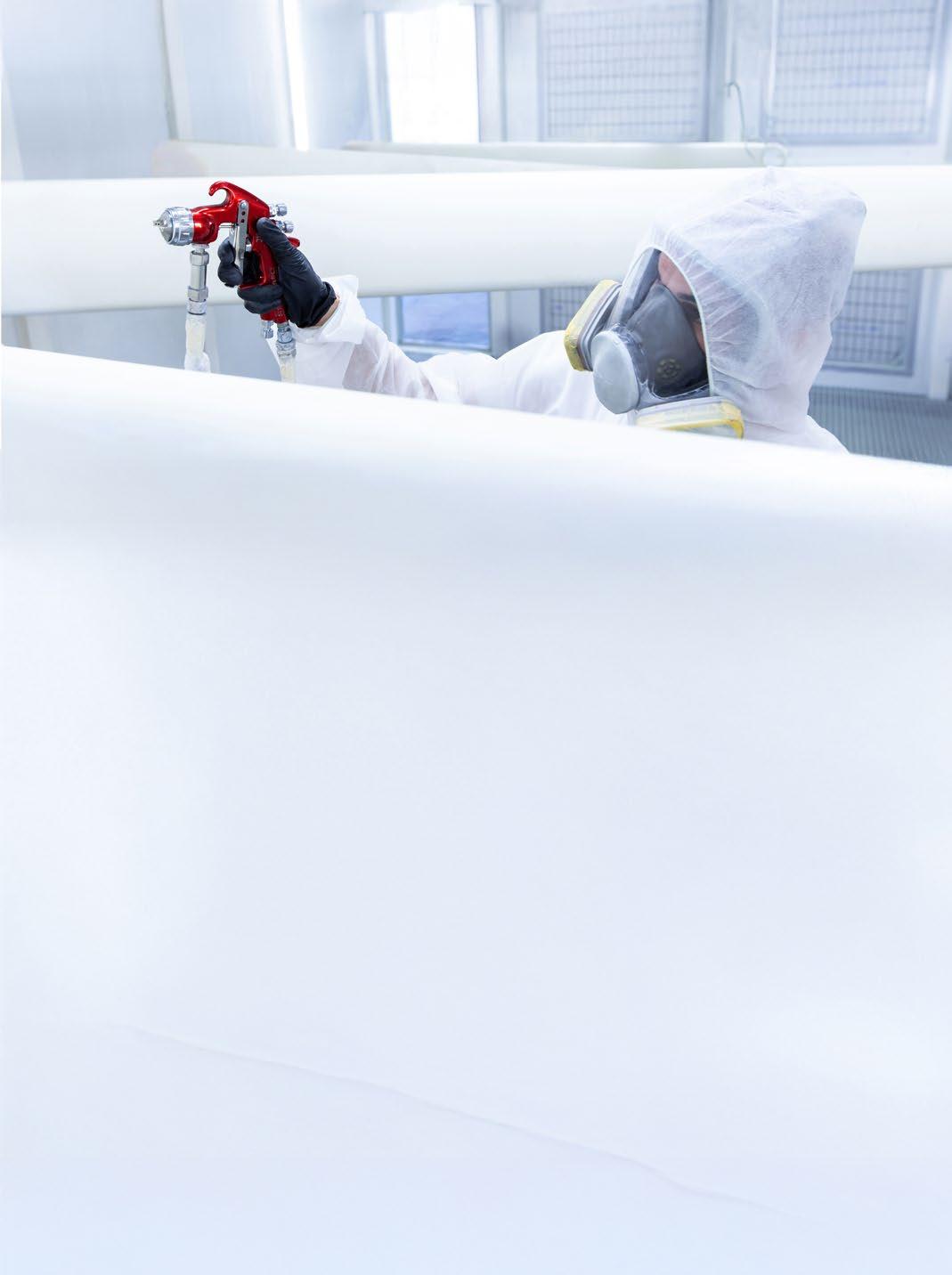
After starting life as Nautipesca Can Miguel, Mallorca’s first yacht chandlery in 1971, the family-run Nautipaints Group now spans superyacht painting and refinishing, hull and tank maintenance, marine supplies and, as of this year, scaffolding and containment. Following a recent spate of heavyweight refit projects – including Black Pearl and Maltese Falcon – CEO Toni Salom talks us through the company’s planned move towards new builds, how COVID-19 pushed it to embrace e-commerce, and how the tide has turned on electrostatic spray guns.
BY GEORGIA TINDALE

Nautipaints Group is a family affair. How important is that to you?
I saw the growth of the yachting industry in Mallorca from a few small fishing boats in the early 1990s to the huge yachts we have today. In recent years, my children, Maena (General Manager of Nautichandler) and Joan (Deputy General Manager of Nautipaints) are already starting to be group’s driving force. I’m still the CEO, but the company now has a third generation in the business, and I feel extremely proud of that.
How are you looking to grow the business going forward?
To increase our business, we need to target the new-build sector and the idea is to have an established position in the market within the next three years by consolidating our presence on mainland Spain, in the South of France, and northern Europe.
Over the last 20 years, Nautipaints has completed more than 250 full refit paint projects in 13 different locations, which reflects the scale and reliability of our operations. As part of a three-year strategic plan, we aim to continue expanding all four divisions of Nautipaints Group beyond Mallorca, while also developing our presence in the new-build sector. This year, for example, we began collaborating on the construction of a 25-metre catamaran in Spain, a project that represents the direction in which we’re heading.
What is the biggest obstacle you’ve faced while growing the company?
COVID-19, without a doubt. We were lucky because my team managed to support each other and adapt during some very difficult moments, and come out stronger on the other side. It also gave me an inspirational idea. I was sitting at home and noticed that Amazon drivers were some of the only people working, and this inspired me to develop the e-commerce side of our supply business, which today is a key part of the group: a platform with worldwide shipping, from which we have already delivered to over 70 countries.
What have been the major technological developments you’ve seen in your sector over the past 50 years?
In general, we’re still working with the same products we’ve always worked with, although the quality of these have certainly improved over time. For example, primers have been developed that contain more solids to fend off corrosion. The choices available have also expanded – you can now choose from a huge array of different paint colours, for example, and we also have our own machines in-house to mix the paint ourselves.
Another major change has been our adoption of electrostatic spray guns, which we started using around five years ago. These are a great tool because they help us to really reduce our wastage. A few years ago, we were hesitant about training our guys in how to use them because clients were demanding that we use conventional airspray guns instead. Now it’s the total opposite. Beyond these specific examples, our focus is on the continuous incorporation of new developments and innovations that enhance efficiency, safety, and quality across all our projects.
Finally, what have been the most memorable or complex yacht projects you’ve worked on to date?
The most complex was probably the tank treatments we recently did for Black Pearl. We carried them out with the boat in the water, which nobody had ever attempted before. We had to strictly control the humidity and all of the environmental conditions, and passed all of the pipes through the boat itself, which was unusual. We also had to factor in the very real risk of explosion, which meant there was a lot of pressure around the project. Overall, though, it was a very successful project.
Again, with the work we did on Maltese Falcon, we were working in very complicated conditions. We completed the work in Italy in winter between November and April, so it was very rainy and windy at the time. Both were brilliant projects for us and helped show the industry what we’re capable of.
BY LEONA CAANEN


Starting Vyva Fabrics 35 years ago, it was just Carol Driessen, a 150 metres of Sunbrella acrylic and a passion for creating, using fabrics and colours. Based in Amsterdam, The Netherlands, Carol and her team are both textile visionaries and trendsetters, working with sustainable fabrics and Flexiteek before it was popular. Establishing their expertise early on, it’s now almost impossible to find a superyacht without a touch of Vyva Fabrics.
The yachting world has always felt like home for Carol, founder, owner and CEO of Vyva Fabrics. Growing up in a marina owned by her parents, Carol’s life has revolved around yachting. It should therefore come as no surprise that, in the early days, if a ship needed a refit or new outfitting, Carol would do it all herself.
The first few years, there was little she didn’t do. Carol held the title of warehouse manager, accountant, sales representative, shipping manager, booth builder, and general manager. Her maritime roots have given Carol a very straight forward, no-nonsense business mentality: creating the right fabric for the right project. While Carol has grown her team, she still enjoys being involved in all elements of the business, with help from her daughter, Karlijn.
Carol’s business has always had an element of family, with much of her inspiration, knowledge and network coming from growing up in her parents’ marina. While there have been many highs and lows over the course of 35 years, there isn’t a trace of hesitation when Carol notes her favourite moment: Karlijn joining the business. Working together for eight years already, the motherdaughter duo are now co-owners.
Another high in Carol’s career has been relocating to their current office in the industrial north of Amsterdam. While Carol immediately loved the feeling of the empty lot sitting right by the water, it took some motherly convincing to purchase it. The exclusive location, right across from the Damen Yachting Shipyard, would be able to serve both as an office and a warehouse. Even Carol’s 80-year-old mother, who went to have a look early on a Sunday morning, felt the area and its marine atmosphere was the right place for Vyva Fabrics.
While the maritime industry was Vyva Fabrics’ main focus for many years, Carol eventually expanded into other sectors, including hotels, hospitality and healthcare. Each new sector brings an assortment of challenges and opportunities regarding the fabrics Carol chooses to work with. Not only that, but working in the different sectors has shown Carol how versatile her fabrics truly are. Such as 4 Outdoor Fabrics, which is frequently used for outside furniture on superyachts, but is also more than ideal for hotels and hospitality: settings all requiring a certain level of comfort, as well as resistance to deep cleaning and need to be resistant to bleaching, whether from alcohol based cleaning solutions, chlorine or lying in the sun all day. Yet what makes Vyva Fabrics so unique is not just their knowledge or experience, but their desire to create something beautiful and durable. In each project, whether for a hospital, hotel or superyacht, the purpose of the fabric is deeply analysed. Carol, Karlijn and their team will sit with the architect, client or project manager, and inquire what
the desired fabric is for. Clients tend to have a vision of what they want, but lack the knowledge of how versatile some fabrics are and what they can best be used for. Many textiles still have the misconception of being non-versatile. Customers have a hard time imagining that a fluffy outdoor fabric exists, or that, because of its sensitivity to decoloration, linen isn’t ideal for outside. No matter what textiles are used, Vyva Fabrics tries to always be topped up on their stock, which sits tucked below their first-floor office. The entirety of their stock is digitalised, and Karlijn highlights how this has helped them deal with the numerous orders that come in each day. The ease of having the warehouse below the office, is that the company can ensure a quick delivery time. Two days for the Netherlands and Belgium, and 3-5 days for the rest of Europe. Even when a roll of fabric is out of stock, there’s a maximum wait of two weeks.
The digitalised stock and attention to detail for each project stem not only from Carol’s passion for her work, but also tie in with her desire to be sustainable. Carol draws a lot of her inspiration for textiles, colours and marketing campaigns from her love for nature and food. Focusing on sustainability and caring for the environment through distinguished use of certain fabrics is an ode to her source of inspiration. Throughout the last 35 years, all of Vyva’s fabrics have some extent of recycled materials, are mostly PFAS-free and always high quality. Such as Dinamica, made of discarded PET-bottles and polyester clothes, or REVYVA, made of 100% postconsumer plastic bottles.
Another way in which Carol has introduced recycled, durable products into her work, and which is considered to be another highlight of her career, is Flexiteek. When Carol started selling Flexiteek, everyone thought she was crazy, claiming no one would want synthetic wood on their yachts. Yet Flexiteek is engineered to last about 20 years, and is especially designed to be durable in a harsh marine environment and withstand the chartering world: sun, stains, scratches and salt. Carol’s vision was ahead of her time; now you can’t think of a superyacht without thinking about alternative teak decking, such as Flexiteek.
Rather than following trends, Carol has always been an innovator in the field of textile. Her expertise, insight and passion for her work, along with her maritime background, has made her the best in the business for the larger part of four decades. With a solid vision and foundation to build on, Carol looks excitedly towards the future and getting to share it with her daughter Karlijn, who will eventually take over the business. For now, the two work together effortlessly, each an expert in different creative and organisational elements of the business. Vyva Fabrics has been and will remain a household name in the textile industry, on superyachts and beyond.







Craftsmanship that lasts. Protection that goes beyond.
At De Koninggroep we protect what’s precious. With over three decades of expertise in blasting, coating, and preservation for the superyacht industry, we deliver lasting quality, down to the finest detail. Innovation where it matters, craftsmanship that endures. Today, tomorrow, and far beyond.
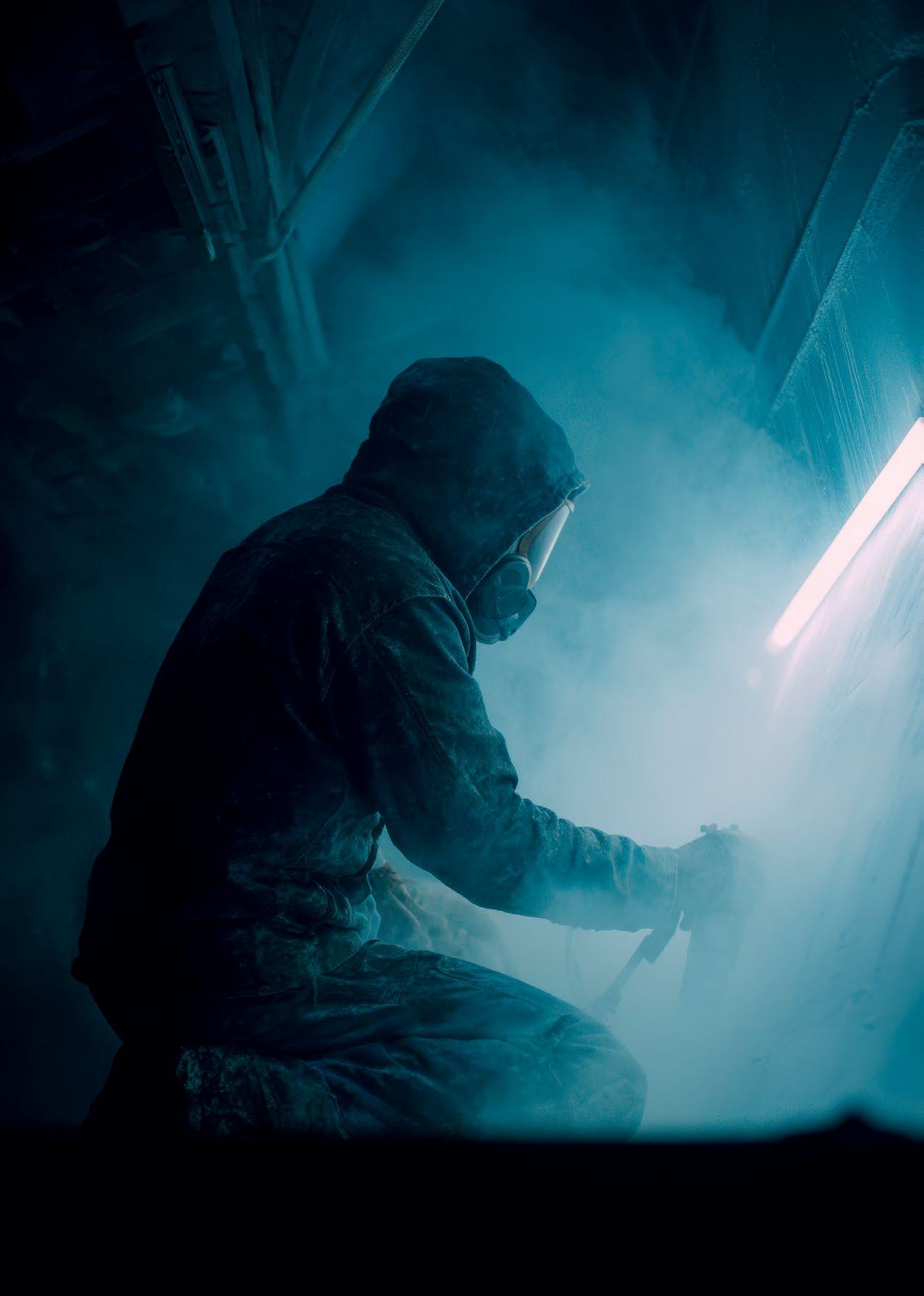













On a recent visit to the Pendennis facility in Falmouth, Cornwall, the breadth of work underway in a single shed was striking: a 50-metre Turquoise in refit, a custom Cockwells tender nearing completion, a classic Westsail 32 cutter fresh from maintenance, and a 10-metre motor boat receiving a new coat of paint. With a mix of refit, rebuild and new-build at the heart of the yard’s identity, our visit was an opportunity to explore the strategy and structure that have shaped the company’s success to date.
BY FRANCESCA WEBSTER
Below: 85.6-metre Aquila (ex-Cakewalk) in the 150-metre dry dock at Pendennis in Falmouth.
Facing page: The basin functions as a controlled arrival, commissioning and trials area.
Pendennis Shipyard was established in 1988 by British entrepreneur Peter de Savary to provide a dedicated facility for both yacht construction and refit. Its first new-build was delivered in 1991, the same year that the three-masted, gaffrigged schooner Adix underwent a major restoration. This dual focus on building and refitting, which has remained at the heart of the yard’s operations for more than three decades, continues to define Pendennis today. Over the past year alone, the yard has delivered the new-build motor yacht Fox, completed the major rebuild of the 1950’s explorer Seawolf, undertaken refits of the sailing yachts Ghost, Hetairos and Adix and built the Thames electric passenger vessel Silver Raven. Alongside these headline projects, a steady stream of refits, maintenance works and smaller commissions ensure the yard is as active as ever.
The Pendennis Group has expanded significantly in recent years, building a portfolio that extends beyond its home base in Falmouth. Alongside the shipyard’s core activities the group also owns Cockwells, known for its bespoke superyacht tenders, and Norfolk Interiors, a specialist in fine joinery that complements the yard’s interior projects. Pendennis Vilanova has strengthened its Mediterranean presence with a dedicated refit and service facility near Barcelona that provides continuity of care for its fleet. Together, these businesses create a diverse yet interconnected network that supports the group’s strategy of combining British craftsmanship with international outreach.

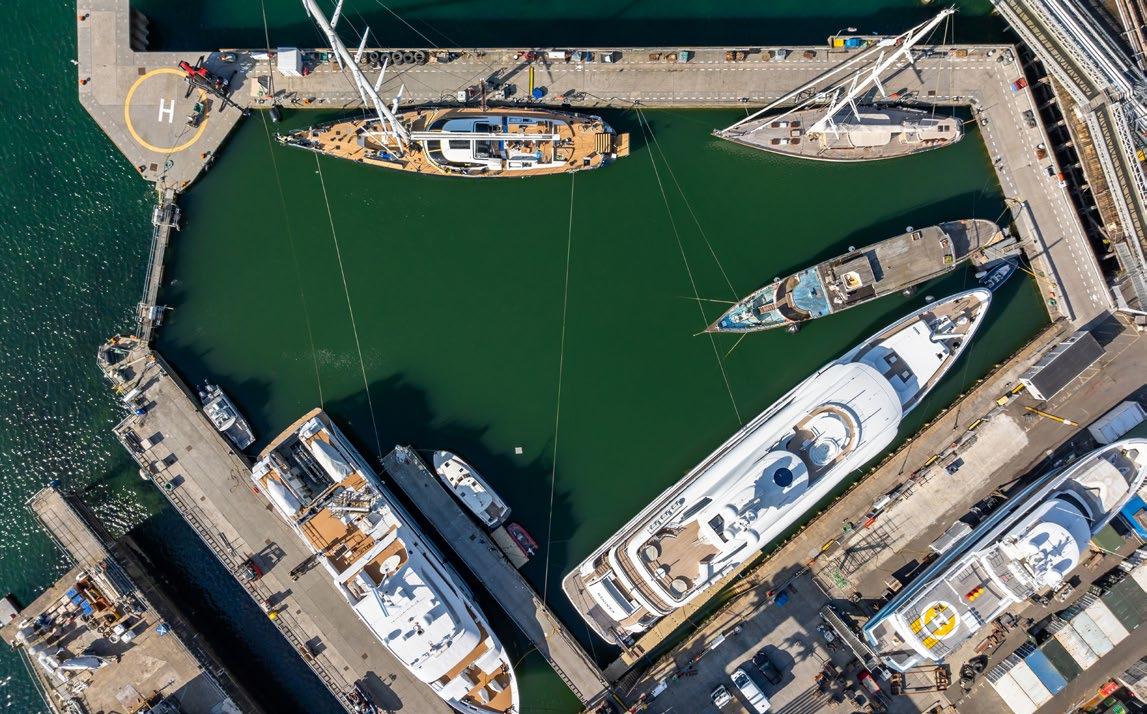

The Pendennis Group is guided today by a four-strong board of Directors – Toby Allies, Charlie Ross, Stephen Hills and Ian Granville – each bringing distinct expertise to the table as well as dividing responsibility to support and provide strategic direction to the subsidiaries, Norfolk Interiors, Cockwells and Pendennis Vilanova. Rather than a rigid hierarchy, they operate within a deliberately flat management structure, meeting weekly to coordinate activities across the group.
Co-founder Mike Carr is the Chairman of the Group and his role is complemented by nonexecutive directors providing governance and external perspective. Beneath this tier, individual companies within the group have their own management teams, ensuring both continuity and a clear pipeline for succession. It is a model that reflects Pendennis’s philosophy of shared responsibility and empowerment.
As Allies explains: “It’s a structure designed to balance ambition with resilience, ensuring the business continues to evolve without losing the family-minded culture that has long defined it.”
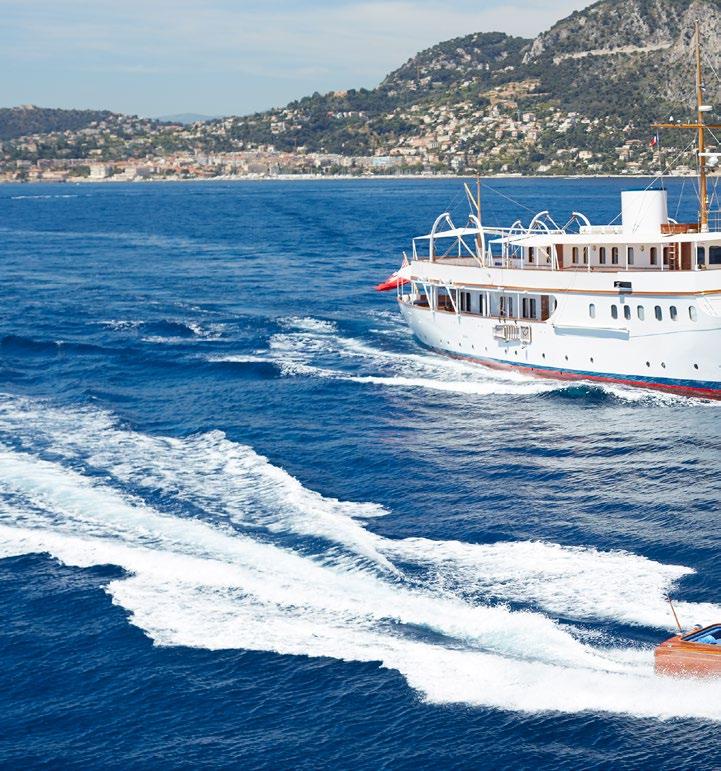


In parallel with its new-build activities, Pendennis has earned a reputation as one of the industry’s foremost refit and rebuild yards.
While Pendennis is perhaps best recognised for its major refit and restoration work, the yard also has a rich pedigree in newbuild construction dating back to the late 1980s. Its first new-build was the 37.4-metre sailing yacht Taipan of Wales, a project that set the tone for the yard’s commitment to craftsmanship and innovation in the sailing yacht sector. This debut firmly positioned Pendennis within the competitive custombuild market and laid the foundation for a tradition of complex, bespoke construction. By 1999, Pendennis had extended its newbuild credentials to motor yachts with the delivery of Moatize. This milestone broadened the shipyard’s scope beyond sailing yachts and underlined its ability to apply the same precision and attention to detail to motor yacht construction. Subsequent builds, including Ilona and Steel, showcased its capacity to tackle large-scale motor yacht projects with the same expertise as its sailing yachts.
In parallel with its new-build activities, Pendennis has earned a reputation as one of the industry’s foremost refit and rebuild yards, having completed over 120 significant projects alongside its 22 newbuilds. The early restorations of Adix, Adela and Fair Lady established the company’s methodology: anchoring long-term, technically demanding projects within its order book while balancing these with shorter service works.
The yard has since become the natural home for J Class yachts, with Shamrock V, Velsheda, Ranger and Lionheart among those entrusted to its care. Notably, many crew returning with their yachts encounter the very same craftsmen involved in earlier restorations – a continuity made possible by Pendennis’ longstanding apprenticeship programme, which ensures expertise is passed seamlessly between generations. Pendennis’ sailing yacht heritage is second to none, yet the yard has consistently applied those same skills to motor yachts.
“The close-quarters craftsmanship demanded by sailing yachts, with their cambers, sheer lines and tightly engineered spaces, enhances the workforce’s adaptability when tackling the vast scale of an 80-metre motor yacht,” says Allies. “This dual expertise allows Pendennis to keep its order book broad, ensuring resilience against fluctuations in either segment of the market.”
Acquired in 2024, the local Cornish yard Cockwells Boatbuilding provides the Pendennis Group with a dedicated capability in tenders and small craft. While its expertise is applied to Pendennis projects, Cockwells also serves external clients and other yards worldwide. This parallel activity broadens the group’s commercial reach. Innovation is another area where the two companies align. Cockwells has been active, for example, in developing hybrid propulsion solutions and composite techniques.
“Cockwells gives us the ability to support clients beyond the mothership,” says Stephen Hills. “A refit or new-build might also need a tender and by keeping that in-house we can ensure it meets the same standards and integrates smoothly into the project.”
Pendennis acquired Norfolk Interiors – a long-term Pendennis partner – in 2021 as a joinery and fit-out arm of the group, delivering interior outfitting for yachts alongside bespoke furniture and cabinetry for residential and commercial projects. For the yard, this provides greater control over quality and schedules without having to rely entirely on subcontractors. The company’s activity across both marine and landbased sectors is a deliberate strategy. Norfolk Interiors is also involved in training and apprenticeships, supporting the development of skilled tradespeople within the group.
“We’re conscious of the need to sustain craft skills,” continues Hills. “By having Norfolk Interiors in-house, we can provide real pathways for people to learn joinery and furniture making at the highest standard.”
Pendennis Vilanova was founded in 2018 at Vilanova Grand Marina, near Barcelona, as the group’s Mediterranean service base. The site now offers 30,000 square metres of hardstanding, a 620-tonne travel lift, and berths for yachts up to 130 metres. A significant portion of the superyacht fleet spends much of its time in the Mediterranean, which meant establishing a base here was a natural evolution. The yard works in tandem with Falmouth, offering maintenance and warranty support after major refits.
“When I arrived, it was still seen as a marina with a small lift,” says General Manager Miquel Lliteras, who joined in 2021, and has overseen the site’s transformation. “Today we can haul up to 55-metres and usually operate at close to full capacity.”.
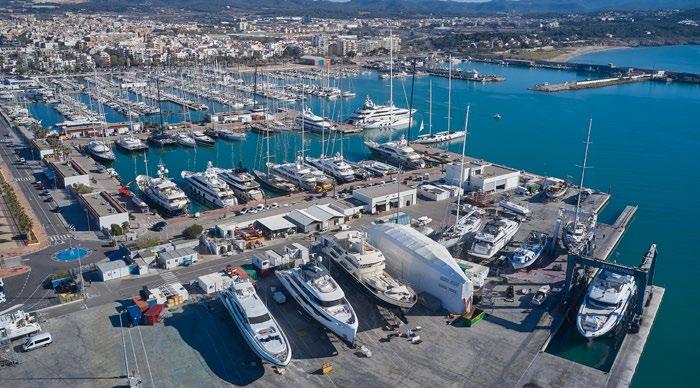


From its earliest years, Pendennis has consistently invested in flexible, engineering-heavy infrastructure rather than fixed production lines, enabling the yard to complete a variety of projects despite its limited physical footprint. A 150-metre dry dock is the backbone of the site, enabling large-scale restorations and bespoke newbuilds to run alongside seasonal service work that keeps its 500-strong workforce busy. Early spend focused on core trades –joinery, metalwork, electrical and paint – so the yard could self-perform critical paths and control quality from day one.
As the refit business accelerated, the yard added enclosed refit halls at the head of the dry dock, creating a weatherproof, yearround environment. Subsequent re-planning of the waterfront introduced a sheltered basin that functions as a controlled arrival, commissioning and trials area. Yachts can come alongside, enter refit halls or dock down without disrupting neighbours – effectively a two-lane workflow that separates heavy works from soft-commissioning and sea-trials logistics. In addition, the yard’s position at the entrance to Falmouth Harbour means that yachts can leave the basin and immediately start sea trails in a sheltered environment, heading out to open sea if necessary and return without having to navigate through challenging systems.
The £22 million development in 2015 was a decisive reset of site layout, including services and energy management. Electrical distribution, compressed air, extraction and fire systems were upgraded in parallel so multiple large projects could run safely at once. Environmental performance was improved with better containment, filtration and lighting, lifting finish standards while reducing rework. The programme also strengthened craneage, doors and access routes for taller rigs and broader beams, opening the door to larger sailing yachts and complex rebuilds.
Pendennis’ mobile lift capacity has progressed in lockstep with the fleet. The yard moved from the original 60-tonne travel hoist to 400 and 640 tonnes, before commissioning an 800-tonne lift in 2019. The former 640-tonne unit now serves at Pendennis Vilanova, giving the group a consistent haul-out methodology between Cornwall and the Mediterranean. Paired with the dry dock, this creates a clear split: up to 800 tonnes by hoist, beyond that via dock; maximising utilisation and minimising bottlenecks.
The 2025 launch of Silver Raven, a hybrid-electric Thames passenger vessel, demonstrates just how far Pendennis’ project capability has evolved. Entirely built in aluminium by Pendennis in Falmouth, with design and power profiling by Vulkan UK and an EST Floattech Octopus Series battery bank, the vessel can carry more than 300 passengers between Greenwich and Tower Bridge, recharging in just 15 minutes at each terminal.
Although far removed from a traditional superyacht, the project embodies Pendennis’s trademark qualities: exacting aluminium fabrication, complex systems integration and a collaborative relationship with an innovative ownership team.
Just as importantly, it demonstrates the transferability of knowledge gained on hybrid propulsion refits such as Seawolf into a different maritime sector.
“We’ve always embraced challenging projects, from ferries to architectural structures,” says Allies. “If it excites us and stretches the workforce, we are up to the challenge.”
What unites projects like Silver Raven, the J Class fleet and modern rebuilds is the Pendennis approach to project development. Each commission is treated as a bespoke exercise, managed not against a template but against the requirements of the vessel and its owner.



Pendennis has consistently invested in flexible, engineering-heavy infrastructure rather than fixed production lines, enabling the yard to complete a variety of projects despite its limited physical footprint.
The Digital Manufacturing Centre (DMC) is the newest pillar in the investment story –and an employee-led one. Proposed by the engineering team, the DMC brings rapid, on-site manufacture of critical parts into the heart of the yard. By consolidating processes such as precision machining, waterjet cutting and smallbatch fabrication in stainless steel, aluminium and bronze, the facility gives Pendennis the ability to deliver components on demand.
One of the greatest benefits is the speed from design to part. Engineers can work directly with captains and surveyors to model improvements, then produce and fit bespoke solutions without relying on external suppliers. For heritage yachts, the DMC has proven invaluable, allowing for the faithful recreation of fittings and fixtures no longer available, preserving historical integrity while ensuring safety and reliability. On modern performance sailing yachts, the facility also supports innovation, producing custom hardware to reduce weight, increase stiffness and enhance handling under sail.
“The DMC ultimately embodies our philosophy of retaining control over quality and schedule,” says Stephen Hills, Commercial Director at the Pendennis Group.
“By reducing downtime, eliminating freight delays and ensuring components meet the yard’s standards, the centre not only strengthens technical capability but also delivers a measurable return on investment.”


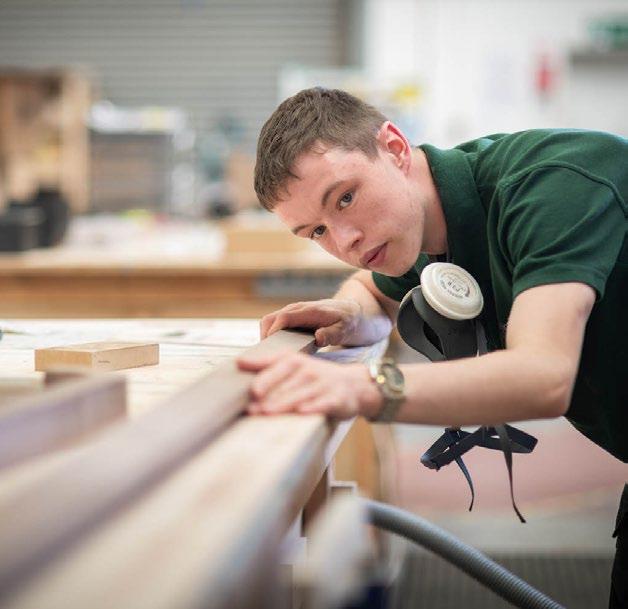
Investment has extended beyond Falmouth. Pendennis Vilanova provides Mediterranean haul-out, paint and pit-stop capability, giving clients continuity of people, process and documentation between refit cycles. The integration of Norfolk strengthens interior capacity for large projects, while Cockwells brings deep tender expertise that dovetails with Vilanova’s service offering. Each move targets pinch points – joinery throughput, tender servicing, regional access – rather than growth for growth’s sake.
Taken together, these investments have created a yard that can carry one or two anchor projects, a full-custom build or a multiyear restoration, while executing a balanced slate of seasonal refits and smaller projects. For owner representatives, project managers, captains and surveyors, the net effect is tangible: fewer hand-offs, tighter schedules and work that stands up to scrutiny long after a yacht has passed Falmouth’s Black Rock and headed out to sea.
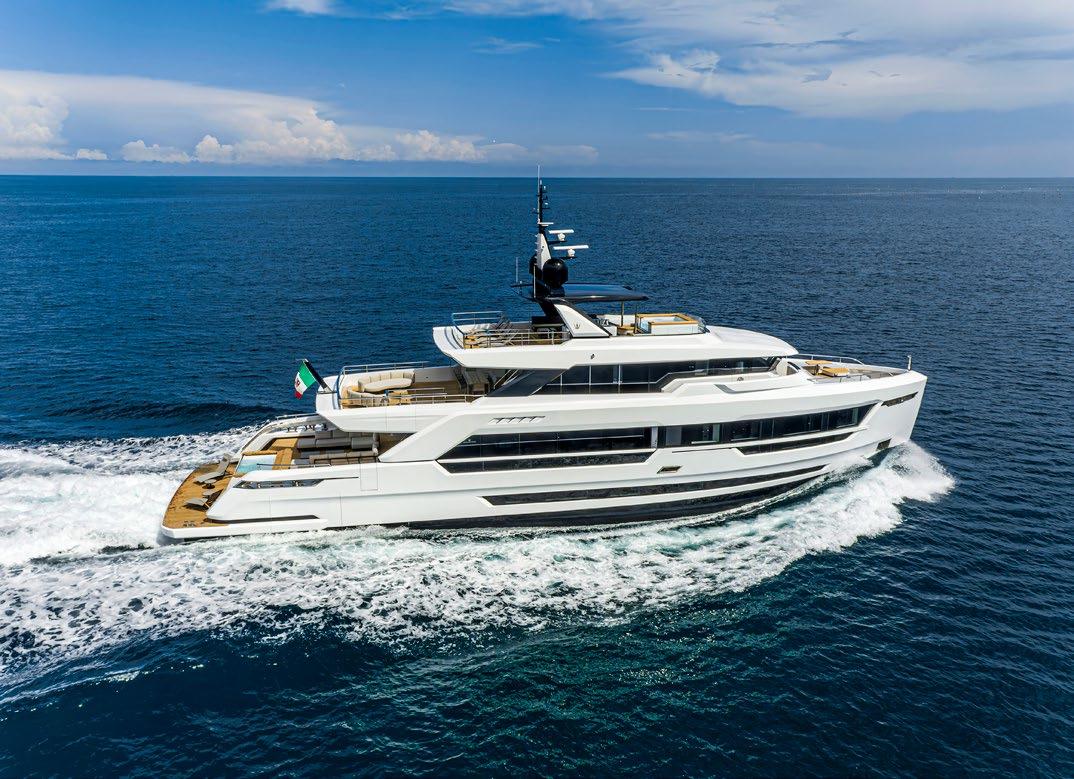


www.reintjes-gears.com
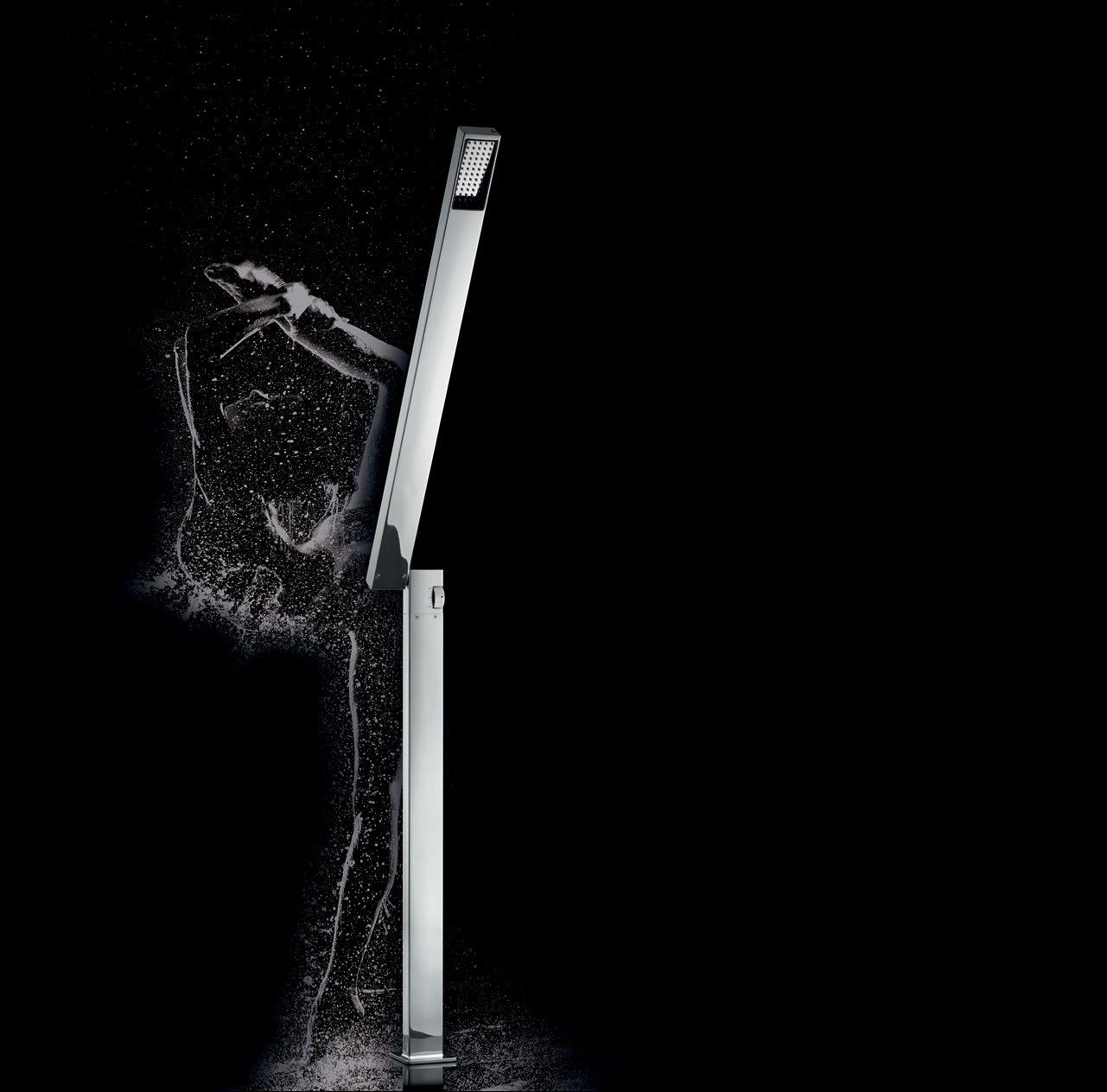
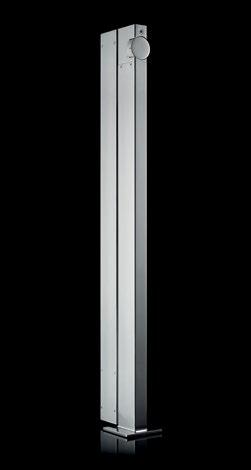


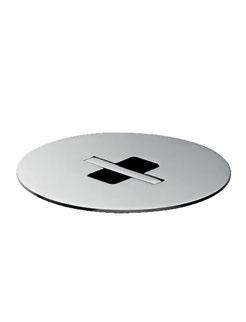

Quick Nautical Equipment, brand of Quick Group, has launched its latest addition – the 140 kilogramme Olympic anchor. Designed and manufactured entirely in Italy, the new model underscores the brand’s focus on super highholding power, innovation and customer-driven development.
The decision to create a 140 kilogramme anchor came directly from client demand. One customer had purchased a 100 kilogramme model and required a larger version for the same yacht. “Given the way we designed the product, scaling up the range was a natural step,” explained Andreas Karlsen, CCO of Quick Group.
Positioned as an upper-range solution, the new model is suited for yachts between 30 and 40 metres with a displacement of up to 170 tonnes.
What sets the Olympic series apart is its blend of engineering precision and robust build. The design prioritises holding power, vital in increasingly demanding anchoring conditions. “Owners want peace of mind when they leave the vessel at rest,” said Karlsen. “The Olympic anchor delivers superior security, ensuring it sets rapidly and holds firmly.”
Unlike conventional cast anchors, the Olympic range is built from welded stainless steel sheets. Both the interior and exterior are welded, creating a structure as strong as a forged piece but with advantages in balance and seabed penetration. In the 140 kilogramme model, additional mass concentrated in the fluke enhances its ability to dig deeply, securing the yacht with greater reliability. The series has obtained the SHHP classification by RINA which testifies the great anchoring efficiency of this series which has a holding power at least double of an HHP anchor.
Manufacturing in Italy also allows Olympic Anchors to maintain tighter quality control and shorter lead times compared to standard cast anchors often produced in the Far East or South America.
The 140 kilogramme model also incorporates features tailored to contemporary yacht design. A shortened shank increases compatibility with modern bow rollers and retractable systems, aligning with the growing trend of concealing anchors within the hull.

An optional Olympic swivel, sold separately, ensures the anchor always returns upright when retracted, preventing chain twist and ensuring smooth operation – a key benefit for yachts with automated systems. Internal cavities help the anchor consistently settle on its fluke side, ensuring reliable setting every time.
The 140 kilogramme anchor crowns a line that begins at just seven kilograms for tenders and smaller craft, extending through 80 and 100 kilogramme models to cover a wide spectrum of vessels.
Launched in 2023, the Olympic range has already delivered several hundred units, with growth expected to accelerate. Quick Group’s global distribution network supports visibility across all major yachting markets. “We are still in the early stages of building the dealer base for this niche product, but the response has been strong from both shipyards and the retrofit market,” Karlsen added.
For Quick Group, the Olympic anchor reflects how yacht equipment can combine technical sophistication with discreet design integration. As anchoring systems become more concealed and safety ever more critical, demand for high-holding anchors that are both reliable and adaptable will only grow.
With its combination of Italian craftsmanship, strength and compatibility with modern systems, the 140 kilogramme model is positioned to meet that need. “Our aim is always to listen to our customers, adapt quickly, and deliver equipment that gives owners and crews confidence,” Karlsen concluded. “The Olympic anchor is very much a product of that philosophy.”
Meet the Quick Group team at Metstrade 2025: info@quickgroup.com Metstrade Quick Group Booth 01.153 | 01.251
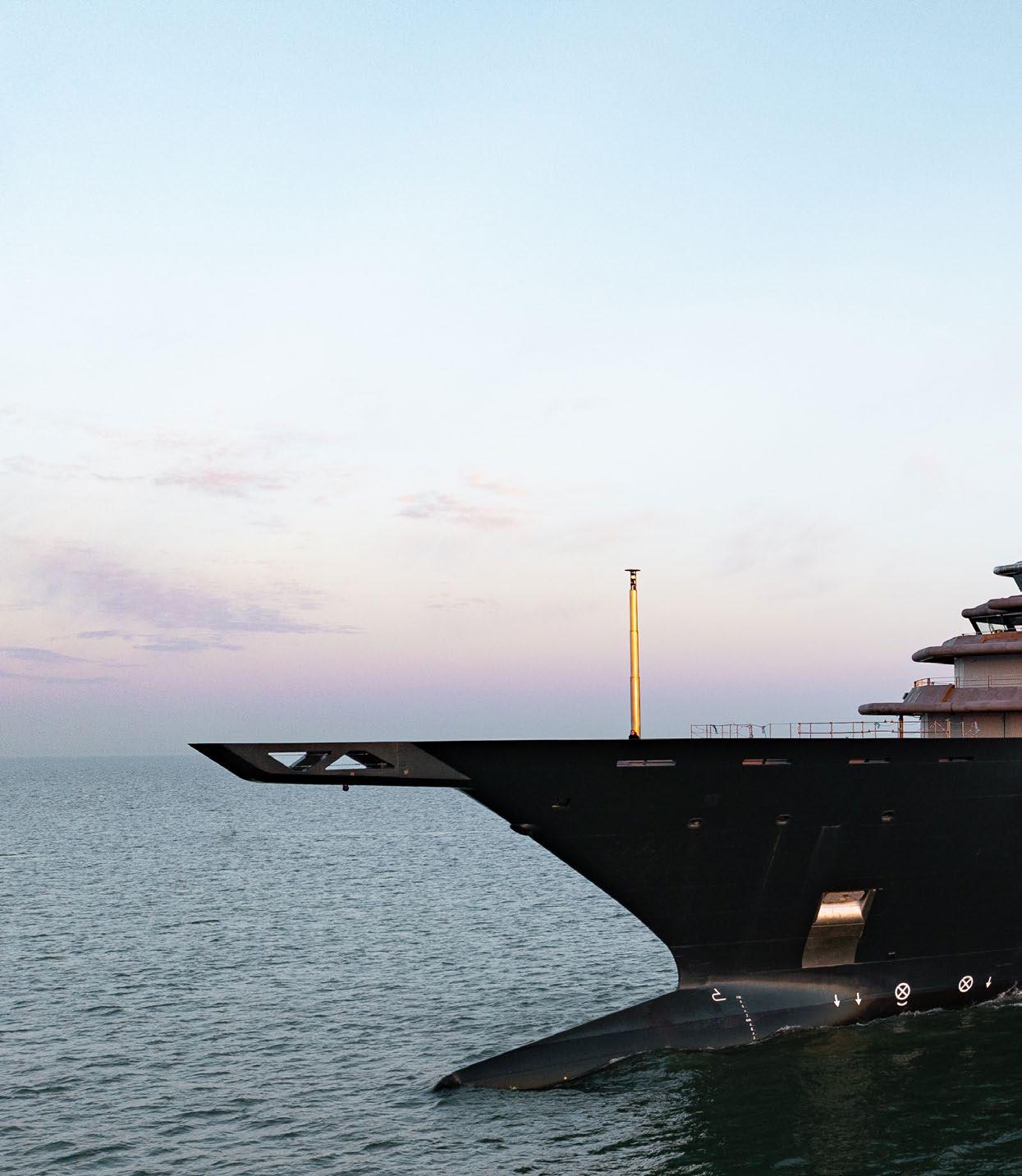

REV Ocean, the brainchild of Norwegian billionaire Kjell Inge Røkke, is a one-of-a-kind project that brings together innovative engineering and cutting-edge technology in a powerful commitment to environmental stewardship. We went aboard the 195-metre research vessel and superyacht earlier this year at the Vard Søviknes shipyard in Norway shortly before she departed for Damen Shiprepair in the Netherlands where final outfitting is taking place.
BY JUSTIN RATCLIFFE
Right: REV Ocean at the Vard facility in Norway. Note the 22-metre hatchway in the hull for access to the main hangar and moonpool.
Facing page, top: The custom Seaonics crane on the aft helideck. Centre: The container deck looking forward.
Bottom, from left: Lawrence Hislop, REV Ocean Communication Director; Eva RamirezLlodra, Science Director; CEO Nina Jensen; Oystein Mikelborg, Operational Director.
Approaching Vard Søviknes by boat on a very cold but sunny winter’s day, the huge bulk of REV Ocean dominates the bay. With the top of her mast almost 40 metres above sea level, she dwarfs a 171-metre cable-laying vessel moored alongside. Built to Polar Class 6 for navigation in medium first-year ice with machinery specified to ICE 1C, REV Ocean will spend most of her time as an oceanic research platform for teams of scientists and conversationists. But she will also function as a unique charter yacht for up 24 guests in the luxuriously appointed forward part of the vessel arranged around a central atrium over five decks with glassencased elevator and suspended staircase. At 19,235 GT she is easily the biggest superyacht in the world.
No one has ever attempted to build such a vessel before. Indeed, REV Ocean’s CEO and marine biologist Nina Jensen admits it’s been “quite a journey” with unexpected hurdles along the way, not least rebuilding the observation lounge in aluminium to remove topweight and extending the hull by 12 metres to meet stability criteria. This in itself was a vast undertaking accomplished by cutting through the hull in front of the container deck at frame 115, adding a new mid-section, and reconnecting the kilometres of piping and cabling. By the time the vessel is delivered next year, she will have been in build for close to a decade.

Despite the unwanted delay, the hull extension proved positive in other ways. The container deck was designed to take containers for storage, or as containerised laboratories in addition to nine dedicated wet and dry science labs, but a new deck hatch now provides direct access to the hangar below that houses all the sub-sea equipment. This means the 30-tonne capacity custom crane by Seaonics on the aft helideck can manoeuvre heavy loads – including whole containers – in and out of the space quickly and efficiently from above rather than the side.
There is also a new CTD (Conductivity, Temperature, Depth) water sampling room, dedicated storage for the submarine, a media editing suite, and a 3D printing lab, which allows the team to make and test new tool solutions or do vital repairs and maintenance out at sea. These are in addition to the preexisting survey control room, conference hall, 36-seat auditorium, executive boardroom, and various offices. There are 400-plus Wi-Fi access points around the vessel.
Tankage for fuel also increased – a major boon according to REV Ocean’s operations director, Øystein Mikelborg, who spent 20 years at the Norwegian Polar Institute taking part in expeditions to the Arctic and Antarctic. “We had a saying that you can never have enough fuel – unless you’re on fire,” he jokes dryly. With a top speed of 16.8 knots, at an economical 12 knots projected range is over 8,000 nautical miles, with almost as much urea for the SCR units to last as long as the fuel. The vessel will be able to remain at sea without refueling or reprovisioning for up to two months.
“I never thought it would be possible to just cut a ship in half, insert a section, and then reassemble it,” says Nina Jensen. “That’s an oversimplification, of course, but the added space has made a significant difference in terms of scientific upgrades and operation. Even though it took time, the 12-metre extension has ultimately resulted in a much better and more capable ship.”


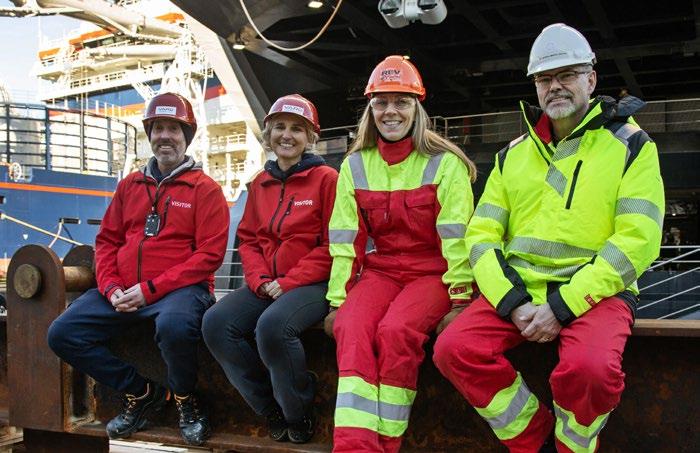
The moonpool in the main hangar for launching and recovering a three-person submersible and a ROV is open to the water at the base of the hull. The entire REV Ocean concept was developed around this space.
“No other research vessel has a trawling system like ours. Trawling is usually a blunt tool, but the fish recognition system collects only what’s necessary for research purposes.”
At the heart of REV Ocean’s capacity for deep-sea exploration is a 7.7m x 5m moonpool in the main hangar. Designed for launching and recovering a three-person submersible and a remotely operated vehicle (ROV), it is open to the water at the base of the hull so passengers can be disembarked inside the vessel and crew aren’t exposed to the elements on deck in high seas or subzero conditions.
Although there is a closing mechanism to prevent excessive water ingress during transit or in rough seas, the moonpool is designed to be always full of water. This required careful design to ensure overall stability – as an opening in the hull, it effectively reduces the amount of water the vessel displaces by several hundred tonnes. Located in the centre of the vessel least prone to rolling and pitching, baffles around its edges absorb wave energy for a relatively calm working environment even in rough seas. A massive hydraulic hatch measuring 22m x 6m on the port side opens the full length and height of the moonpool hangar. Additional handling systems allow the deployment of water sampling systems and coring devices. In addition to the moonpool, five boom cranes handle over-the-side operations.
The set-up is a more sophisticated version of the moonpool aboard Kronprins Håkon, Norway’s largest ice-breaking polar research vessel. Øystein Mikelborg led the construction of the Kronprins Håkon and brought his knowledge into the new vessel, along with additional capabilities that the research ship doesn’t have.
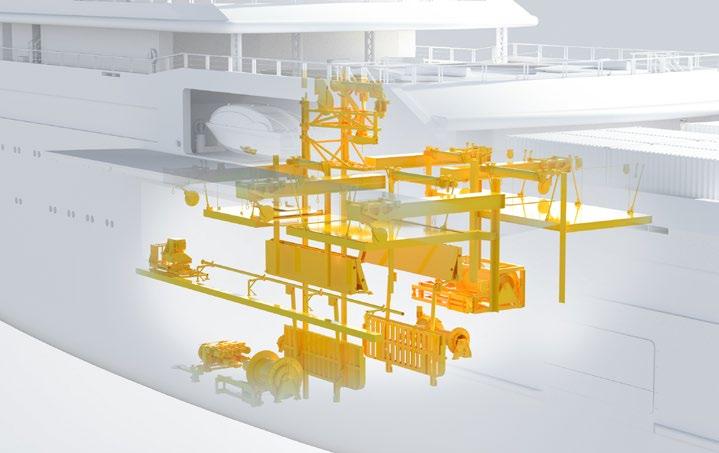
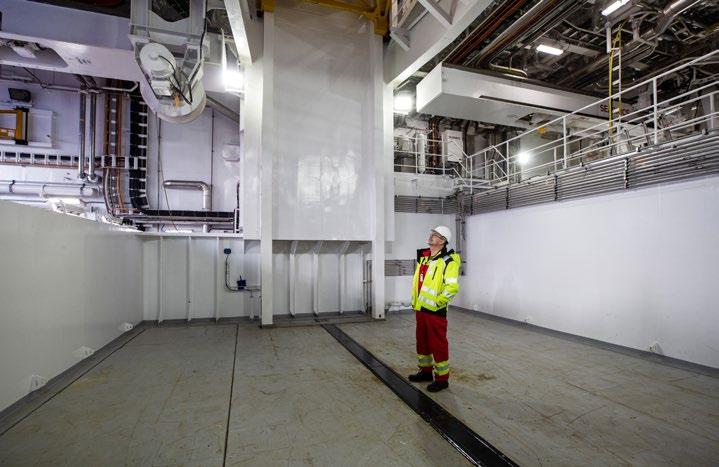
By way of example, Mikelborg points to the trawling gear, which is among the most advanced ever installed on a research vessel and was personally developed by Kjell Inge Røkke, drawing on his knowledge of fishing trawlers (see sidebar). Housed under the helideck in the stern are two 35-tonne winches for 3,000 metres of trawl wires and a massive net storage drum, requiring extensive structural support in the deck.
Trawling is essential for sampling at specific depths, especially 1,000 metres down in the mesopelagic or ‘twilight’ zone, but it can also be destructive. To avoid indiscriminate netting, REV Ocean uses Simrad PX FX sonars and Scantrol software for selectively sampling specific fish species and sizes, which are delivered direct to the main wet lab by a vacuum system.
“No other research vessel has a trawling system like ours,” says Mikelborg. “Trawling is usually a blunt tool, but the fish recognition system collects only what’s necessary for research purposes. It’s basically an ecoharvesting system that releases non-target species back into the ocean unharmed.”
REV Ocean has a diesel-electric propulsion package comprising 4 Wärtsilä generators of 2.7MW each and two 3,200kW Ingeteam electric motors coupled to conventional drive shafts, plus a 3MWh Corvus lithiumion battery pack for peak shaving and silent running under batteries alone for limited periods at two knots during research missions.
“The vessel is built to the IMO’s Safe Return to Port (SRtP) regulations for redundancy of critical systems in the event of accident or damage,” adds Captain Nils Baadnes, who has been involved in the project since metal cutting began at Vard Tulcea in Romania.
“That means we have two separate engine rooms, two ballast systems, two switchboard rooms, two propulsion rooms, an emergency bridge, an emergency galley, duplicate fixed fire-fighting systems, and so on.”
The submersible DSV Aurelia by Triton Submarines is fitted with an array of scientific sensors, tools, cameras, and sampling equipment. With a dry weight of 11,200kg, it is the deepest-diving threeperson acrylic submersible in production, able to reach a depth of 2,300 metres and remain submerged for 10 or more hours (rather unnervingly, the pressure at such depths means the interior volume of the acrylic viewing sphere shrinks by 150 litres).
REV Ocean’s other deep-sea vehicle, ROV Aurora, is a Supporter 6000 manufactured by Kystdesign in Norway. It can accommodate up to 24 hydraulic tooling functions, 16 scientific sensors and 10 camera connectors. It successfully dove the Malloy Deep and the Gakkel Ridge in the Arctic Ocean (3800m), sampling hydrothermal vents for the first time.
Backing up sub ops and other missions is a whole fleet of auxiliary vessels, including a 14-metre work boat built entirely from extremely durable but recyclable polyethylene (PE), two 8.5m work boats, two 6.5m Fast Rescue Craft and four Zodiacs, among others.


Eco-friendly waste management systems are designed to reduce the vessel’s carbon footprint in line with her environmental mission. A pyrolosis incinerator, for example, allows materials – including plastics – to be burned at high temperatures, minimising the release of noxious gases and producing only limited char. This reduces the need to offload plastic waste to shoreside facilities, particularly in countries with limited recycling infrastructure.
There is heat recovery on the Tier III-compliant generators (fitted with both SCR and Diesel Particulate Filters) for feeding back into hot water circuits and HVAC, as well as generating fresh water through an evaporation plant. In addition, a “free cool” system in sea water temperature below 10°C further reduces power demands on the HVAC system.
All the onboard systems are monitored by VARD’s SeaQ Green system, so the crew can run the ship in the ‘cleanest’ way and keep COx, SOx and NOx emissions to a minimum.
Exterior decking throughout will be Tesumo, a composite product derived from sustainably cultivated wood that has the appearance, dimensional stability, weather resistance and natural durability of teak.
Studies have clearly shown the detrimental effects of underwater noise on marine mammals and propellers and REV Ocean has been designed to be as quiet as possible under tough DNV-GL SILENT-R notation. The hypothetical task test for SILENT R notation is to be able to approach a cod fish within 100 metres without being detected. Propellers, rather than engines, tend to be the primary sources of underwater radiated noise. The shape of the hull significantly influences the water flow to the propeller and achieving an optimal inflow is crucial for reducing wake and noise (REV Ocean’s hull was initially tank tested at the Hamburg Ship Model Basin). Instead of electric pods – and despite the vessel’s 46-metre drive shafts – Konsgberg variable pitch propellers designed for seismic research vessels proved the quietest option. These vessels require high thrust to tow the heavy seismic gear and at the same time operate under strict requirements to minimise acoustic emissions. REV Ocean is kitted out with its own hydrophone system, as well as a fixed gondola just behind the bulbous bow is housing sub-bottom profilers and twin multi-beam echosounders for 3D mapping the seabed down to 8,000 metres. Further aft are twin, 16-tonne drop keels equipped with biological echo sounders, sonars and Acoustic Doppler Current Profilers.

Designed by Espen Øino with interior styling by H2 Yacht Design, REV Ocean is privately funded by Kjell Inge Røkke, the majority owner of Aker ASA, a Norwegian industrial investment company listed on the Oslo Stock Exchange. As a teenager, Røkke began working on commercial fishing boats in Alaska and built his fortune through ventures in fishing, seafood, shipping, and offshore industries. REV Ocean began in 2016 when he signed The Giving Pledge, vowing to donate more than 50% of his fortune to philanthropic causes. Delivery is expected in Q1 of 2027. Røkke also spearheads the non-profit foundation HUB Ocean that provides fit-forpurpose ocean data to help decision-makers and industry leaders steer a course to improve ocean health. “Data needs to be available in the most efficient form,” he says. “Today, you will spend the lion’s share of time finding the data, compared to the time you spend actually working on and driving new insight from data.”



"Given this was a first-of-its-kind vessel – a research vessel that also serves as a superyacht – with a unique build strategy, it was always going to be complex."
George Gill has been the project director and owner’s representative for the REV Ocean vessel since the beginning. Having served as chief engineer on Røkke’s previous 66-metre sailing yacht Aglaia, his technical expertise and close collaboration with the owner helped shape the original design brief, which became the cornerstone document to launch the project.
How did REV Ocean get off the ground?
George Gill: I was working on another sailing yacht project for the owner when he called to say he was switching to power. He’d always wanted to build a motorboat and was inspired by the Ulysses projects constructed at the Kleven shipyard. The first two Ulysses demonstrated a different way of building large yachts – one that didn’t rely on the traditional superyacht yards. As a shipyard owner himself, the owner was intrigued by this new approach and saw the potential to innovate beyond the usual channels. I visited the first Ulysses in Barcelona in May 2016 to see the concept firsthand, which had a significant influence on REV Ocean
How did the shipyard selection and development process proceed?
GG: As a Norwegian, the owner wanted to draw attention to the Norwegian maritime cluster on the country’s west coast, so my brief was to utilise Norwegian expertise wherever possible in the project. This meant it became a choice between two Norwegian shipyards: Kleven and Vard. I spent a lot of time working closely with both, developing general arrangements, onboard systems, and features such as the laboratories and the moonpool. Initially, the vessel length was set at 140 metres but quickly increased to 145 metres and beyond. We eventually signed the contract with Vard in March 2017 and metal cutting started at its facility in Tulcea, Romania, in February 2018 with the keel laid in April.
What has been the most complex part of the design and construction process for you as project director and owner’s representative?
GG: It’s difficult to single out one area – there have been many challenges! What I believe
sets this project apart is the build strategy. Normally, a shipyard manages the entire project – timeline, risk, contractors – all for a fixed price. Here, the owner’s team managed all those aspects across multiple suppliers and yards. This approach demands intense risk and schedule management, but it also reduces bottlenecks caused by contractual disputes because we’re not operating under strict delivery deadlines with penalties. We’ve aimed to support this through transparent communication to ensure no one gets caught out, allowing everyone to have their say on the design process and price their work based on full and accurate information.
Looking back, what would you have done differently?
GG: Given this was a first-of-its-kind vessel – a research vessel that also serves as a superyacht – with a unique build strategy, it was always going to be complex. We wanted to balance the number of consultants to ensure that development was swift and avoid getting bogged down in dialogue. But in hindsight I would have put more safeguards in place, especially during the early planning stages. That’s on me. More contingency measures and risk management protocols to handle the unprecedented scope and complexity would have helped smooth the process. Ultimately, however, this is a unique project and some lessons can only be learned by doing.

systems
Bottom: The dieselelectric drive has a 3MWh battery bank for peak shaving and silent running at slow speed.
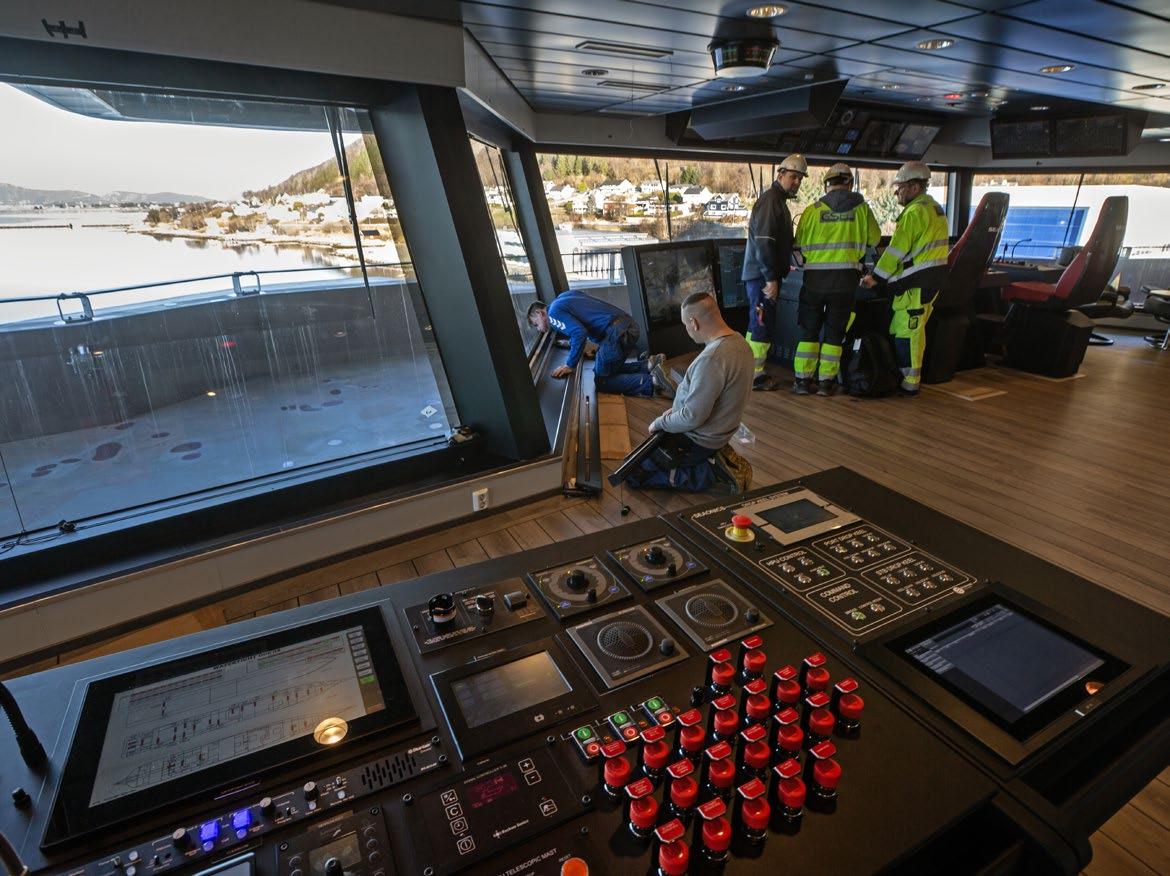

When completed, REV Ocean will offer the potential for significant discoveries in marine biology, oceanography, and environmental science. Despite her hightech, research-oriented mission, the fact she will also carry fee-paying guests as a commercial superyacht reflects a growing awareness of the importance of the oceans to the planet’s health.
“This ship is unique and building something so complex takes time,” concludes Jensen.
“Despite the delays, our team has stuck with the project because we believe in the vision. It’s been tough at times, but the wait will be worth it.”


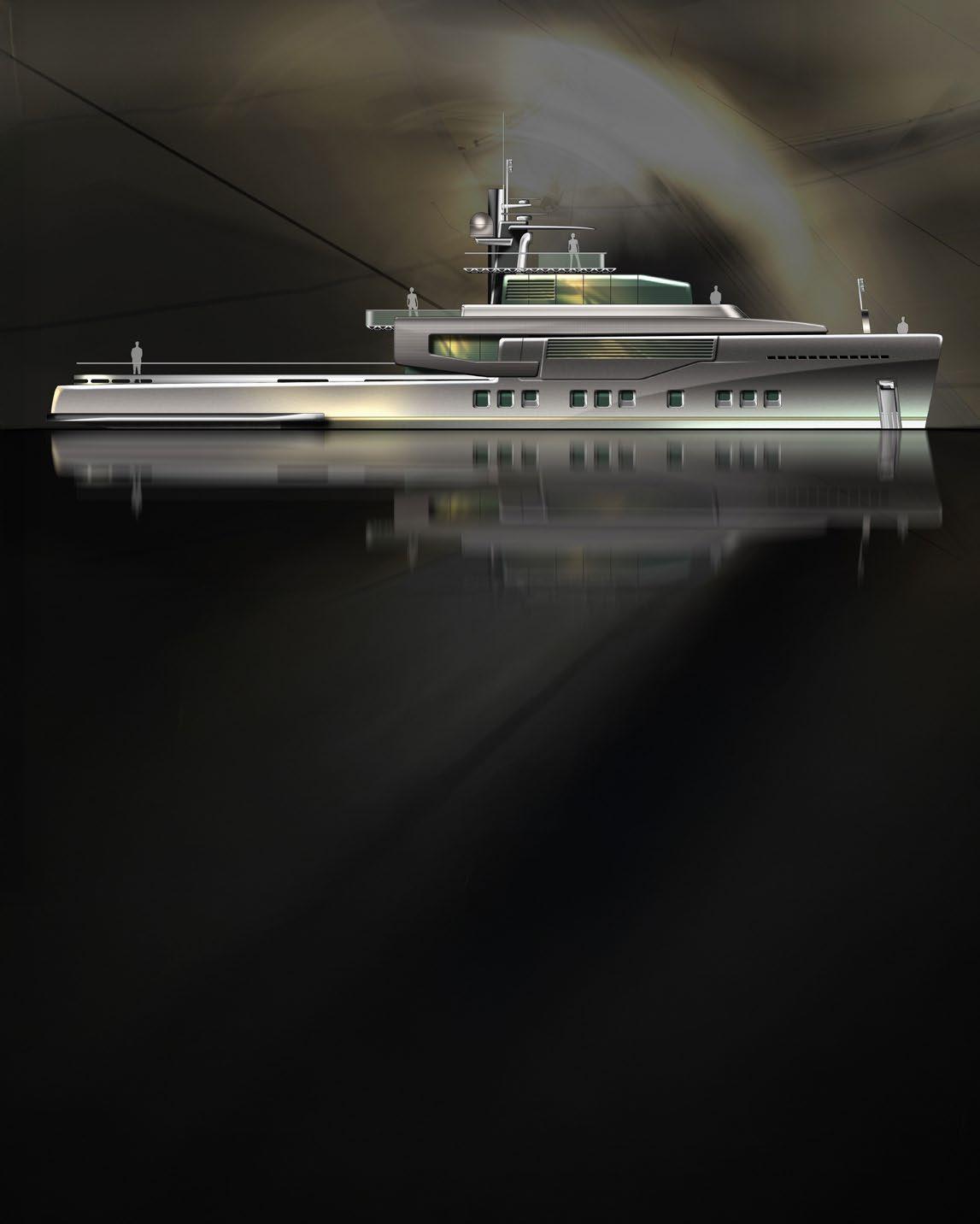
A billionaire venture capitalist, a Canadian naval architect, and a British superyacht designer – this was the cast of players behind Neonemo, an avantgarde yacht concept dating back to 2008 that in terms of aesthetics and technical design is still ahead of its time.
BY JUSTIN RATCLIFFE
It was early summer 2008 and Canadian naval architect Patrick Bray was on his way to the airport when he received an unexpected phone call from Ken Freivokh. The UK-based designer explained he was working on a new project with Tom Perkins, the owner of Maltese Falcon, who wanted to meet him. A meeting eventually took place aboard the classic motoryacht Atlantide, also owned by Perkins, in Vancouver’s Coal Harbour.
“It turned out Perkins wanted to build an exploration yacht to carry his two-person submarine,” recalls Bray. “Over the next month or so and several discussions later, the various responsibilities were agreed upon and Perkins signed a design agreement with us in July 2008. Basically, we would handle the naval architecture and Ken the exterior and interior design. I remember he liked the idea that the time difference between Ken and I meant that someone would always be working on his project!”
The sub in question was a winged Deep Flight Super Falcon manufactured by California-based Hawkes Ocean Technologies. Perkins bought the very first 6.7-metre Super Falcon model that could dive to a depth of 120 metres and remain underwater for about four hours on a single battery charge.




“For a while Tom kept the sub on the deck of Maltese Falcon, which was never designed for the purpose.”
The following September another meeting took place, this time aboard Maltese Falcon in San Francisco. The idea was that Bray could meet the crew, including the then captain Justin Christou, to get a better idea of Perkin’s preferences and how he would use the vessel. From these meetings several key criteria for an all-aluminium vessel emerged, including massive storage space for the sub and auxiliary craft; a floating rotodock system; a heavy-duty deck crane able to swivel though 360 degrees; a machine workshop; fixtures for a possible towing kite; controllable pitch propellers; 10 knots cruising and 16 knots top speed, as well as advanced appendages for fuel saving. The preference was to build in North America and Perkins was in talks with fellow billionaire and superyacht owner Dennis Washington, whose family holding included the commercial Seaspan shipyard in Vancouver.
“For a while Tom kept the sub on the deck of Maltese Falcon , which was never designed for the purpose, so the whole concept was meant to give him the freedom to explore the world in a way that was both functional and comfortable, with the submersible taking centre stage,” says Ken Freivokh. “The design challenge was balancing function with style, ensuring that the yacht could carry all of Tom’s equipment for his adventures, while also providing the comfort and performance expected of a luxury yacht.”

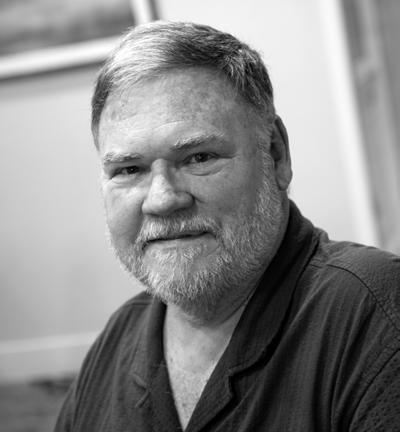
Based on space planning and payloads, a vessel with an overall length of 42 metres emerged and was dubbed Neonemo Freivokh’s exterior lines were rugged and stylish, but not overly polished and had a subtle retro twist. Penned at a time when the ‘crossover’ trend was still to emerge, they still look fresh today.
The layout offered accommodation for 10 guests in four lower deck cabins and an owner’s suite on bridge deck. The main deck comprised the saloon, galley and crew quarters forward with direct access to the crew mess, laundry and store rooms on the deck below. An observation deck was included for extended visibility when navigating unknown waters. But the raison d'être for a vessel designed for adventure was the expansive main deck aft with its two hydraulic hatches that covered a large garage below for housing the submersible and a large tender that could also serve as surface support during sub ops.
Meanwhile, Bray was working on the hull form. At the time he was researching the benefits of fixed midship and stern bulbs to reduce resistance. Like a bulbous bow, these hull appendages or blisters modify the overall wave train through their own small wave and pressure patterns, and it is this interaction that can reduce the overall resistance. The consequent reductions in power and fuel consumption allow for further reduction in vessel weight. Furthermore, by influencing the wake field around the propeller, stern bulbs can improve propeller efficiency and reduce vibrations.
“Being the kind of person he was, Perkins was intrigued by the science and the plan was to tank test the hull we’d developed for him,” says Bray. “Sadly, before that could happen the project was cancelled when he was diagnosed with cancer – he felt he couldn’t afford the time it would take to design and build a yacht from scratch.”
Instead, Perkins converted a 37-metre Japanese fisheries vessel his carry his submersible. He embarked on several South Pacific expeditions with Dr. No before selling the yacht shortly before his death in 2016.
“Being the kind of person he was, Perkins was intrigued by the science and the plan was to tank test the hull we’d developed for him.”
But the Neonemo story – and Bray’s research – did not stop there. At the 2016 Monaco Yacht Show, Rossinavi and Freivokh presented the Argo 48M explorer concept. Apart from being six metres longer, the renders revealed a carbon copy of Neonemo, right down to the Deep Flight Super Falcon sub sitting on deck. In addition to the original shaft-line propulsion, a diesel-electric version was also proposed.
“After Tom Perkins passed away, we thought the concept project should not be buried in the drawers of the design office,” said Scandinavian Marine, project developer for the Argo 48M at the time. “We agreed with Ken that a reassessment of TP’s mission by growing the original project size to a 499 GT volume should better allow the realisation of some of the latest energy-friendly technologies, while keeping the operational cost of this yacht under a well-balanced canopy.”
Right, from top: Bray’s CFD analyses and tank tests of a 45-metre hull form with bulbous bow, as well as side and stern bulbs, showed significantly less resistance than an un-appendaged hull.
Bottom: Neonemo’s underwater profile superimposed on Freivokh’s original render.. Note the ‘blister’ amidships.



“After Tom Perkins passed away, we thought the concept project should not be buried in the drawers of the design office.”
Weirdly, no mention was made of Bray’s “energy-friendly” hull bulbs, which he had developed further through a series of research programs. The first was an in-water scale model of a 45-metre hull at the ITU Ata Nutku Ship Model Testing Laboratory in Istanbul. After the tests, Associate Professor Emin Korkut, Superintendent of the University Faculty of Naval Architecture and Ocean Engineering, congratulated Bray on the results: “I should tell you that your hull form has been one of the best forms tested recently in our towing tank,” he wrote. This was followed up with a computational fluid dynamics program, and a third more extensive CFD program at the National Research Council of Canada’s Ocean, Coastal and River Engineering Research Centre (OCRE). The un-appendaged hull in these CFD analyses revealed 23–26 per cent more resistance over a range of 12–20 knots.
“That’s a difference of over 1,100 horsepower at 20 knots,” Bray points out. “This is really significant and translates into considerable fuel savings, as well as a much lower carbon footprint, flatter wave train, and lower underwater noise signature. For electric propulsion, it also means smaller electric motors and less draw on the battery system.”



Last year, Bray unveiled the Bahamas Explorer, a 34.3-metre concept designed for long-range expeditions that draws on his years of research and development into fuelsaving appendages. By including a bow bulb, midship bulb, and stern bulb, the Bahamas Explorer could reduce fuel consumption by 25 percent, meaning smaller fuel tanks and engines to achieve its top speed of 18 knots and 6,000 nautical mile range at 12 knots. In the conclusion to his latest research, Bray wrote: “We feel there are numerous ship applications – including yachts – for these appendages in reducing consumption of fossil fuels and the impact of vessel wake on shorelines, as well as reducing the quantities of raw materials required to construct these more efficient and therefore lighter weight vessels.”
Although the results of Bray’s studies have been published, it remains a mystery why no shipyard to date has picked up on his findings, which promise significant advantages using inexpensive, low-tech, low-maintenance solutions. Similarly, and sadly, one of the coolest concepts of its kind remains “buried in the drawers” of Freivokh’s design office.

BY LEONA CAANEN
For more than 25 years, SuperYacht Spares (SYS) has gone beyond traditional yacht provisioning, acting not as a supplier but as a dedicated service provider — an extension of your team. Each year, SYS equips over 20 newbuild projects (50m and above) and supports more than 450 operational yachts around the globe, ensuring they perform flawlessly from day one and throughout their lifetime. Their mission is simple yet ambitious: “We are here to ensure you never need to compromise on the pleasure of yachting.”
From the first drawing of a new build to the daily operations of an established yacht, SYS provides seamless support. Each project is guided by a personalised dedicated team of specialists who assist you from start to finish, regularly visiting the yard, working alongside your crew, and ensuring every system and detail on board runs flawlessly.
SYS doesn’t just deliver equipment; they deliver confidence. With hands-on expertise and clear communication, their team becomes part of yours, anticipating needs before they arise and ensuring every challenge is met with precision and care.
SYS has developed a unique data-driven approach that brings structure and clarity to even the most complex projects. Every yacht SYS supports is backed by a custom digital inventory, allowing full transparency and control.
SYS collects data of installed equipment on board, analysing which spare parts are most relevant for your yacht. This information is then integrated into your Yacht Management System (YMS), making ordering and tracking spare parts and maintenance effortless throughout the yacht’s lifetime. This approach enables them to provide a 100 percent right guarantee on all supplied items.
Each item is categorised and documented within your personalised database providing full insight into your onboard inventory, ensuring accuracy, and reducing waste. With this structured approach, SYS guarantees the fastest and most reliable service possible.
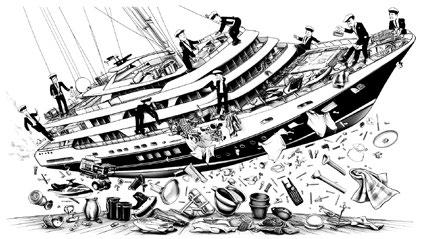
SYS’ streamlined process ensures every stage of delivery is handled with care. Their scope of supply consists of any item that will fall out of the yacht if you turn her upside down. Their service consists of, but is not limited to:
– Budgeting: With decades of experience, SYS provides fast, precise quotations for all provisioning needs.
– VAT Consultancy: An in-house VAT specialist helps identify the best approach for VAT-free yacht supplies, providing guidance on complex or nonstandard issues.
– Warehousing: Clients can choose whether items are delivered directly to the yard or stored at SYS’ strategically located warehouse in Gorinchem, just an hour from most major Dutch shipyards.
– Onboard storage: SYS uses standardised Rako or Zarges containers, making every onboard system future-proof and fully integrated.
– Logistics: Once operational clients are supported with advice on scheduled transports throughout the season as well as rush shipments in case of an emergency.
Thanks to standardised procedures and synchronised data, SYS ensures seamless integration with your yacht management software. This makes importing information simple, maintaining up-to-date overviews, and enabling quick reorders of spares or replacement items anywhere in the world.
Even in times when global logistics are challenged, SYS’ extensive client databases spanning over 1000 yachts worldwide allows them to locate and collect unavailable parts swiftly.
Not only owners, but also renowned shipyards such as OceAnco and Damen Yachting rely on SYS’s services to support their clients in the best possible way.
Whether it’s managing your entire inventory or solving a last-minute delivery, SYS’ work ethic remains constant: reliability, precision, and service beyond expectation Where others stop, SuperYacht Spares keeps going: the extra nautical mile.
The 2025 edition of the world’s largest B2B exhibition for the leisure marine sector is set to be the biggest yet. Since its launch in 1988, Metstrade has been an invaluable platform for showcasing industry developments and innovations across the marine business. The Superyacht Pavilion – now known as the Superyacht Zone – remains a key highlight, presenting a wide range of products, services, and solutions from international brands that cater to the evolving needs of the industry.
BY GEMMA HARRIS


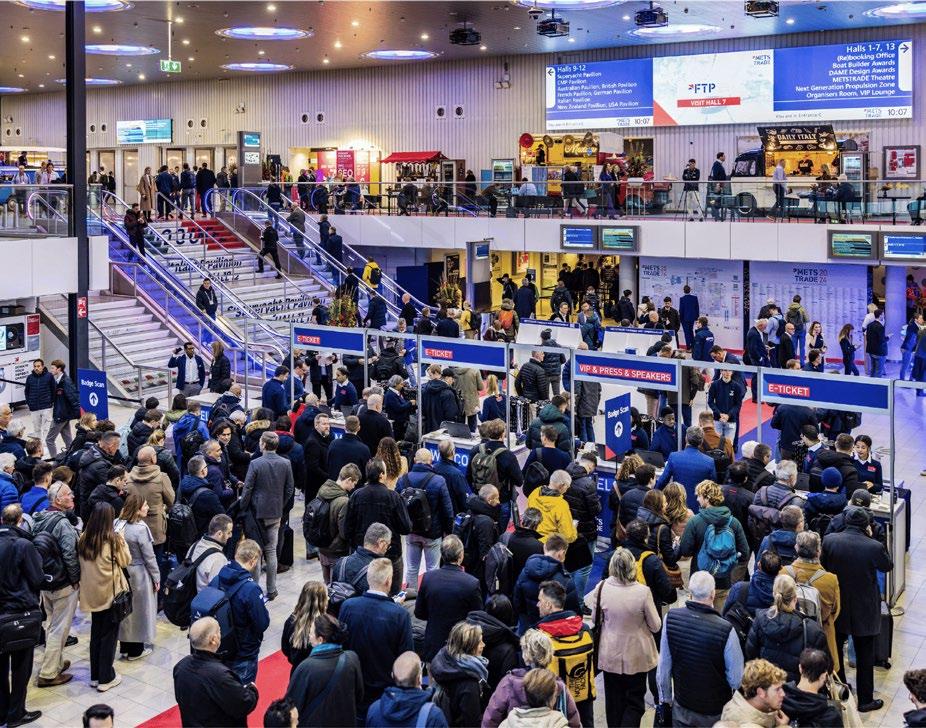
Back in 2025 and bigger than ever before, for the first time in the show's history Metstrade will take over the entire RAI Amsterdam Convention Centre from 18-20 November. Over 1,600 exhibitors from more than 135 countries will present their latest products and innovations. Visitors will be able to navigate the extended exhibition via a new 'round the world' layout, designed as a continuous loop, complemented by an intuitive colour-coded system for easier exploration.
The expansion has resulted in a larger area dedicated to the superyacht sector, with several new additions and enhancements to the Superyacht Zone, allocated to Halls 8, 9, and 10. New for 2025 are the Refit clusters in Hall 8, where players such as MB92, Pendennis, Damen, and Lürssen will feature developments and capabilities in the refit space.
Adjacent to Hall 8 is Harbour 8, a new, purpose-built hospitality space, featuring a high-end restaurant and event venue. This year, the Boat Builder Awards will also be relocated here. Continuing with the theme of networking, the organisers have also
launched a Captain's Club. Acknowledging the lack of opportunity for captains to connect and share knowledge, Metstrade has organised networking events and educational workshops through this Club.
The new business sector has played a significant role in the show's latest editions, and this year, the start-up community returns with two dedicated zones, including one specifically tailored to the superyacht sector.
This year's edition isn't just about physical enhancements, but also marks a fresh era for Metstrade's identity. The show has rebranded with a new logo, simplified colour palette, and a new tagline: "Propelling growth. Harbouring Innovation." In addition, the organisers have also arranged a Metstrade Eurostar carriage for those travelling from London to Amsterdam on Monday, 17 November.
Bigger and better with fresh networking opportunities and renewed brand vision, we take a look at just some of the companies and their products to watch out for at the 37th edition of the show.
Organised by RAI Amsterdam in partnership with ICOMIA, Metstrade is the world’s largest trade show for the global leisure marine industry, bringing together yacht builders, naval architects, refit specialists, distributors, and marine equipment manufacturers.

Sliding Stairs Access Hatch
Akerboom, the Dutch manufacturer of custom-built yacht equipment, will be showcasing some recent innovations at Metstrade, including its Sliding Stairs Access Hatch – an advancement that combines modular engineering with elegant design.
Based on a client request to optimise the passage from main deck to the beach platform on Feadship’s 79.5-metre Valor, Akerboom combined its door, hatch, and boarding equipment components to develop a brand new solution. Essentially the staircases retract into the beach club ceiling as part of the hatch on each side of the pool. They are part of the watertight boundary of the vessel and certified by Class. By using a housing in which the staircase is stored in the open position, the item is also suitable as a plug-and-play concept.
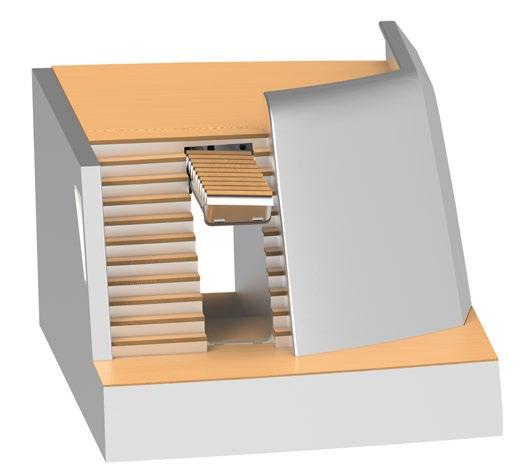
“This marked a next step in modular engineering for Akerboom,” says Mervyn van de Ploeg, MD of Akerboom. “Our approach not only accelerated the development process but also showed how modularity enables flexible, cross-disciplinary solutions without compromising quality.“
Updated new build paints
After celebrating its 20th anniversary last year, this year ALEXSEAL will be exhibiting its new HS Prime Coat 435, a high-solids primer designed to optimise the new-build painting process.
Traditionally, the first layer of topcoat is sacrificed to reveal imperfections in the primer stage, but the HS Prime Coat 435 eliminates this by providing a finish that makes the smallest surface flaws visible before the final topcoat is applied. With strong hiding power at a dry film thickness of 50µm, the product ensures faster drying, higher stability, and easier sanding compared to conventional epoxy primers. Its high-solids formulation also reduces VOC emissions and shrinkage.
Also on show is the company’s Colour Configurator, a new digital tool launched earlier this year to support shipyards and owners in selecting paint schemes. The platform visualises ALEXSEAL’s palette across hulls, superstructures, and bootstripes, giving users the chance to preview combinations before application.

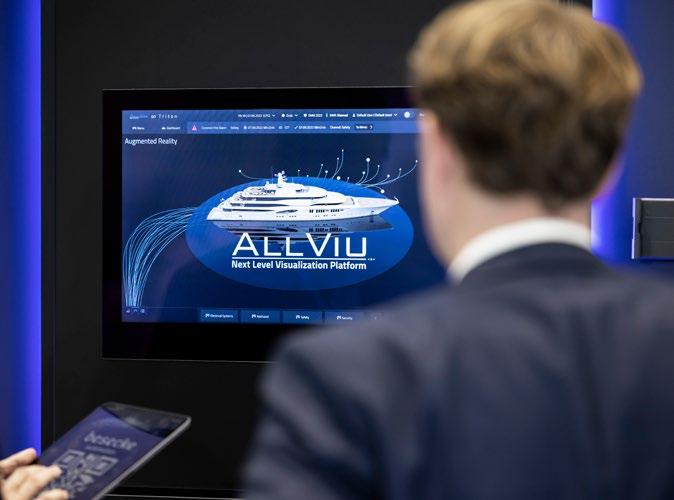
Updated intuitive tools
Besecke, known for its smart automation systems, will present the latest version of its AllViu V4 platform solution. The refined version will power both the beVISION alarm, monitoring, and control system and the beSECUR security suite, which integrates door access control, CCTV, and intrusion detection.
Following a successful factory-acceptable test for its pilot project, Besecke confirms commissioning of a 100-metre-plus yacht equipped with the platform is scheduled for completion by the end of the year.
New features in AllViu V4 include a level of detail zoom function, similar to Google Maps, allowing crew to manage growing system complexity more intuitively, and a Widget Concept with an integrated mimic editor, enabling users to create custom pages via a simple drag and drop interface. Visitors of the show can explore these innovations hands-on at Besecke’s demo console.
Recovering energy, reducing emissions
CMC Marine, specialist in electrically operated stabilisation, thrusters and steering systems, returns with its latest innovations in stabilisation and motion control, designed to support the industry shift toward electrification.
The company’s new Energy Recovery System will be introduced, inspired by Formula 1’s KERS technology, capturing energy generated when fin stabilisers act as a brakes and reusing it during acceleration. This reduces generator power peaks and cuts overall power consumption by up to 30%, while maintaining stabilisation even at zero speed. With lower noise, vibration, and emissions, the system enables fins to operate efficiently with a single generator. Also debuting is CMC Marine’s new DC HiVoltage configuration. Ideal for hybrid yachts or those equipped with battery packs and DC buses, allowing CMC Marine stabilizers and thrusters to run on high-voltage DC power. It positions the Stabilis Electra – the first electric stabilising fin patented by CMC Marine in Europe – as the industry’s first stabilisation system fully compatible with high-voltage DC bus technology.

Multi-source entertainment
Crestron returns to the show with a portfolio of nextgeneration control solutions. Highlights include the Cameo 2 Keypads with a bezel-less design, customisable RGB backlit icons, and over 130 layout options for intuitive lighting, shading and scene control across the yacht. Engineered for global compatibility and advanced dimming without a neutral wire, they are well-suited to yachts cruising global waters.
Also being presented is the Horizon Metal Keypads, crafted in finishes such as Brushed Brass and Dark Nickel, offering modular flexibility and premium engraving. The Cero Mini Remote extends handheld control with a luxurious metal and glass finish, customisable touch zones and wireless charging. For AV-rich onboard environments, DM NVX Multiview enables simultaneous display of up to six sources on a single screen, ideal for social and entertainment spaces.
“We’re excited to attend Metstrade, where we’ll debut a suite of innovative solutions,” says Daniel Kerkhof, director, Crestron Marine.
“From elegant, design-forward control interfaces to immersive, multi-source content viewing, these technologies deliver the perfect blend of performance, flexibility, and luxury,”



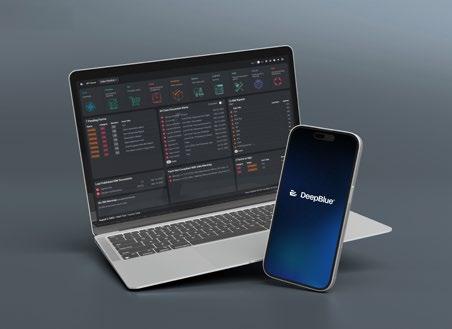
Real-time operational insights
Known for building modular yacht management systems, Deep Blue will exhibit its newly launched Forms Module. A tool designed to transform operational paperwork into actionable, auditable data, fully integrated across safety, compliance, crew, and maintenance workflows. From pre-departure checklists and safety drills to familiarisation sheets and inspection reports, each form is instantly verifiable, timestamped, signed, and stored where it belongs within Deep Blue’s system. Rather than functioning as a standalone filing cabinet, completed forms automatically link to relevant modules such as PMS, HRM, and ISM/ISPS. Safety drills feed into SMS audits, familiarisation forms update crew records, and inspection logs inform engineering maintenance. For Designated Persons Ashore (DPAs), this turns the Safety Management System into a live, fully digital workflow, replacing static PDF trails.
“It’s not just about making forms digital. It’s about creating a living proof of responsibility, where every drill, walkthrough, and checklist becomes traceable and auditable without adding complexity, explains Maks Obelser, compliance project lead at Deep Blue.

This year’s Metstrade will be the biggest edition to date with new halls, enriching additional events, over 1,600 exhibitors to meet, and an improved layout.
The expanded Superyacht Zone is the gateway for the superyacht industry, spotlighting luxury solutions, advanced innovations, cutting-edge technologies, and refit capabilities. Experience exclusive insights at the new Superyacht Stage, unparalleled networking at the prestigious Captains’ Club, and exceptional fine dining at the new “Harbour 8” restaurant.
Enhance your journey by attending The Superyacht Forum , where industry leaders shape the future of superyachting. Secure your tickets now
17 → 18 November 2025 The Superyacht Forum
18 → 20 November 2025 Metstrade RAI Amsterdam
From foundry to finishing
Each year Foresti & Suardi, the Italian company managed by three generations of the same family specialising in design accessories and lighting for the nautical sector, presents several new products, all produced fully in-house from foundry to finishing. Based in Predore on Lake Iseo, the company began in 1961 as a supplier to the Riva shipyard.

This year among the new arrivals is a square-shaped door handle design cast in brass with finishes that be personalised according to individual needs; a recessed spotlight fixture for interior use in galvanically treated brass and anodised aluminium; and a shower stall closure system combining technical precision with a compact profile and rotary locking mechanism compatible with glass panels of varying thicknesses.
Another intriguing innovation is the Tolomeo series of customisable vertical rails with accessories for bedside LED lights and utilities management available with on/off controls of your choice.
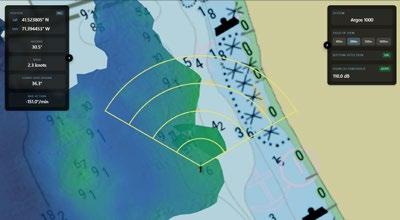
Redefining navigation systems
FarSounder will introduce a series of developments all designed to improve its user experience for bridge personnel. The company will present its new user interface. A versatile app powered by FarSounder’s current software, the interface comes with updated visuals and compatibility across tablets, PCs, and ECDIS browsers. The integrated 3D environment combines charts, aerial imagery, sonar, AIS, and ARPA overlays, delivering a cleaner way to interpret navigation data.
In addition, the interface now offers SEA.AI integration, meaning targets detected by SEA. AI cameras will appear directly on the display. The integration provides situational awareness by merging optical and sonar detections into a single live view, showing what lies ahead, above, and below the waterline.
This year, FarSounder will also announce a new partnership with Anschutz, integrating its Argos 3D Forward Looking Sonar into the SYNAPSIS ECDIS NX platform. “This collaboration is a natural fit as we are both committed to enhancing navigation safety and possess complementary technologies,” says Matthew Zimmerman, founder and CEO of FarSounder. “This integration is a result of our shared goal to invest in innovations shaping the future of marine navigation.”
Streamlining superyacht finances
IDEA Data Solutions will present its new Finance Module within the IDEA YACHT and IDEA FLEET platforms, designed to simplify and centralise yacht financial management. Purpose-built for superyacht operations, the module enables crews, managers, and owners to consolidate and track invoices, transactions, and budgets within a single, intuitive interface, aiming to reduce errors, save time, and enhance oversight.
Fully integrated with IDEA YACHT, the module aligns financial data with operational activities through its Finance Accounts feature, which manages both internal accounts and external provider integrations. Tools for budget creation, transaction categorisation, and recipient management provide clearer insight.
“With the launch of our new Finance Module, IDEA continues to redefine yacht management by delivering smarter, more connected financial oversight, all in one platform,” says Christian Mühle, managing director, IDEA Data Solutions. “Designed specifically for the complexities of superyacht operations, this module empowers crews, managers, and owners to make faster, more informed decisions-saving time, reducing errors, and enhancing transparency across the board.”

17 - 18 November 2025
RAI Amsterdam

This year’s theme “NXT” champions innovation and responsible growth. It serves as a powerful call to action for the industry to embrace adaptation in a rapidly changing world and foster future generations.
Learn from industry experts and actively contribute to visionary content sessions on digitisation, regenerative sustainability, humanitarian work, operational excellence, superyacht standards, crew welfare and training, and more.
Take this chance to discover fresh ideas and expand your network –including at Metstrade’s prestigious Captains’ Club and brand-new refit clusters at the Superyacht Zone.
Get your ticket now and navigate the next generation with confidence.
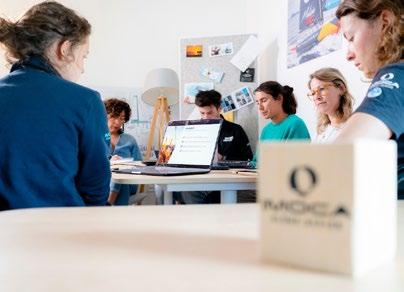

Smarter remote medicine
MedAire is set to launch its VitalStream this year, a next-generation medical monitoring device designed to support first responders and enhance MedAire’s remote control onboard. Available exclusively to the superyacht market, the device uses discreet, lightweight wearables to capture and transmit more than 20 real-time sign parameters, including continuous blood pressure, 12-lead ECG, heart rate, respiratory rate, SpO2, body temperature, and hemodynamics.
Data is streamed via a secure cloud-based application directly to MedAire’s doctors, enabling accurate diagnosis, ongoing monitoring, and betterinformed decision making - helping overcome the limitations of unstable communications and nonmedical descriptions. The lightweight wearable can be applied in just 60 seconds and requires minimal training, making it well-suited for the crew.
“Being able to receive real-time vital signs data from a patient can make a huge difference as it enables more accurate diagnoses, ongoing monitoring and informed clinical decision-making, ultimately leading to improved patient outcomes,” says Dr. Mara Mattioli, medical director, Luxury Yachts.
The VitalStream will be integrated with the newly launched MedAire app, with VoIP capability, enabling crew to connect with MedAire for any medical or mental health concerns.
Hands-on workshops
Created by Marine Future and Foxall Munro, the new Marine Impact Lab platform will be making its debut at the show this year on 17 November. Limited to just 100 participants, the Lab is a one-day, hands-on experience that brings together sustainability leads, designers, engineers, marketers, and commercial decision-makers from across the industry.
The Lab will offer two specialist pathways, designed for real-world roles and challenges, each comprising four structured sessions supported by experts and case-based learning. Led by Marine Future, the Product Track explores Life Cycle Assessment (LCA), sustainable design, efficiency, and end-of-life planning.
Marine Futures director Ollie Taylor says: “Superyacht builders and designers are increasingly finding that sustainability is about more than compliance, it’s about creating a competitive advantage and developing a product your future customers want to buy.
The Marine Impact Lab gives teams the practical frameworks to turn environmental considerations into cost savings, operational efficiencies, and market differentiation that their clients value.”
The Organisation Track delivered by Foxall Munro equips teams with tools for carbon reporting, stakeholder engagement, governance, and embedding sustainability across all operations.
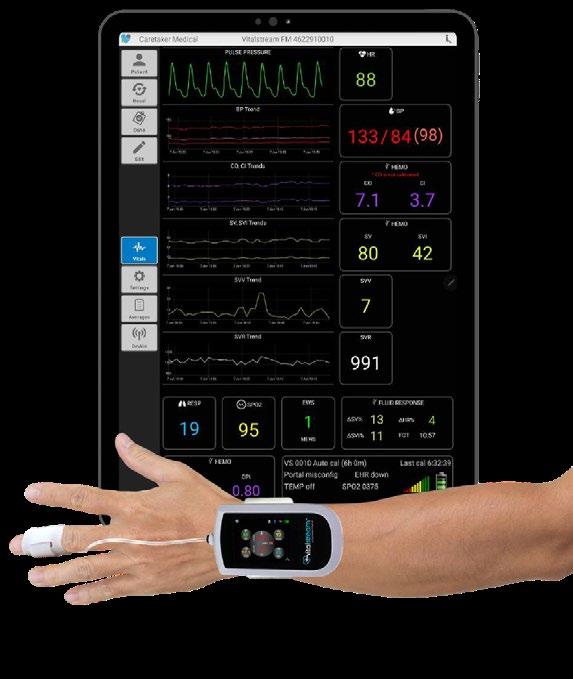
Circadian lighting
Circadian lighting is about aligning artificial illumination with the body’s internal 24-hour clock. Human-centric lighting (HCL) systems do this by varying both colour temperature and intensity throughout the day. But HCL is not just about colour temperature; it’s also about spectral fidelity, flicker control, and CRI (colour rendering index). Truly circadian-supportive lighting delivers high CRI (ideally 95+), flicker-free performance, and a balanced spectral output that respects human biology.

These are the standards that UKbased systems integrator MP Tech has adopted when designing and commissioning lighting schemes for yachts, with a focus on ensuring biological alignment without compromising visual quality. For crew, this means supporting shift-work without compromising health. For guests, it means enhancing comfort, reducing jet lag, and creating spaces that feel intuitively “right”, whether waking up in the Med or winding down in the Caribbean.
“As understanding of circadian biology continues to evolve, so too does lighting technology,” says Michael Meeneghan, MP Tech founder. “We are now exploring full-spectrum lighting profiles that better simulate sunrise, midday and dusk; the integration of near-infrared (IR) and UV elements for skin stimulation and environmental hygiene; and wearable data integration to adapt lighting in real time based on user chronotype or sleep cycles.”
Lightweight boarding solutions
Multiplex will be displaying its new Multistep. A lightweight, height-adjustable solution designed to make boarding a yacht safer and more comfortable. Constructed from carbon fibre, the multistep boasts an ultralightweight build (15-20 kg) and is available in 50 cm or 60 cm widths.
The Multistep has a 250-kg safe working load, is quick to set up, angle-adaptable, and self-aligning to ensure rapid and precise positioning for the gangway and dock, eliminating risks associated with uneven tide levels and quay designs. Additionally, the hinged stanchions enable flexible placement. For safety, the steps are available with anti-slip surfaces for maximum grip or teak treads for added aesthetic appeal.

Future-proofing yacht lighting
OceanLED will showcase the industry’s first-of-itskind upgrade kits for superyacht underwater lighting systems. With this new ‘F-Series to E8 upgrade kit’, a yacht can upgrade its existing underwater lighting system to a modern one.
“With so much to consider during refit, from budget and location to workflow and preparations, anything to streamline the process is a big deal,” says Giles Truscott, group sales director of OceanLED. “The new upgrade kit completely removes the need to cut the existing cofferdams or light housings out of the hull. A massive job by any standard. Imagine how much easier upgrading a vessel’s underwater lights has just become.”
The kit offers yards and owners a faster, simpler and more cost-effective way to modernise underwater lighting while future-proofing a yacht’s system. The upgrade also delivers significant performance and efficiency gains, with independent testing by the Water Revolution Foundation confirming the Explore E8 as the most sustainable underwater light on the market, with improvements of up to 61.8 percent across key environmental indicators.
The company also has three other similar upgrade solutions in the works, which will be announced at Metstrade. Two of these upgrade solutions will allow the yacht to retain existing cabling and cabinets.
Foxall Munro co-founder Amy Munro adds: “There’s a gap between knowing sustainability matters and knowing how to implement it effectively at a systematic level within business processes. The Lab bridges that gap with proven methodologies that have already delivered measurable results.”
Adding to the aesthetics, carbon or teak handrails can be added, and the entire structure can be painted in a colour of choice to match the yacht’s palette. The Multistep also comes with a custom-colour storage bag.


Personalised entertainment
At the Monaco Yacht Show, Videoworks, a leader in AV/IT systems for superyachts, unveiled how latest-generation technologies – Generative AI, advanced onboard security, and next-generation connectivity – are reshaping life at sea. If you missed that presentation in collaboration with No Noise, a video production company responsible for the Generative AI content, you can catch up with developments in Amsterdam.
Recognising that uninterrupted internet is now essential on board, the Videoworks will also be able to explain how its IPTV & Professional Internet solutions is improving communication and media delivery on yachts with multi-network connectivity architecture that blends Starlink, OneWeb, future Amazon satellites and 5G.
Last but not least, Videoworks is developing onboard security not merely as an add-on, but as a fully integrated service with a new system that incorporates an array of sophisticated technologies, including LIDAR sensors that scan and detect movements in real time, smart cameras offering intelligent visual monitoring, and floor sensors capable of recognising footsteps and tracking movement patterns.
The new SonaSoft LT™ web app seamlessly merges FarS ounder Argos 3D sonar data with chart and aerial imagery, along wit h AIS and ARPA targets for a clear, comprehensive, and interactive navigation interface. Enhance situational awareness with this integrative web app compatible with tablets, laptops, and low-power bridge systems , redefining the FarSounder user experience.




SEA.AI targets integrated in SonaSoft LT™


Proud partners of:

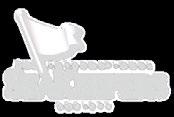

SONASOFT LT™ ABOUT US everything we do. We prioritize the protection innovation sets us apart. safety at sea, through Our commitment to of the marine ecosystem in integrative intuitive comprehensive flexible
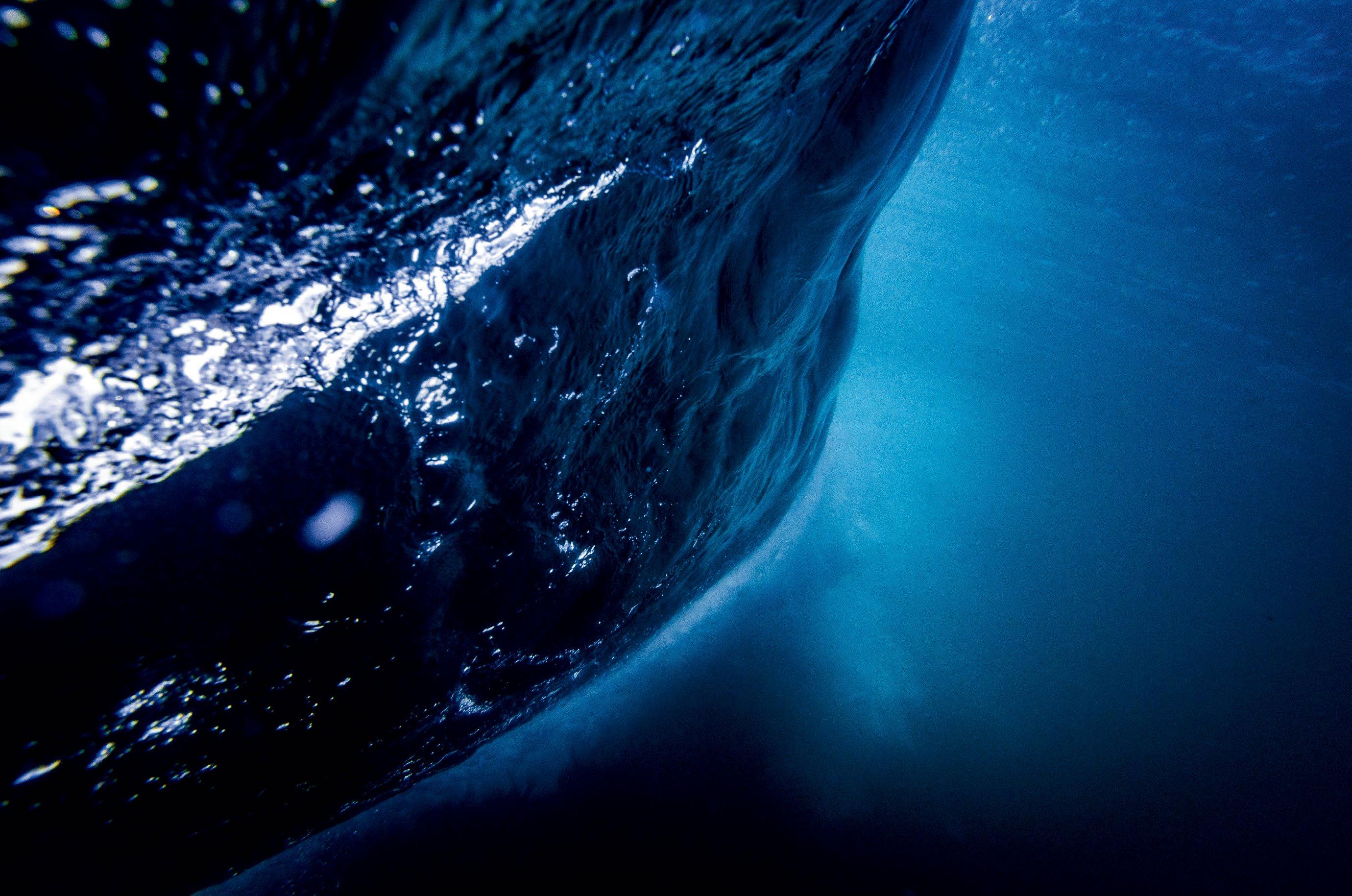
Delta Marine’s 48-metre Project Zembra is one of the shipyard’s most technically ambitious project to date. Designed to accommodate a helicopter, submersible, amphibious aircraft, large tender and other toys, the one-off explorer is the result of creative thinking, innovative engineering and regulatory foresight.
BY JUSTIN RATCLIFFE

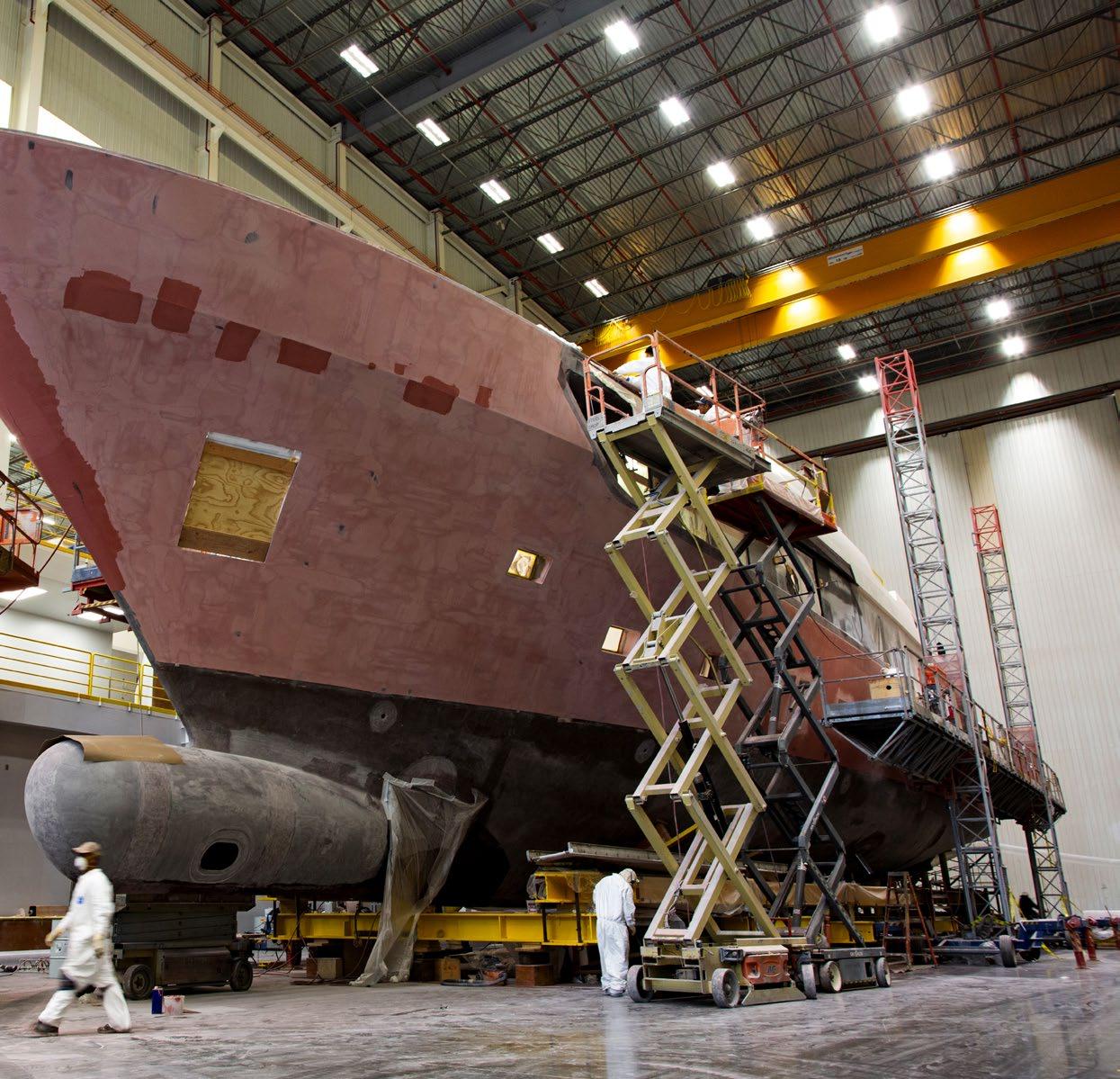

Delta Marine in Seattle builds custom superyachts based on a range of full displacement, semi-displacement, and high-efficiency hull forms tailored to match the long-range or higher speed needs of its clients. Ever since brothers Jack and Ivor Jones set up the shipyard in 1967, originally to build fibreglass fishing vessels, it has been known for its use of advanced composites – sometimes in combination with steel or aluminium. Notably, the composite bridge deck of 72-metre Albatross (now Moonstone), at 2,000-plus gross tons one of the largest yachts ever built in the US, was infused as a single piece and then married to the steel hull. Leveraging this expertise and designed completely in-house, is constructed from composite materials based on a proven, fulldisplacement Delta hull. The challenge was
that it had to support the additional weight of all the toys carried on the open decks. These include a Williams 625 jet tender, an Icon A5 light-sport aircraft designed to land on water, a helicopter landing pad on the sundeck, PWCs on the foredeck, a Remote Operated Vehicle (ROV), and a 3,800-kg, 3-person U-Boat Worx submarine on the swim platform complete with its own crane system integrated into the deckhead. In the words of The Beatles, ‘Boy, you’re gonna carry that weight’.
“If you look at all the gear on deck, it's really more comparable to a much larger yacht,” affirms Chris Jones, son of Delta cofounder Jack Jones. “So that's been one of the challenges throughout the design and construction process: how do we house all these really fun toys that the owner wants on a boat under 500 gross tons?”
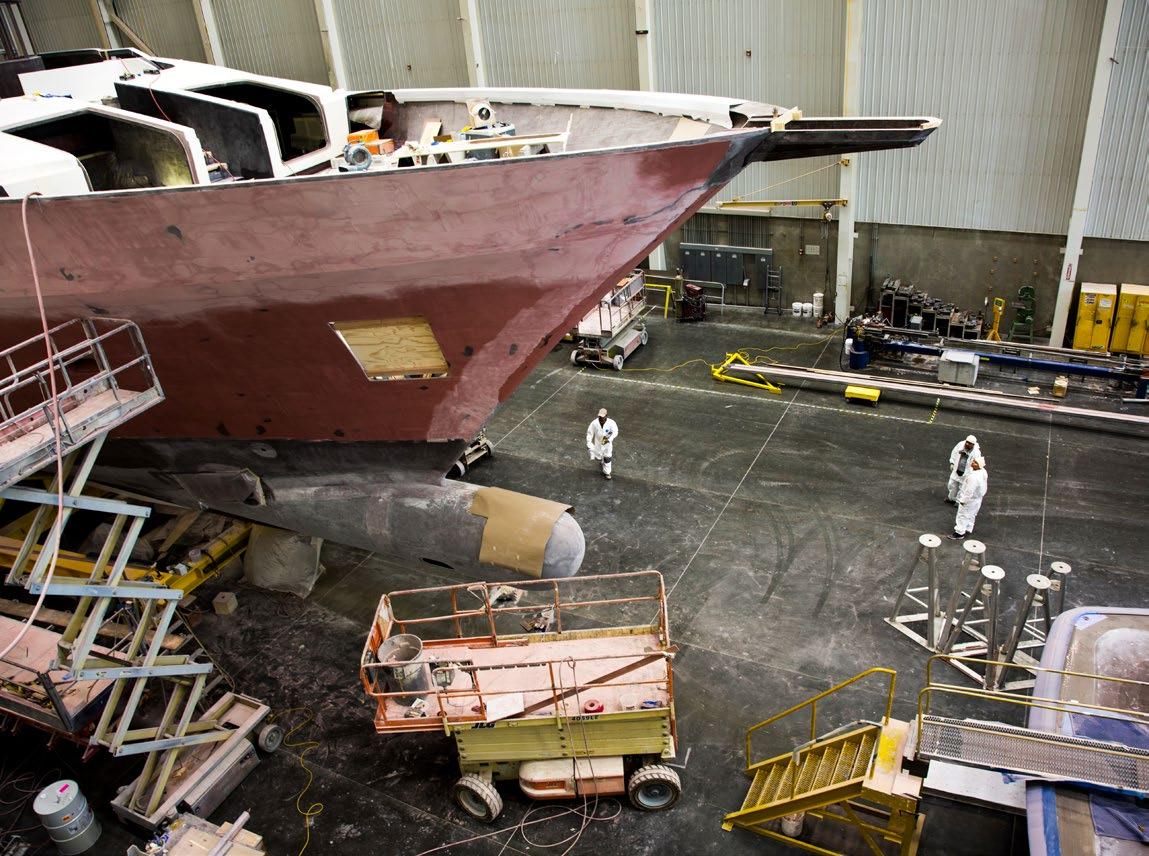
“That’s been one of the challenges throughout the design and construction process: how do we house all these really fun toys that the owner wants on a boat under 500 gross tons?”



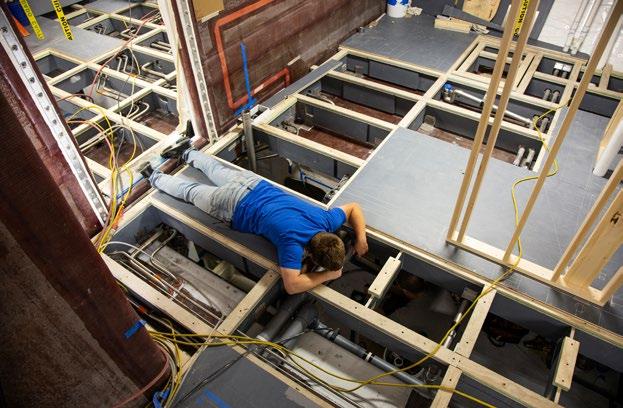
In addition to opitimising volume to achieve 499 GT, Delta also implemented a rigorous weightreduction strategy to preserve vessel stability. Material selection played a key role in ensuring sufficient strength while reducing weight to keep the centre of gravity (VCG) as low as possible. To this end, the hull is made of E-glass, but carbon fibre has been used extensively for the superstructure (Delta subcontracts its superstructure tooling out to Janicki, a local supplier that includes Seattle-based Boeing on its client list and operates some of the largest 5-axis milling machines in the world).
Heating the foam cores and ‘thermoforming’ them into shape eliminated the need for kerf cuts that would otherwise be needed to conform to the mould. These cuts act as pathways for the resin required for bonding during infusion, but excess resin adds significant weight to components. Reducing the amount of resin absorbed by the core material directly translates to a lighter product. The foam-cored interior bulkheads feature large openings to shave off a few more kilos, more like a lightweight, go-fast yacht than a full displacement vessel. Glazing was another weight-critical area. For the first time, Delta is working with Tilse for the glass as the German company was able to supply Lloyd’s-approved glass at the lowest weight (it will also have a slight bronze tint to match the paintwork).
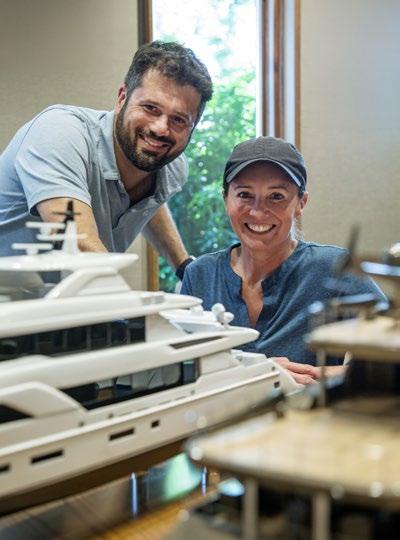
“Every opportunity we can think of to save weight, we explore it,” says Randy Neureuter, chief naval architect. “From a structural perspective, these efforts mean the yacht will be about 15 percent lighter than other vessels we’ve built using the same mould, but just as strong. Considering the additional weight from the added equipment, being lighter up top was crucial for maintaining stability as well as the vessel's overall performance.”
Composites offer other advantages, including better inherent resistance to heat transfer than aluminium as well as very low coefficients of thermal expansion for superior dimensional stability across large temperature variations – a plus for a globetrotting vessel with a dark bronze paint scheme. Nevertheless, heat studies were made to make sure the Dometic HVAC system was up to task and the yacht will also have awnings spanning up to 60 percent of her upper decks for extra cooling shade.
“There are lots of published reports as to how hot surface temperatures get between different colours and how that affects the interior temperature,” says marine engineer Dan Filonowich. “The effect can be quite drastic, but is something we can measurably accommodate and factor into the AC calculations, but it does drive the chiller load up slightly. “
Facing
Below: Assembling the superstructure and early-stage
ITC gross tonnage (International Convention on Tonnage Measurement of Ships) and US regulatory gross register tons (GRT) are two systems for measuring a vessel’s volume, with ITC generally resulting in higher values. There is no direct conversion factor between the two systems. 300 US regulatory gross tons (GRT) is primarily used in the context of US regulations as a threshold that triggers various requirements, including mandatory inspections for certain vessels. A vessel’s tonnage may fall below the 300 GRT threshold under the regulatory system, but exceed it when measured under the ITC system.
For decades, owners of yachts of 300 gross tons or more were effectively shut out of the US flag because they were subject to US Coast Guard inspection as “seagoing motor vessels.” The Coast Guard’s inspection requirements, which were designed for cargo ships and other merchant vessels, were impossible for yachts to meet. As a result, yachts of 300 gross tons or more had to be registered under foreign flags if they operated outside inland waters.
Legislation introduced in 2019 opened the door for US documentation of yachts of 300 GRT or more that was comparable to the Large Yacht Code (LY3) at the time, but with specific requirements: first, large yachts cannot carry cargo or passengers for hire, which means they cannot be time-chartered; second, large yachts must comply with other requirements for US documentation, including citizenship requirements for the yacht’s owner and crew. Finally, owners of large yachts must disclose the identity of the yacht’s beneficial owner to the Coast Guard.
Project Zembra is for experienced, hands-on owners who have previously owned Inace and Nordhavn yachts. They wanted their first fully custom yacht to be American flagged for chartering in the US, but with the option to switch the flag to a foreign registry later for greater crew options (47-metre Project Ammo is also being built by Delta with international charter in mind). This created the need for the vessel to meet both US Coast Guard and Cayman Islands certification, allowing it to operate in US waters under the Jones Act, which typically restricts foreign-flagged commercial yachts from visiting consecutive American ports. This focus on charter operations, is something of a departure for Delta, which has traditionally built yachts for private use that sometimes remain under the same ownership for decades.
“Delta is excited to have two of its current in-build projects planning to enter the charter market,” says Michelle Jones, Delta Vice-President and daughter of the late Ivor Jones. “This not only allows us to share the story of their builds more openly, something we have not been able to do in over a decade, it also gives potential clients the opportunity to experience the quality of a new Delta yacht firsthand.”
While dual certification provides significant long-term flexibility for the owners, it introduced an additional layer of complexity, not least because the yacht has to comply with two sets of emissions standards: IMO Tier III and EPA Tier 4 (see sidebar). These standards target different pollutants and use different technologies to reduce emissions, adding cost and a larger engine room footprint (making room for all this equipment is one reason why the project was stretched from 45 to 48 metres in length). The CAT main engines were chosen specifically because they are dual-rated, and the Kohler generators are deliberately sized under 130kW to keep within Tier III regulatory limits and avoid further after-treatment systems.

Moreover, had to remain under 300 US regulatory tons, the point when additional rules kick in (see sidebar), particularly regarding notice of arrival (NOA), while also addressing international gross tonnage rules to allow worldwide operation. This required early structural planning and careful envelope control across all decks.
“We’re very well versed in how to do all of these things,” adds Filonowich. “Delta has a history of working with class societies for over 30 years now, so all of these regulatory hoops we have to jump through have become kind of second nature.”

























































































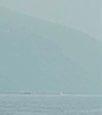



In the world of superyacht construction, precision is key. Since 1962, Blokland has partnered with leading shipyards to deliver high-end propulsion systems for motor and sailing yachts – build to meet the highest standards of performance, comfort, and reliability at sea. Our complete propulsion and rudder systems are engineered in-house, ensuring full control over quality, fit, and seamless integration into each unique build.
Blokland propulsion systems are trusted by some of the world’s most respected superyacht builders. Why? Because they know we don’t just supply components— we deliver peace of mind. Our systems are built to perform, built to last, and built to exceed expectations.
Whether you’re building a 40-metre explorer or a 70-metre flagship, we’re ready to support your team with propulsion systems that match the ambition of your project. Let’s keep moving forward, together.



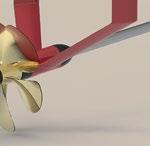



























One of the more complex of ’s features is her 4,500kg-capacity gantry crane for launching and retrieving the Superyacht Sub 3 from U-Boat Worx on the swim platform.
The owner, who is qualified to pilot both the sub and the amphibious plane, requested that the crane disappears completely into the aft overhang on bridge deck. Custombuilt by Nautical Structures, the crane’s boom extends close to 8 metres out of the deckhead like a passerelle.
Integrating the crane into the superstructure required Finite Element Analysis to distribute loads through a network of carbon-fibre beams and local reinforcements in steel and aluminium. The design team also had to consider systems in the lazarette for charging the sub’s battery banks, storage for medical-grade oxygen and external lockers to mitigate fire risk.
“It certainly hasn't come without its challenges,” admits Born Syse, Delta project manager. “We’ve spent many hours on video calls with Nautical Structures to make sure the crane itself completely disappears inside the deckhead to maintain good head height and doesn’t detract from the overall design.”
JR Marine in British Columbia is building a custom 50-foot aluminium catamaran that will serve as both a chase boat with additional diesel storage and support vessel for the submarine. Equipped with an A-frame crane for sub deployment and recovery, when the sub is in use it will maintain communication and safety oversight during dives.
IMO Tier III and EPA Tier 4 are both emission standards for marine diesel engines, but they have different scopes and requirements. IMO Tier III, established by the International Maritime Organisation, specifically targets NOx emissions within designated Emission Control Areas (ECAs). EPA Tier 4, set by the U.S. Environmental Protection Agency, is focused on reducing particulate matter (PM) and hydrocarbons (HC), as well as NOx emissions.
IMO Tier III requires technologies such as selective catalytic reduction (SCR) to significantly lower NOx emissions. EPA Tier 4’s limitations on a wider range of pollutants typically require additional technologies, including diesel particulate filters (DPFs).
For vessels operating in US waters, EPA Tier 4 standards are mandatory. Vessels operating in both US waters and international ECAs might need engines that are compliant with both standards or one that can switch between modes to meet requirements for different regions, as seen in some modern Rolls-Royce mtu systems.

Below left: Integrating the crane into the superstructure required FEA to distribute loads through a network of carbon-fibre beams and local reinforcements in steel and aluminium.
Below: When not in use, the crane disappears into a recess in the bridge deck overhang.


Project Zembra’s layout is conventional for the size of yacht with four guest staterooms on the lower deck (a fifth space serves as a gym). Again with charter in mind, an elevator serves all decks, one of the guest suites is designed for wheelchair access and there are no raised sills between the interior and exterior areas. The main saloon, dining room, galley and master stateroom are on main deck, while the bridge deck houses the sky lounge and captain’s cabin behind the spacious wheelhouse. The open sun deck is set up for al fresco dining dining and there is a hottub forward.
The conventional drivetrain is powered by twin CAT C32 (1,200hp @ 1,800 rpm) diesel engines. Delta has not yet built a yacht with hybrid propulsion or auxiliary battery packs, preferring to simplify operations based on robust engineering and well proven systems, although it keeps a close eye on technical developments. “We have what we call our ‘green button’ philosophy,” explains Michelle Jones. “What does that mean? Basically, a commitment to user-friendly systems designed for simplicity and reliability, allowing captains to prepare for operation quickly and easily, so all they need to do is push the green button and go."
Project Zembra reveals just how much you can pack into a mid-sized superyacht under 500GT, thanks in part to her advanced composite construction – less structural material translates into more space. From emissions standards and dual-flag requirements to the technical integration of submersible handling, every element has been scrutinised for weight, functionality, compliance, comfort and, of course, safety. The result is a world cruiser that balances good looks with the seaworthiness required to tackle the rugged conditions associated with the Pacific Northwest, and the versatility to switch from private exploration to international charter.


James Allen is Chief Operating Officer at Arrow, the superyacht management company specialising in new build, refit and operational management. A sailing instructor at 15, professional race skipper and round-the-world yachtsman before he reached 30, James is no stranger to challenges, whether at sea or on land. An experienced leader in high-pressure situations, he is a key member of the executive team driving the independent company’s growth and development.
BY JUSTIN RATCLIFFE

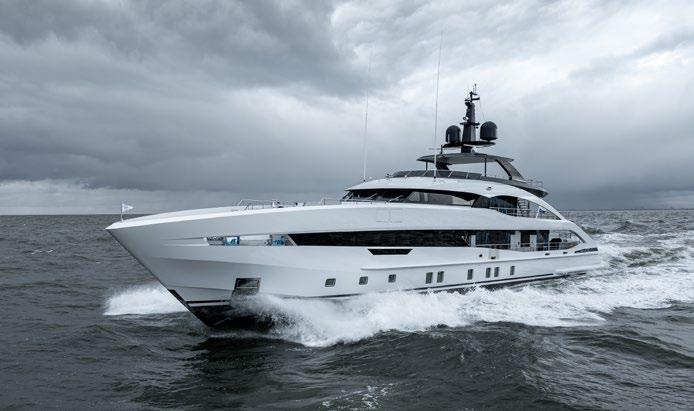

What does a Chief Operating Officer actually do at Arrow?
James Allen: We’re still figuring that out! I was Director of Yacht Management for nearly eight years, overseeing the managers, accountants, and technical teams. Now, I’ve stepped back from the day-to-day to focus on the bigger picture – overseeing both the Monaco and US offices, supporting the CEO on business strategy, and continuing to manage relationships with owners. I’m still the company troubleshooter, but now with more focus on long-term growth and direction. The COO role was created specifically to evolve with me and the company.
How has your sailing experience influenced your work in yacht management?
JA: Sailing teaches you to be a natural problemsolver. On the water, things go wrong – often unpredictably – and you have to fix them with the tools and people you’ve got. That skill set translates directly into yacht management. Every day brings new challenges, especially as I’ve moved into more senior roles where I get involved with ownership-level issues. You need to understand what the owner wants, what the regulations say, what’s possible – and then navigate a way through. That mindset comes from sailing. It also builds teamwork and resourcefulness, which are essential.
You’ve also worked as a photographer – how did that start?
JA: It began during my round-the-world race. We had to submit two photos a day, and no one else wanted the job, so I took it. It became a creative outlet and by Cape Town, I was really enjoying it. Yachting World saw my work and featured it. After the race, I did a stint as a photographer with a news agency, but quickly realised courtroom doorsteps weren’t for me. My passion was always in sports and sailing photography.
Do you manage many sailing yachts?
JA: We’re all sailors at heart, and we’d love to have more sailing yachts. But it’s a very small sector and hard to build a business on. Sailing owners tend to be more passionate and handson, so they often prefer to manage things themselves. That said, I’d love to see us do more with large sailing yachts.


Are you using AI tools to assist in yacht management?
JA: We’re starting to. The real potential is in data analysis. We have loads of data – accounts, motion reports, maintenance logs – but it’s all manually reviewed. AI could help identify spending trends across the fleet, optimise maintenance, and streamline reporting. Just recently, one of our owners used ChatGPT to compare crew employment proposals – it highlighted a €40,000 difference in minutes. It was a wake-up call for us to be more proactive with this kind of tech.
Previous
Opening
How does your role vary between operational yachts and new builds or refits?
JA: I focus mainly on operational yachts, but refits fall under that umbrella too. With full order books and new builds now taking up to eight or nine years, refits are becoming more popular. We’ve seen a real shift recently – people buying second-hand and investing heavily in upgrades. We currently have six major refits underway.
Ensuring continued growth is part of your role – how do you go about that?
JA: Growth isn’t just about adding more boats. It’s also about doing things better than we did before – creating a culture where crews want to work with us and owners trust us. We’ve got 40 boats under management now, and 16 more in-build, most of them over 70 metres. That pipeline gives us stability and visibility for future staffing and development.
Client relationships are another a big part of the job. How do you manage them?
JA: Trust and transparency. That’s the foundation. I travel to meet owners regularly and what I enjoy is learning how each owner thinks – because it’s often completely different from us. They deal in different financial scales and make decisions accordingly. Understanding their mindset helps us tailor our service. And yes, occasionally we part ways with clients when it’s not the right fit. But we always try to make it work first.
JA: Independence. We don’t do brokerage, charter, or sales – nothing commission-based. That means our advice is completely impartial. We’re not trying to sell something; we just focus on what’s in the owner’s best interest. It creates trust. Also, our people-to-boat ratio is unusually high, which means better service.
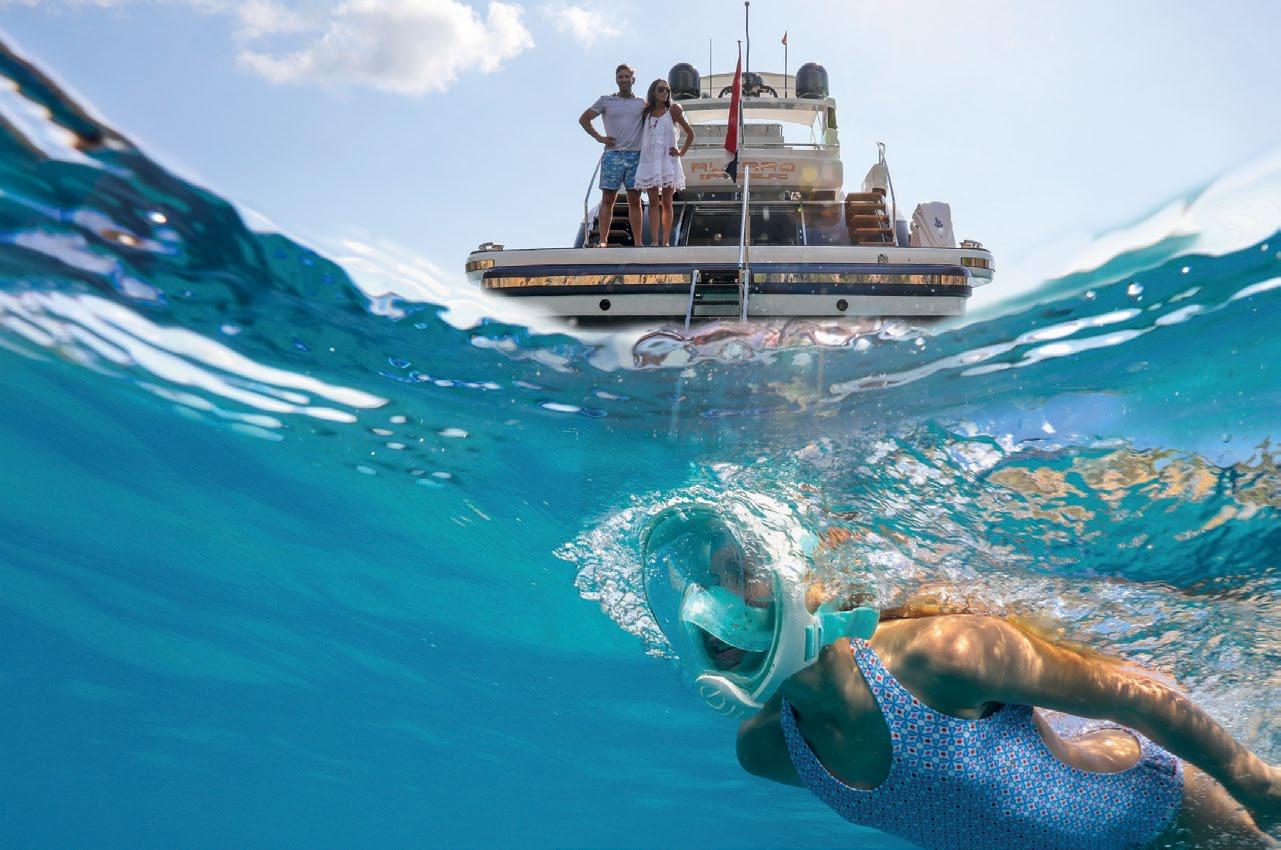





There’s something deeply satisfying about watching your loved ones safely snorkelling around your yacht with crystal clear views of the world below. Some hazards remain unseen, however, and you certainly don’t want to be polluting the azure waters with diesel particles or exhaust oil. And then there’s our shared responsibility to preserve this stunning underwater beauty for future generations.
Xeamos’ clean-air, soot-free, noise-reducing systems will protect your family, friends and crew. Contact us to explore joining an exclusive club of owners who enjoy this peace of mind. And don’t believe those who say your engine room space is too limited. Our experts have designed countless tried & tested solutions and will embrace the challenge of assuring you similar levels of quality and comfort.

Just like superheroes. Always by your side, ensuring a smooth yachting experience. RINA.ORG
Our experience. Your growth.


How a yacht handles its wastewater increasingly dictates where it can cruise in the world, which means wastewater collection and treatment should be critical considerations during the design phase. What are the latest technologies available, and how do they impact the design of today’s superyachts?
BY CHARLOTTE THOMAS

How often, when using the heads, washing the decks or flicking the air-con on, do we think about where the water and waste goes? Chances are the answer is hardly it all – yet the handling of wastewater on yachts is mission critical, not just for the comfort and health of guests and crew, but also increasingly for where the yacht can go.
Complying with regulations also doesn’t just mean getting a wastewater system signed off. Proper crew training is essential. Even a simple system that relies on holding tanks can be fraught with danger, as anyone whose tanks have automatically discharged in the wrong place can attest – hefty fines and criminal charges have been known to have been levied against unfortunate superyacht captains caught unawares.
Yachts present certain challenges when it comes to selecting the best form of wastewater treatment. For a start, water usage on board per person is typically considerably higher than on commercial vessels, thanks to increased use of guest showering, laundry and other factors – and, of course, the obligatory washdowns.
Wastewater systems manufacturer Hamann estimates that a cargo ship, when combining
head, showers, washbasins, galley and laundry, produces in the region of 135 litres of wastewater per person per day, but for a yacht the guideline is around 450 litres per person per day. Solutions manufacturer ACO Marine reckons 160 to 200 litres per person for a cruise ship compared to up to 500 litres per person for a yacht.
Yacht wastewater also includes sources that can quite easily be overlooked. There’s black water (the water that comes from toilets and urinals) and grey water (comprising drainage from showers, washbasins, laundries, galley sinks and dishwashers), but there’s also wastewater from special systems such as spa pools, deck drains, and even HVAC condensate – a particular issue in hot cruising regions. Then there’s the issue of peak flow moments, such as after breakfast, which can easily overwhelm systems if the correct buffers aren’t built in.
“One of the biggest mistakes you can make is to walk into a project thinking, ‘We just need a sewage treatment plant for X number of people’,” begins Mark Beavis, Special Projects Director at ACO Marine. “Moreover, there’s always room for toys like jet skis and tenders,

but rarely for the wastewater treatment system. Every part of the yacht generates wastewater, and once you understand where and how, you can manage it responsibly.”
“A sewage management system needs to be designed properly, from sewage collection via sludge handling to effluent discharge,” adds Olaf Hansen, Head of Technical Department at Hamann. “Sewage treatment plants, black and grey water lines, grease separators, system separators preventing microbes from spreading against the flow from waste water lines into fresh water systems, holding tanks, tank aerations, transfer systems, sludge tanks, sludge processing facilities and performance monitoring are all part of the system. Of course, every project is different, therefore a sewage management system has to be customised to cover the specific conditions on board.”
Beavis concurs: “We’ve built dozens of systems and no two are the same. This is miniaturised cruise ship tech, adapted to yachts. We also need to understand where every drain is – from bow to stern, port to starboard – and how that flow is transferred to treatment.”
1. Collection Systems: Scuppers, drainage channels, piping & vacuum systems.
2. Storage & Pumping: Mixing buffer tanks, transfer pump stations for moving wastewater around the vessel.
3. Galley Water Management: FOG and Sludge removal.
4. Laundry and detergent filtration: Fibre and detergent filtration.
5. Enhanced ‘Conventional’ Treatment: Biological settling systems with improved efficiency.
5. Advanced MBR Treatment: Membrane Bio-Reactor § 4,2 compliant for high-quality water treatment.
6. Interface to Ship Central Control Monitoring & System: Automation, alarms compliance monitoring.
Water Recycling & Re-use: Potential onboard re-use for non-potable applications.
Sludge Management: Storage, dewatering or disposal.
Overboard Discharge: Ensuring Compliance with Maritime regulations for safe disposal at sea.
One essential element to check when specifying a system is that any certifications (IMO, EU-MED or USCG) it holds are both real and accurate – in other words, be wary of so-called ‘magic boxes’.
“A sewage treatment plant that is claimed not to produce sludge is the classic example of what we call a ‘magic box’,” warns Hamann. “This is not only a certification without conformity to the

Treatment systems come in several forms. At the most basic, that could be a simple collection and holding system, which is then discharged in a port facility (or at sea under certain criteria), but that has a cost and it limits operational flexibility. The next step up are systems utilising a combination of filtration and sterilisation by chemical dosing or electro-catalytic action, but these are not very environmentally friendly and certain aspects – such as the use of corrosive hydrogen peroxide or chlorine – bring significant problems.
The global operating profile of large yachts (and other passenger ships) means membrane bioreactor treatment (MBR) technology is a popular option. MBRs utilise biological processes to eat the waste, producing an inorganic sludge that can be safely discharged ashore, or at sea
if local rules permit. The membrane is so effective that no sterilisation chemicals nor UV treatment are required, and the clear effluent, while not considered potable without additional treatment, can be recycled for toilet flushing, deck washing, or engine cooling. “There’s still a psychological hurdle with the drinking part, but technically it’s doable,” advises Beavis.
There are also now enhanced conventional biological treatment systems that offer a simpler alternative to MBRs that are suitable for LY3 yachts of no more than 12 passengers that do not require additional compliance for nitrogen and phosphorus removal. Any large vessel, yacht or otherwise, has to have a functioning sewage treatment plant on board, or an IMO-approved holding system and selection is made on number of people rather than length of yacht.
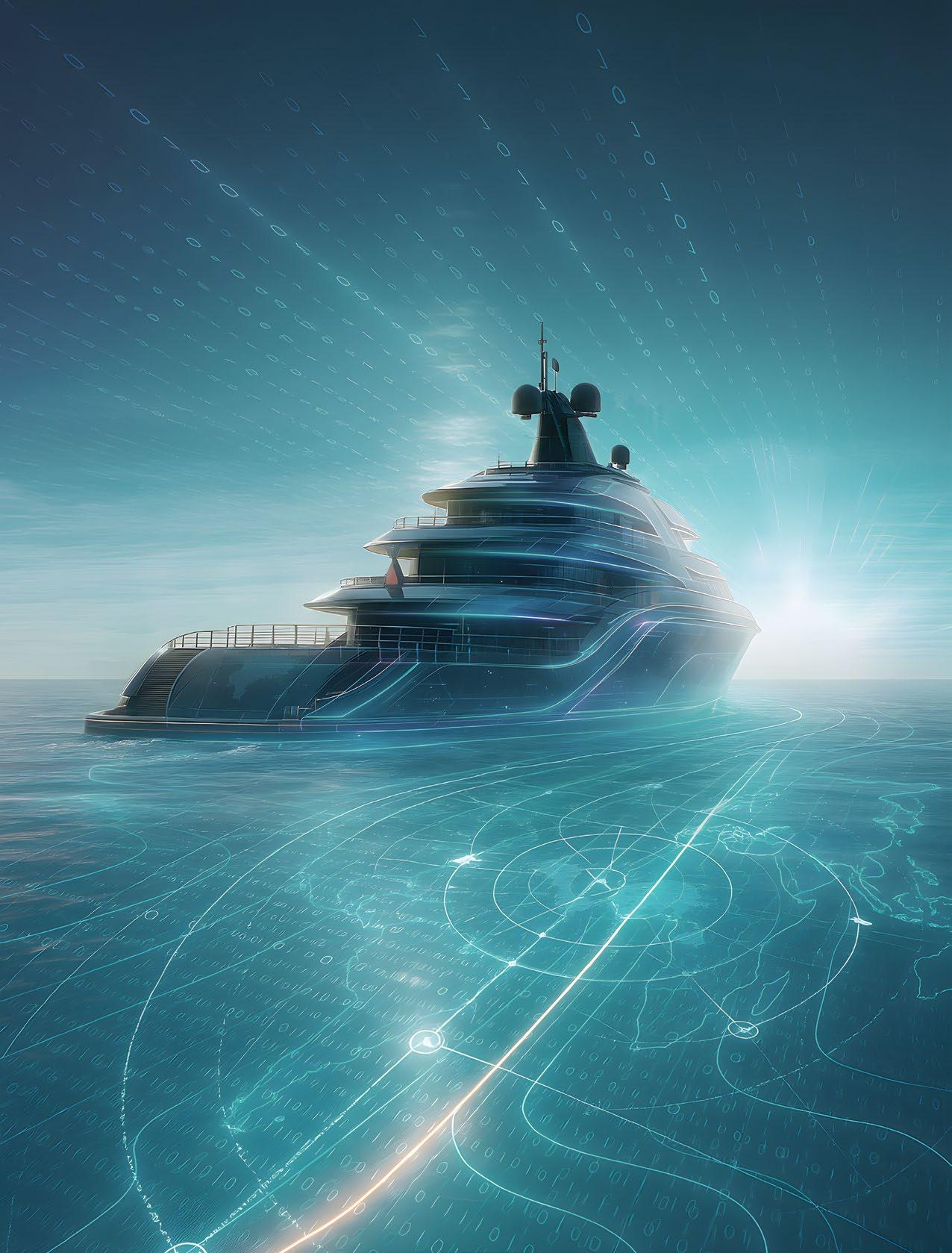


“With a yacht for only 12 passengers a conventional system is often used with utilises extended aeration and steeling processes – we’ve used those on yachts up to 100 metres in length and that works fine,” says Beavis. “A biological system is a volumetric process – it needs a certain volume of waste per person and it needs a certain amount of residence time for the biology to eat the waste and then for the sludge to settle out.”
When it comes to considering a system for a yacht, both simplicity for the crew and system flexibility are key so the vessel can be either stood down with just a few crew on board, or do a marathon charter with a full complement of guests.
“That flexibility is critical,” insists Beavis. “Because if you have one size of treatment plant and it’s sized for 100 people on board, that’s great when you’re at capacity, but if it drops to 25 people it will be under-loaded –there’s not enough food coming through to keep the biological quality, and the biology dies off because there isn’t enough to feed it and that can lead to system collapse. Aerators keep the bacteria alive from an oxygen point of view, but they need food.”

The treatment and discharge of sewage at sea is regulated under the International Maritime Organisation’s Annex IV of MARPOL (marine pollution) regulations which applies to vessels of 400 GT and above or certified to carry more than 15 persons. According to Annex IV, it is generally considered that on the high seas, the oceans are capable of assimilating and dealing with raw sewage through natural bacterial action. As a result, says the IMO, “the discharge of sewage into the sea is prohibited, except when the ship has in operation an approved sewage treatment plant or when the ship is discharging comminuted and disinfected sewage using an approved system at a distance of more than three nautical miles from the nearest land. Sewage which is not comminuted or disinfected may be discharged at a distance of more than 12 nautical miles from the nearest land when the ship is en route and proceeding at not less than 4 knots.”
MEPC.227(64) deals with the type of wastewater treatment equipment that has to be on board,
how it has to perform, how it has to be tested and how it should be monitored. But it also goes further in one clause which is very specific, and very relevant to PYC superyachts: Section 4.2 addresses passenger vessels operating in IMO Special Areas, and they have to meet additional standards for the treatment and removal of phosphorus and nitrogen (using membrane bioreactor technology). Although the Baltic Sea is currently the only IMO Special Area under Annex IV (sewage pollution), other regions such as Western Australia and parts of the Mediterranean are either applying to become SAs or looking to introduce equivalent local rules.
“MEPC.227(64) Section 4.2-compliant MBR systems offer a truly future-proofed solution to all current and anticipated legislation,” says Beavis.
“The days for other alternative chemical and dilution systems are seriously numbered. No yacht should ever find itself in a situation where it is prohibited from either sailing from – or into –any given port anywhere in the world.”
Below: The galley aboard the
Admiral yacht designed by
in an early stage of fitting out. Wastewater management is often not addressed early enough in the design process, argues Beavis.
It’s not just about the core sewage treatment plant: pre-treatment is vitally important too. Galley waste, grease separation and solid separation need to be carried out, not least because these aspects can lead to biological overloading. For the laundry, a flimsy little lint filter in the washing machine is not enough – it needs to go through a proper industrial filter system.
“Pre-treatment is also critical in terms of toilets as you’d be surprised what ends up going down them, from Rolex watches and wedding rings to condoms and sanitary products,” continues Beavis. “The latter seem to find their way through every part of the system including the macerators, before wrapping themselves around float switches and causing tanks to overflow!”
Sewage treatment plant and wastewater tank ventilation, plus the aeration of those tanks to make sure they don’t go anaerobic – which can lead to the production of deadly hydrogen sulphide – is also vitally important. Post-treatment using an ultraviolet ozone deodorising system can be an effective way of scrubbing odours and particles from vent gases.
“The vents go up the funnel and that has to be considered – on one very big yacht the owner arrived in his helicopter, got out, and what’s the first thing he smelt? To say that the effluent hit the fan would be an understatement.”
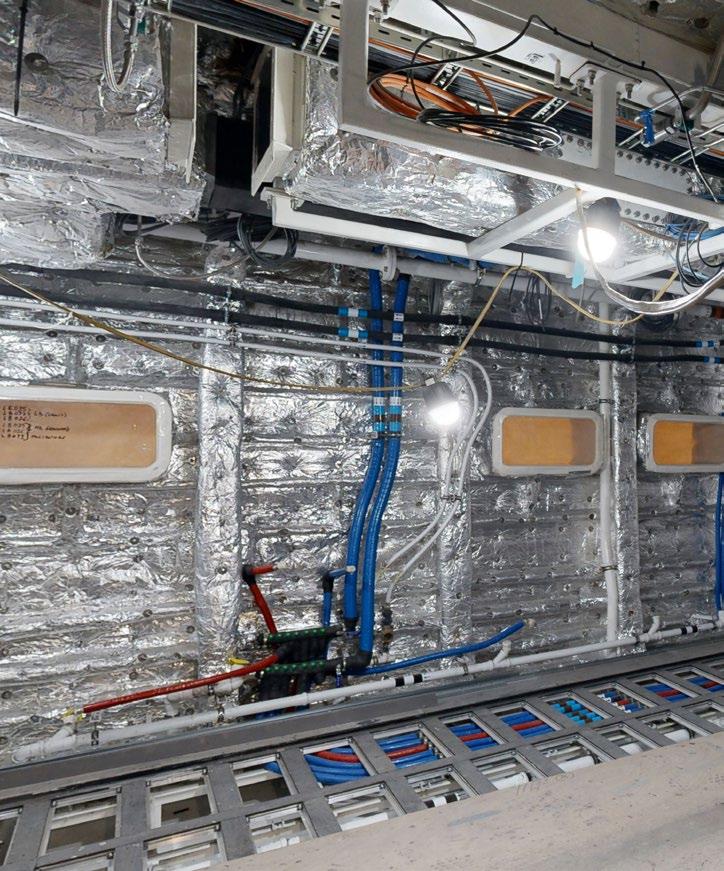
Galley waste, grease separation and solid separation need to be carried out, not least because these aspects can lead to biological overloading.

The problem facing larger yachts, in particular, is the extreme variation in system requirements depending on who is on board at any given time, from solely crew to full guest and VIP modes complete with additional staff and entourage. Such fluctuations can be hard to accommodate if the system isn’t thought through. For ACO Marine, that has involved developing a multi-mode system that can be scaled up or down via a selector switch, an example being the Maripur 150 system they installed aboard one 100-metre-plus yacht thing that has settings for 50, 100 and 150 people.”
If the yacht is at capacity with 150 people on board then all membranes are brought online, all pumps operate at rated capacity, and everything is running. With owner and some guests plus crew on board, or just the crew on board, the selector is switched to the 100 or 50 people setting, and the pumps run at reduced capacity controlled via frequency converters, with the flow rate through the membranes reduced.
“The operating levels are lower because there’s less coming in, but we want to keep the concentration at the same level, and so it re-tunes itself to that reduced input level,” Beavis explains. “Then when the call comes that the owner and guests are coming on board, they just turn the system back up.”
Profiling a yacht’s requirements and mapping out its systems is key to ensuring an effective and efficient outcome, and that means getting expert input when still in the engineering phase. “The earlier we get involved in a project, the better the results can be,” says Hansen. “We often do workshops with ship design companies and naval architects before or at the very beginning of a project to improve the sewage management system as a whole. During construction we closely work together with the shipyard engineers on creating the best possible conditions on board in order to operate our systems properly.”
Wastewater management of superyachts is a challenging dilemma often not addressed early enough. This easily leads to compromises and getting it wrong can be a very costly mistake, which is why naval architects, yacht designers, and yacht builders should seek expert advice from an established wastewater solution provider at the earliest opportunity.




With more owners arriving by helicopter, the helideck has become a highly-critical area—one that must perform flawlessly in all conditions and meet rules from flag, class, and aviation bodies. Central to this are two elements: a reliable Helicopter Visual Landing Aid System (HVLAS) that provides clear yet comfortable visual cues, and a certification approach built on international standards.
OPTONAVAL’s ADEL (Adjustable Deck Edge Light) is a lowprofile light designed specifically for superyachts. It defines the landing area with a clear, uniform light while minimising glare — a critical detail during night approaches and when pilots’ eyes adjust between bright decks and dark horizons.

A recent engineering rework has improved sealing and thermal management, strengthened mechanics for vibration-rich marine environments, and enabled quicker mounting. The result: faster installs, greater robustness, and tighter optical consistency across the helideck.
Certified helicopter landing areas on yachts

– Provides a continuous visual aid for approach, touchdown, and take-off, with controlled intensity and beam spread in line with international heliport guidance.
– Allows adjustment of installation depth to ensure the light sits flush with the deck highlighting its polished design.
– Interfaces with the Helicopter Control and Monitoring System and dimming controls, enabling the crew to fine-tune light levels and procedures.
– Compact, low-profile housings reduce trip hazards and visual clutter.
– Mounting options support both newbuilds and refits, simplifying cabling and through-deck penetrations.
– Top-side serviceability shortens maintenance windows and avoids intrusive deck work.
Yacht helidecks operate at sea and must satisfy multiple authorities. Designers typically align three pillars:
– Class society rules (e.g. DNV): Deck structural strength, safety, and certification basics.
– International aviation baseline (ICAO Annex 14): Defines heliport characteristics, lighting principles, spacing, and uniformity.
– Operational guidance (e.g. CAP 437): Prescribes a full lighting scheme—perimeter, lit TD/PM circle, and “H”—plus spacing, height limits, friction, and testing. Key technical threads for helicopter decks
– Deck size (D-value): Restricts helicopter size; clear zones follow from this.
– Lighting: Evenly spaced, height-controlled lights, plus TD/PM circle and “H,” improve pilot cues.
– Documentation: Operating limits, crew procedures, and maintenance/testing records satisfy authorities.
audit-ready, refit-friendly
Certification is holistic - every component must perform. The ADEL’s low profile and adjustable optics meet spacing and height requirements while delivering a visually consistent deck perimeter. Paired with a lit TD/ PM circle and “H”, it supports modern helideck lighting schemes expected by auditors and pilots.
For yachts upgrading from older floodlight solutions, switching to an ADEL-based lighting system is a highimpact step toward current standards. Faster installation and improved sealing from the latest ADEL rework make it ideal for yard periods where every hour counts. The ADEL can also be temporarily removed during deck maintenance and easily reinstalled, and its installation depth can be quickly adjusted to accommodate any changes in deck height.
www.optonaval.de | info@optonaval.de



Twenty-odd years ago, the super-sailing sector began setting benchmarks using advanced composites to build sophisticated skyscraper rigs. With several significant sailing projects now in-build, we look into what has changed in mast design and construction, and what the future may hold for super-sized spars.
BY CHARLOTTE THOMAS
As the super sailing yacht fleet has grown, both in number and in size, so the engineering demands have increased – particularly when it comes to the mast. Extreme LOAs have led to extreme spars, spurred by developments in materials science both for the mast tubes themselves as carbon has evolved to serve as an alternative to aluminium, and in the rigging that supports them.
Owners’ desires to push boundaries has delivered compelling sailing projects through the years, perhaps best embodied by yachts like M5 (ex-Mirabella 5) with her towering 88-metre sloop rig; the “sail-assisted” Sailing Yacht A, whose freestanding carbon masts are the biggest built to date; and, of course, Maltese Falcon with her revolutionary DynaRig. That they still stand as remarkable and recordbreaking speaks volumes, and it’s only with recent projects such as Black Pearl or the under-construction Project 410 and Project Noir at Royal Huisman, for example, that they are being challenged in size and scope.
“When we designed M5 nearly 25 years ago we didn’t realise how close to the bone we were,” begins Rob Doyle, Principal of the Rob Doyle Design studio who previously worked under sailing yacht supremo Ron Holland.
“It was designed according to the maximum length of Nitronic 50 rod rigging available at the time, which I think was 76mm in diameter. It all came down to the suaging at the top and the length of the bar. We went for a fivespreader rig that came out at 88 metres, and said that’s how big it should be – let’s see how much keel we need to put underneath it.”
Doyle recalls the mast was essentially sketched in an afternoon with the team using the known limitations of the materials as the starting point.
“There was no book you could open, no expert you could call on – it was a real moonshot project,” he says. “It has taken 20 years for anyone to take on something similar with the new 80-metre yachts in build. And even then they will only beat her by a couple of metres.”

page:

“For Doyle, times have changed in big rig design, with an emphasis on practicality rather than pushing materials to the limits.”

Facing page. bottom:
A cutaway of
For Doyle, times have changed in big rig design, with an emphasis on practicality rather than pushing materials to the limits: “The relevant question now is not how you would tackle such a project, it’s why? You can’t get under Panama, you can’t fly a spinnaker, you need an army of people just to get a sail up and down, and there’s a lot of heavy engineering required to handle half a football pitch of sail with a couple of sheets.” It is here that innovations such as the DynaRig stepped in. Developed by Dykstra Naval Architects based on an original 1960s concept, the freestanding, square-riggerinspired spars and sail plan showed how super-sized sailing yachts could fly large areas of sail without requiring enormous crews. The concept arguably became a victim of its own fame as few owners wanted to be seen copying an iconic design. But the rig did eventually find its way onto a new project in Black Pearl, and will subsequently feature on the 58-metre Adventure Sailing Cat multihull project in build at Echo Yachts (see sidebar).
While mast construction technology is largely settled, that doesn’t mean that pioneers aren’t still pushing boundaries –just not in ways you might expect. Spanish engineer Juan Sarmiento, for example, has proposed and patented a system that uses the oscillation of a mast to generate power (see sidebar).
For the sailing yacht Zero project, meanwhile, the team have opted for a mast design that will use the principles of stack ventilation to deliver energy-neutral air circulation for the yacht’s interior. For a project that will operate without carrying a drop of fossil fuel, such solutions are an integral part of the goal to minimise energy use on board, but they also speak to the potential of spars to serve a dual purpose for no cost in performance of the vessel.

Zero’s main and mizzen are being built by Carbo-Link, a company with extensive experience in the civil engineering and aerospace sectors, and which has been developing and supplying rigging solutions to race boats and superyachts since it was brought in to develop the rigging for the first Alinghi America’s Cup challenge back in 2001. The Zero project, however, marks its first foray into mast-building, serving effectively to launch a new business division for the Swiss company.
“The marine industry moves fast, and people are happy to try new technologies – more so than in our other sectors, which tend to be more risk-averse,” says James Wilkinson, Sales & Strategy Director at Carbo-Link. “We started on the Zero project a couple of years ago having got to know the people behind it through supplying rigging to another yacht, and that led to the birth of our mast business that we formally launched in June 2025.”


For Canarian engineer Juan Sarmiento, the mast has been an opportunity to explore an intriguing possibility – using vibration in the mast to generate energy: “I studied electromechanical engineering originally, but it was while working as chief engineering on sailing yacht that the idea came to me. The yacht had a freestanding, rotating Swing Rig and I discovered that in 20 knots of wind the mast hit its resonant frequency. I realised that I could use this vibration to generate power.”
Sarmiento began to explore the possibilities and came up with a design that draws on the principles of vortex shedding, in which a structure in an airflow will begin to oscillate at certain frequencies of the vortices being created. This movement can be converted into electricity via induction, using movement of permanent magnets relative to a copper coil to create current.
According to Sarmiento, a 150-metre bladeless vortex wind generator mast can produce 4MW of power, and a 15-metre mast can produce 4 kW. That would be enough for a small yacht –and with the potential to scale it up with larger rigs for larger yachts. Notably, the mast design would deviate from a conventional rig not only to take the induction components, but also to allow for adjustable rigging that could be tuned to the windspeed on the fly, thus allowing for power generation in different wind bands.
“The rigging is really important, because what we’re looking for is the opposite of what people normally look for – we want the mast to move, whereas most people want to stop it moving,” says Sarmiento.
His solution was to design a system that controls that movement and tension in the rigging using winches with non-Newtonian fluids. These don’t need to draw power, which would defeat the purpose of harvesting energy in the rig, and non-Newtonian fluids are perfect as a passive mechanism as they react to shock-loading instantly. This means that if there’s a gust of wind or other loading on the rig, the fluid goes hard in the piston and stops the rig moving.
Sarmiento has successfully patented his mast generator system, which extends to a system in the keel that uses similar principles of motion, and to using air flow to create bubbles under the hull to reduce friction underway. He is currently seeking investors to back next steps to test and develop the design.
For a first-time mast build, Zero’s spars are far from straightforward. While the Panamax ketch rig is not groundbreaking in itself, the idea of using the mast to ventilate the interior added levels of complexity to the design of the mast section.
“From the start it was clear it was not going to be run-of-the-mill,” Wilkinson says. “There were a lot of ideas discussed between the Zero team, our heads of department and our founder, Dr. Andy Winistoerfer, who is the lead materials scientist here.”
Through 3D modelling and FEA, the team explored several options that included not only adiabatic cooling (a process where air temperature decreases due to expansion, without any heat exchange with the surroundings), but also flexible solar panels on the masts, as well as different lightning protection methods.
The adiabatic cooling works on the basis of stack ventilation – hot air rises, and in the mast column itself is further heated by the sun on the mast to encourage faster vertical airflow, with the hot air exiting at the top of the mast. This creates the opportunity via a system at the base of the mast for free air circulation for the yacht’s interior, reducing energy demand for the air circulation and air-con systems. The outside shape of the masts is fairly traditional, save for some optimisation of the shape based on Carbo-Link’s production processes.

“We’ve gone slightly larger in section to ensure stiffness with a thinner mast wall and we actually ended up with a lighter solution overall,” Wilkinson explains. “That larger section also means more internal space, and by using longitudinal stringers we don’t have a lot of bulkheads in the mast, meaning the only thing going across the mast section are the tangs.”
The cabling, wiring and other conduits in the mast have been integrated into the stringers to create a very clean internal structure with lots of space for air flow, with just the halyards running internally separate to the stringerconduits. Also the top of the mast is actually open, with what are effectively two lungs. The masts will be built and cured in one piece, which also ensures a very clean construction, which further maximises internal space. Interestingly, although the team decided not to apply solar panels to the masts, Carbo-Link has included space in the internal conduits to allow for the required cabling, plus future-proofing by designing in areas for mast cut-outs and for mounting of tech such as LiDAR, CCTV or Starlink antennas on the spreaders.
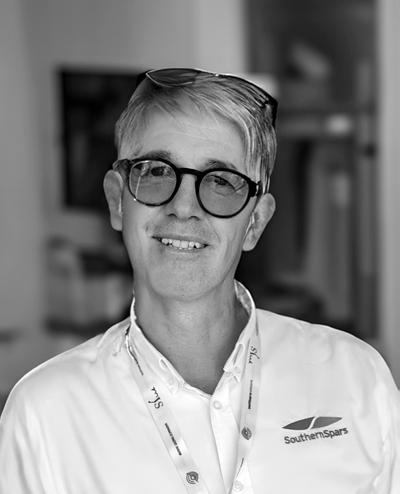


Since Southern Spars teamed up with Magma Structures in 2020 to offer a new generation of DynaRig, three projects have been signed: the ASC58 catamaran in build at Echo Yachts; a 75-metre vessel for Greenpeace; and the 130-metre Project Vela superyacht in build in Croatia. Advances in the design of the rig and its systems are ongoing.
“We would like to see production more automated and more standardised so that if someone comes with a 75- or an 80- or 100-metre yacht we can quickly get into a project,” says Rudy Jurg, Head of Sales for DynaRig at Southern Spars. “On the sailing side we are working on automation for sail setting and trim adjustment so that maybe in the future with LiDAR and with [AI] weather assistants the sail set and trim can be optimised. We are also looking at further reducing the size of components and the number of winches needed to handle the sails on the rig, reducing the electrical power usage, simplifying the cabling, and optimising the shape of the yard arms.”
The Echo Yachts project will feature a slightly different layout to the original Maltese Falcon rig, and will have more modern mast rotation, deck bearings and winches. The team is also looking to use the tooling for repeat projects –part of the mission to standardise aspects of the rig. Each of the ASC58’s rigs carry in the region of 840m2 of sail, which could be extended to offer up to 1,200m2 on the same tooling.
With the International Wind Ship Association (IWSA) forecasting around 10,000 ships globally with some form of wind-assist propulsion by 2030, it’s clear there’s a potentially huge market for an off-the-shelf DynaRig solution – even if the superyacht sector will still demand custom solutions.
It’s also an interesting solution for motor yacht builders to be able to offer sailing yacht owners, because it doesn’t require any knowledge of complex sailing systems, rigging and captive winches.
For Project Vela, details of which remain largely under wraps, the stats are already impressive: “Each of the two rigs is more than 80 metres in length – the same size as the wingspan of an Airbus A380 – and the yard arms each span 25 metres for a total sail area of 3,500 square metres,” says Jurg. “The scope and scale of the project is enormous.”
Zero’s masts threw up another first: “This is the first sailing yacht to have the full Lloyd’s notation as a certification requirement, because it’s the only yacht which is sail-driven and motorassisted,” Wilkinson points out. “That means we’ve had to certify the source and quality of all materials, show the detailed engineering of the design, and prove all our processes.”
Beyond Zero, Carbo-Link is looking at how it can help encourage the super-sailing sector by reducing the cost of build, and that means reducing the cost of spars and sailing systems. “We are looking to invest quite heavily in automating a lot of our processes to reduce costs,” says Wilkinson. “With our one-piece production processes, for example, there’s a lot more optimised use of the materials and fibres in the way we’re building the mast, using less for the same stiffness and strength. Our ambition is to is to be able to supply highly complex, highly reliable, highly optimised solutions, but at a reasonable price point – and that's purely to help drive the sailing industry.”







Antonini Navi may be the new kid on the block in La Spezia, but it has a powerful parent group behind it. The young shipyard is aiming to carve out a niche for itself in the market for compact superyachts in steel and aluminium, starting with two sub-300GT sister ships due to launch in the next six months.
BY JUSTIN RATCLIFFE

Strange as it might seem, the Covid pandemic came at just the right time for Antonini Navi. Gruppo Antonini, known for its expertise in engineering and building structures for the oil and gas sector, had begun supplying hulls to third parties. Just prior to the pandemic, business was booming on the Miglio Blu, La Spezia’s so-called Blue Mile of superyacht shipyards, and Simone Antonini, CEO of Antonini Navi, judged the time was right to diversify into turnkey yacht building. He called in Aldo Manna, an industry veteran who had spent 15 years as sales and concept development officer at the French-owned Ocea shipyard. Together they began planning a new division able to offer its own range of yachts and custom builds, as well as refit and construction services for third parties. Then in March 2020, Italy went into lockdown.
“To be honest, the pandemic turned out to be a great opportunity for us,” says Manna, partner and commercial director at Antonini Navi. “It wasn’t a time for construction as the shipyards were closed, but for us it was a period of intense preparatory work. The phone rang less, so everyone was more available and focused. We spent a lot of time on Zoom calls and were able to achieve in eight or nine months what would normally take two years.”

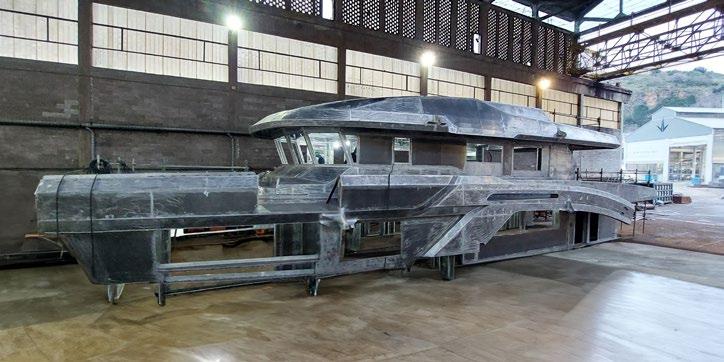
“Over the past few years, the size and price gap between fibreglass and metal yacht construction has narrowed.”
Antonini Navi debuted at the Genoa Boat show in October 2020 with its modular UP40 (Utility Platform) concept designed by Fulvio De Simoni. The 40-metre, steel-hulled concept allowed clients to choose a specific yacht type – Crossover, Island, or Explorer – during the building process by swapping out the bow and stern blocks. The scalable naval platform was thoroughly tested in MARIN’s towing tank to validate performance parameters such as propulsion, shaft pitch angles, hull resistance, and sea-keeping capabilities.
Six months after the release of the UP40 concept, Antonini Navi announced it had started building the two central blocks of the first hull on speculation. Thanks to its modular design, the UP40 morphed into the “all-terrain” SUY 135, or Sports Utility Yacht, with naval architecture by Studio Arrabito. Then in 2023 two sales followed in rapid succession: Project Hanaa, a 31.2-metre steel and aluminium yacht designed by Hydro Tec with interiors by Hot Lab, and the Seamore 34, a 33.5-metre sister ship with an extended stern. Both yachts are scheduled for delivery in 2026, but the Seamore 34 will be the first to launch towards the end of this year. They also target the same niche market for steel-hulled yachts in the 30- to 50-metre segment, where most competition comes from fibreglass builders.
“We want to focus on a sector that we believe is still underserved,“ says Manna. “Over the past few years, the size and price gap between fibreglass and metal yacht construction has narrowed. It’s true that under 30 metres steel becomes a disadvantage – it’s too heavy, slow and fuel-
hungry for short, coastal cruising. But over 30 metres, it starts to make sense.”
Manna points to the recyclability of steel and its suitability for long-range cruising with greater comfort and confidence. Moreover, it absorbs noise and vibration better than aluminium or fibreglass, and provides greater flexibility for customisation. Well-built steel hulls also hold their value better than fibreglass yachts.
“Combined with our modular approach that reduces complexity and build time, we can build a customisable 50-metre yacht in 30 months, and a 34-metre in 24 months,” says Manna. “And at prices not dissimilar to some GRP yachts of comparable size.”
The modular approach is not quite as simple as it sounds, however. The central hull blocks remain the same, but altering the bow and stern impacts how the weight is distributed.
This shift affects the yacht’s centres of gravity and buoyancy, which together play a crucial role in the longitudinal and transverse stability of the vessel. In simple terms, if the centre of gravity is not properly aligned with the centre of buoyancy, the yacht could become unstable, leading to excessive pitch or roll – or worse.
“Maintaining hydrostatic balance is critical,” affirms Manna, who studied naval engineering at the University of Genoa.
“This is why we back up CFD simulations with real-world testing in the towing tank, adjusting various design elements to ensure seaworthiness across configurations with optimised centre-of-gravity management, propulsion efficiency, and controlled pitchroll dynamics in varying sea states.”

Antonini Navi’s approach is fundamentally shaped by the technical culture of its parent group. Although the term metalmeccanica –the Italian word for industrial metalworking – typically implies basic metal processing, Antonini’s operations go well beyond this. Its plant in nearby Arcola has roll-bending machines capable of forming 15 cm steel plates and cutting machines able to slice through 20 cm of steel, a capacity rare even among the largest superyacht builders. Additionally, the shipyard uses the same radiophonic techniques for testing and certifying weld seams employed in offshore platform construction, which far exceed yacht standards that commonly rely on visual quality and surface crack detection. While the client for Project Hanna was constrained by berth size, the owner of the Seamore 34 wanted increased autonomy and expanded deck utility without exceeding 300GT – characteristics common to explorer yachts but wrapped in a more refined aesthetic envelope.
The GA follows a conventional formula with four guest suites (one is converted into a gym) on the lower deck, as well as a transverse garage for a 5-metre tender.
On the main deck forward is the master stateroom, a galley amidships with adjoining crew mess, and a spacious aft lounge area with retractable glass walls on three sides and folding bulwarks. The bridge deck offers open-air deck space and interior dining in the sky lounge behind the wheelhouse. However, the focus of social life on board is likely to be the expansive terraced aft deck that leads down to the extended swim platform.
“Extending the stern required recalibrating weight distribution to avoid wave slapping,” says Manna. “We chose to incorporate the swim platform into the actual hull structure rather than simply applying it as an addon. This fully integrated solution improves performance at anchor and under way while avoiding common acoustic issues.”
Reducing noise and vibration to a minimum was another priority for the owner. Using a layered insulation system that combines rubber supports, rock wool, multi-zone anti-vibration pads, and dense rubber subflooring, sound levels in the main saloon are expected to be just 48 dB at anchor and 52 dB underway – levels more typically found on a 60-metre yacht, despite the fact the lounge is just above the room.



With the new construction shed housing the Seamore 34 and Project Hanaa already operational, Antonini has earmarked a further €5 million to increase production capacity and efficiency. One of the most important investments will be redeveloping a second hangar, which will see its footprint expanded from 62 to nearly 70 metres in length.
Once complete, this building will support both metalworking and final assembly, enabling production of up to six yachts of 30-40 metres in parallel inside the shipyard, although Manna is aiming for two launches per year, or four build slots in operation from keel laying to final outfitting.
Other outdated buildings are due to be demolished, which will free up over 1,200 square metres of space. New machinery includes a 400-tonne crane for major hull lifting operations, a 100-tonne gyroscopic Terex crane, and upgraded electrical and utility systems to accommodate heavier production demands. Further investments include a specialised metal-forming machine and enhancements to the mechanical workshop in Arcola. The entire industrial investment plan is set to last through 2027.
“In addition to increasing capacity, we’re introducing sustainability initiatives across our facilities,” says Walter Antonini, Gruppo Antonini’s general manager. “These include the installation of solar panels with the goal of covering up to 80 percent of our production energy demands through self-generation.”


From humble beginnings repairing wardamaged metal structures in the aftermath of World War II, Gruppo Antonini has grown into an industrial powerhouse. Founded in 1943 by Walter Antonini Senior in La Spezia, by the 1950s it had expanded its focus to include metalworking and industrial plant assembly. But it wasn’t until the 1960s, when the company partnered with Enrico Mattei, the founder of Eni (Italy’s national energy company), that the real turning point occurred. This collaboration led to building complex structures for the oil and gas industry. In 2015, several family-run businesses merged to form the current Gruppo Antonini, with a new focus on diversification. When the group entered the superyacht sector and set up Antonini Navi, led by Simone Antonini, it was a natural extension of its existing capabilities in metalworking and high-tech manufacturing. As the EU aims to become climate neutral by 2050, the group is now looking to enter the renewable energy market, with plans for wind farms, carbon capture technologies, and the green conversion of existing infrastructure.
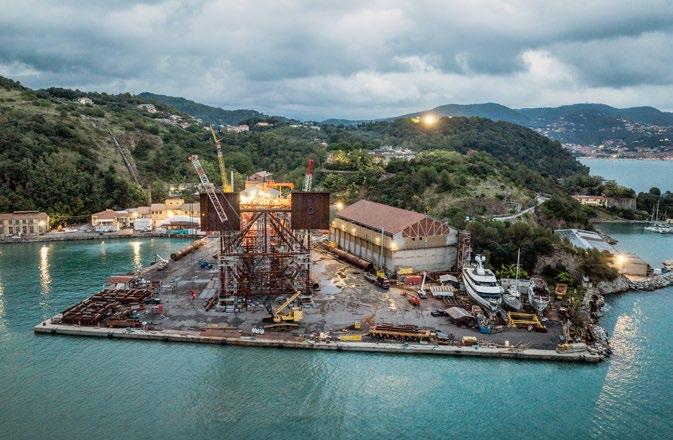
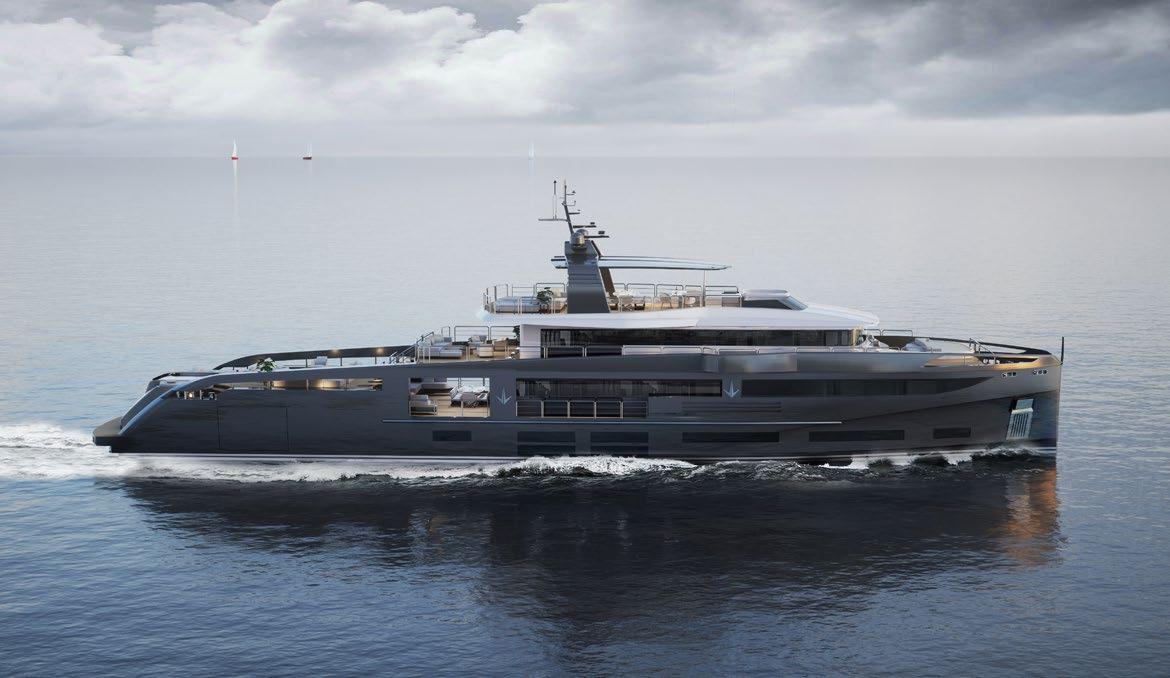
“Antonini Navi is betting on raising consumer awareness of the advantages of metal construction in a size sector dominated by fibreglass boats.”
The Seamore 34 has a standard yet robust and fuel-efficient propulsion system based on twin Caterpillar C18s of 700 hp each tailored for long-distance cruising with a top speed of just under 14 knots. Projected range is over 4,000nm at a cruising speed of 12 knots, and 5,000 nautical miles at 10 knots when fuel consumption is a frugal 130 litres per hour with a generator on.
The yacht is designed for cruising in a variety of climates, including tropical regions. To this end, there are dedicated chillers not only for the HVAC system, but also for galley equipment such as refrigerators, freezers, and icemakers. High exterior temperatures and warm seawater also mean higher risk of condensation and metal areas prone to temperature differences are treated with Mascoat, an anti-condensation coating that also assists in damping vibrations that cause noise. The yacht’s systems include moisture sensors in voids behind wall panels or under flooring so that any condensation can be detected before it becomes problematic.
Other details that highlight attention to strength, durability and quality finish include the anti-collision plate in the bow made from polished 316L stainless steel that is an integral part of the bow stem rather than being bolted on; the 15mm teak decking in areas of high footfall on main deck (12mm on the upper decks to minimise top weight); and the double clearcoat that both enhances the the metallic champagne paintwork and extends its lifespan.


As demand grows for yachts that combine robustness, custom design and fast delivery, Antonini Navi is betting on raising consumer awareness of the advantages of metal construction in a size sector dominated by fibreglass boats. Its modular naval architecture, backed up by quality commercial-grade construction, makes sense on paper and Manna reveals that since 2020 he has developed 60 distinct projects for potential clients – some bespoke, others tailored from existing models. The main issue is the same as for any start-up boat builder – clients want to see a hull in the water before they commit. “That’s why we’re now moving to phase two,” he counters. “Within the next six months we will have launched two yachts and people will be able to see firsthand the quality and seriousness of our work. These two projects are more than just one-offs for Antonini Navi – they’re proof of concept.”
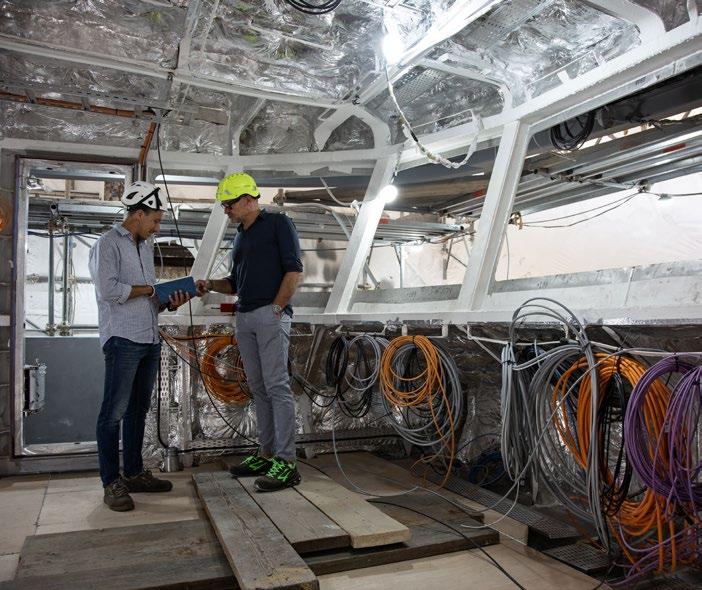

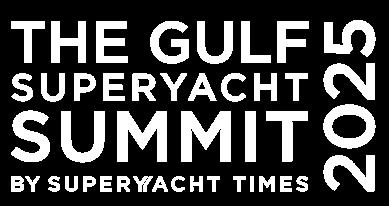
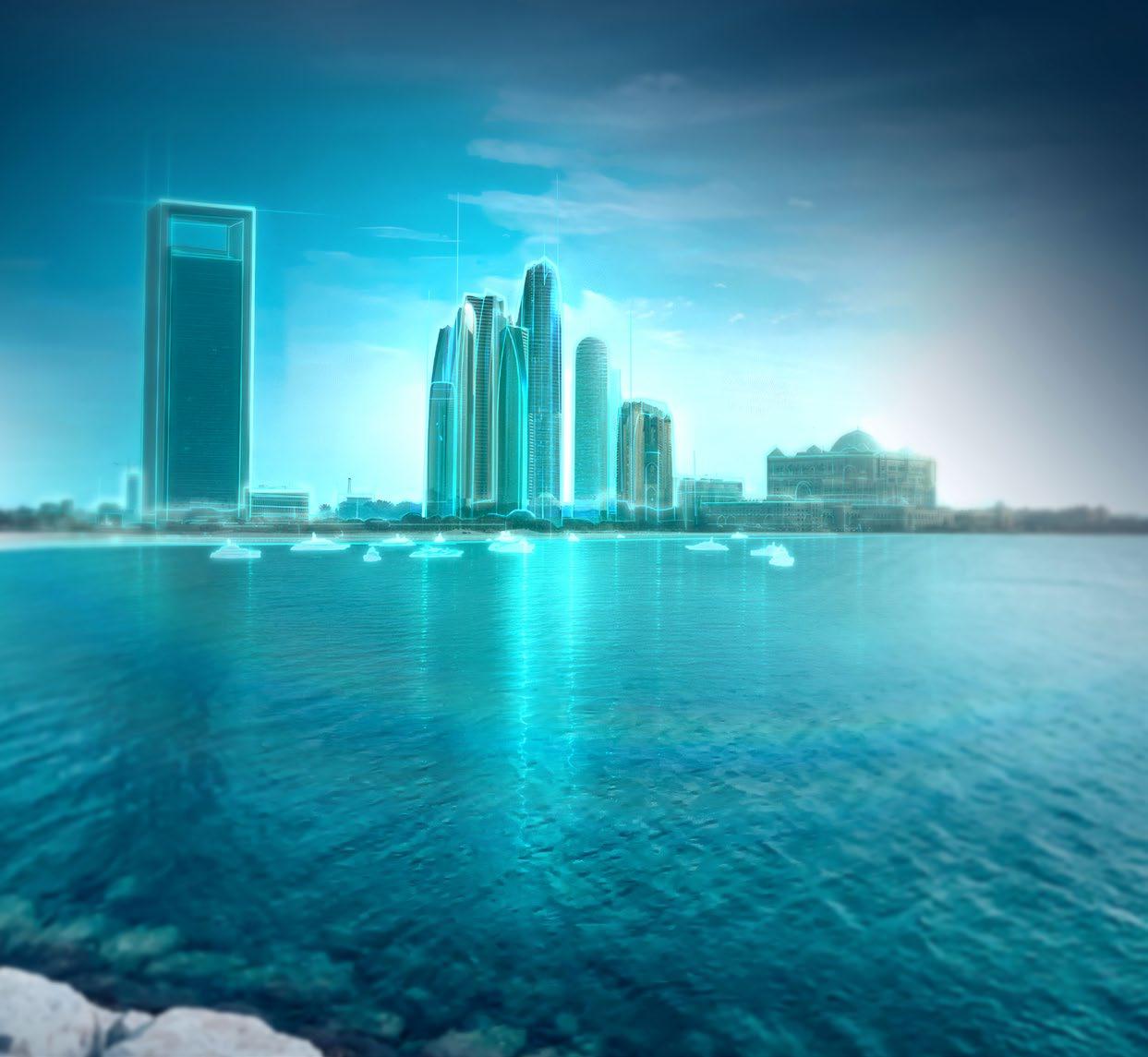


















HVAC systems, still largely based on 25-year-old standards, account on average for 50% of total yacht energy use – making them the single largest continuous energy consumer. The future of yacht operation is digital and data-driven, and systems are becoming connected and intelligent. Patrick Voorn, founder of Synergy | The HVAC Consultancy, part of the BOND Support & Services Group, explains how HVAC is central to this shift.
BY PATRICK VOORN
Definition and baseline creation

Reporting and evaluation results
The superyacht industry is making considerable efforts to reduce its environmental footprint. Innovations in hybrid propulsion, waste-heat recovery, and advanced fuel management are gaining traction, driven by regulatory pressure and client demand for sustainable solutions. Yet propulsion represents only a fraction of the energy story. Yachts spend just 7–10 percent of their time underway. During the remaining 90 percent of their operational life while moored, at anchor or in port, other onboard systems dominate the energy demand. The largest of these is HVAC, making it the single biggest lever for reducing fuel consumption, cutting operational costs and improving efficiency.
Because the HVAC segment has been largely unchallenged or pressed to develop more efficient systems, a large segment of the market has remained unchanged, aside from the use of waste water for heating. Most yachts still rely on chilled-water Variable Air Volume (VAV) systems or fan coil units with make-up air units sized with generous safety margins. These systems are robust, but often oversized, left to run in ‘set-and-forget’ mode, and rarely optimised once installed. Because performance data is limited, inefficiencies go unnoticed. The result: unnecessary chiller runtime,
Testing and validating the implementation
Implementation
Initial report & optimization plan
overactive pumps, and wasted thermal energy circulating throughout the vessel. This lack of transparency is one of the reasons why innovation has been slow. But the combination of real-time monitoring, digital twins, and AI analytics is now changing the picture.
Specially designed software is now able to collect over 1.5 million data points every day. From chiller units, pumps, valves, sensors, air handlers, and thermostats, we can see how the system actually performs under realworld conditions. This data feeds a digital twin – a live, virtual replica of the onboard HVAC system. The twin mirrors, among other things, temperature, flow, pressure, and energy use in real time, allowing engineers to see not only what is happening, but why.
This insight allows inefficiencies to be diagnosed with precision. Engineers can detect and correct imbalances between the technical parts; identify unnecessary energy use during low-load periods; adjust setpoints dynamically based on occupancy and climate conditions; and provide full support to ease the workload of the onboard crew. Most of the time, all of this can be done without replacing, or adding hardware, meaning large efficiency gains are possible even on yachts that are mid-life or newly delivered.

Traditionally, HVAC has been a mystery to many yacht crew. Performance was judged by comfort rather than efficiency. With live data and AI-driven analysis, that is changing. Modern platforms use machine learning to recognise normal operating patterns and flag anomalies early. For example, a subtle pressure drop might indicate a developing refrigerant leak, or a small temperature drift could reveal a faulty sensor or miscalibrated valve, or persistent high energy use under light load can highlight oversized or poorly tuned components.
This turns HVAC from a passive system into an actively managed one, enabling predictive maintenance and data-driven decision-making, rather than reactive troubleshooting. Realworld deployments have shown over 30 percent improvement in HVAC performance, translating into total vessel energy savings of 10–15 percent when we refer to HVAC consuming 50 percent of the total energy. That’s not just lower fuel burn and CO₂ emissions – it’s also reduced generator runtime, longer service intervals, fewer compressor starts and increase comfort for guests.
The process begins when the yacht’s HVAC drawings are provided. These serve as the foundation for configuring the software. With expertise in cybersecurity and maritime systems, Delta Digital’s specialists ensure each step is executed securely and efficiently.
In most installations, the onboard technical crew supports the setup by creating a connection to the yacht’s network and hosting a virtual server. Once the system is online, data collection begins immediately.
The first 30 days are designated as the ‘baseline period’. During this time, no changes are made to the HVAC system, allowing engineers to capture accurate operational data under normal conditions. After the baseline is established, Delta Digital’s engineers begin analysing the collected data and fine-tuning system parameters to optimise performance.
A dedicated dashboard provides a clear overview of system behaviour, showing both the original settings and the effects of any adjustments. Key Performance Indicators (KPIs) display efficiency metrics for the five most critical subsystems. A separate ‘Savings’ page quantifies energy savings relative to the baseline, offering an at-aglance view of the improvements achieved. All data is accessible to the onboard engineering team, with historical trends available for any timeframe, from the last five minutes to the system’s first day in operation.
This is the feedback from the owner’s representative of a recently delivered 100-metre-plus yacht: “Despite our HVAC installation being new and ‘state-of-the-art’, we were aware it was not functioning as well as it should and were frustrated by the lack of transparency in the monitoring system. Despite expecting some improvements in efficiency, we are genuinely surprised by the extent of those gains with the added benefit of a much better balanced chiller system. The monitoring and trending the system provides us with have been invaluable for a better understanding of the system.”
Too often, HVAC systems are sized conservatively at every step – thermal load estimation, equipment selection, control strategy – leading to stacked safety margins.

The benefits go beyond operational optimisation. For shipyards and naval architects, real performance data provides a basis for smarter design. Too often, HVAC systems are sized conservatively at every step – thermal load estimation, equipment selection, control strategy –leading to stacked safety margins. The result: oversized chillers, larger pumps, increased piping sizes, larger generators, more weight, larger technical spaced which results in reduced interior volume.
Using operational data from comparable vessels, project teams are able to right-size new systems for real-world conditions rather than worst-case assumptions; reduce equipment footprint, freeing up space for guest or crew areas; and lower generator size and fuel requirements, cutting OPEX and CAPEX.
This approach is increasingly relevant as the IMO and class societies tighten efficiency and emissions targets. Intelligent HVAC design supports compliance without compromising guest comfort. Most systems can be brought online within a matter of days and, importantly, all data is owned by the client and is fully accessible, no proprietary ‘black box’ calculations or locked-in service contracts.
Because we don’t sell HVAC systems, our recommendations are fully objective. The goal is simple: to make existing systems perform better and give crews and owners confidence that decisions are based on facts, not vendor sales targets. This independence has been particularly valuable for yacht owners, fleets and management companies, where consistent reporting and transparent KPIs are essential for benchmarking vessel performance.

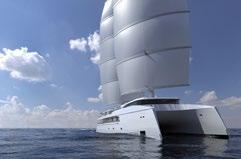















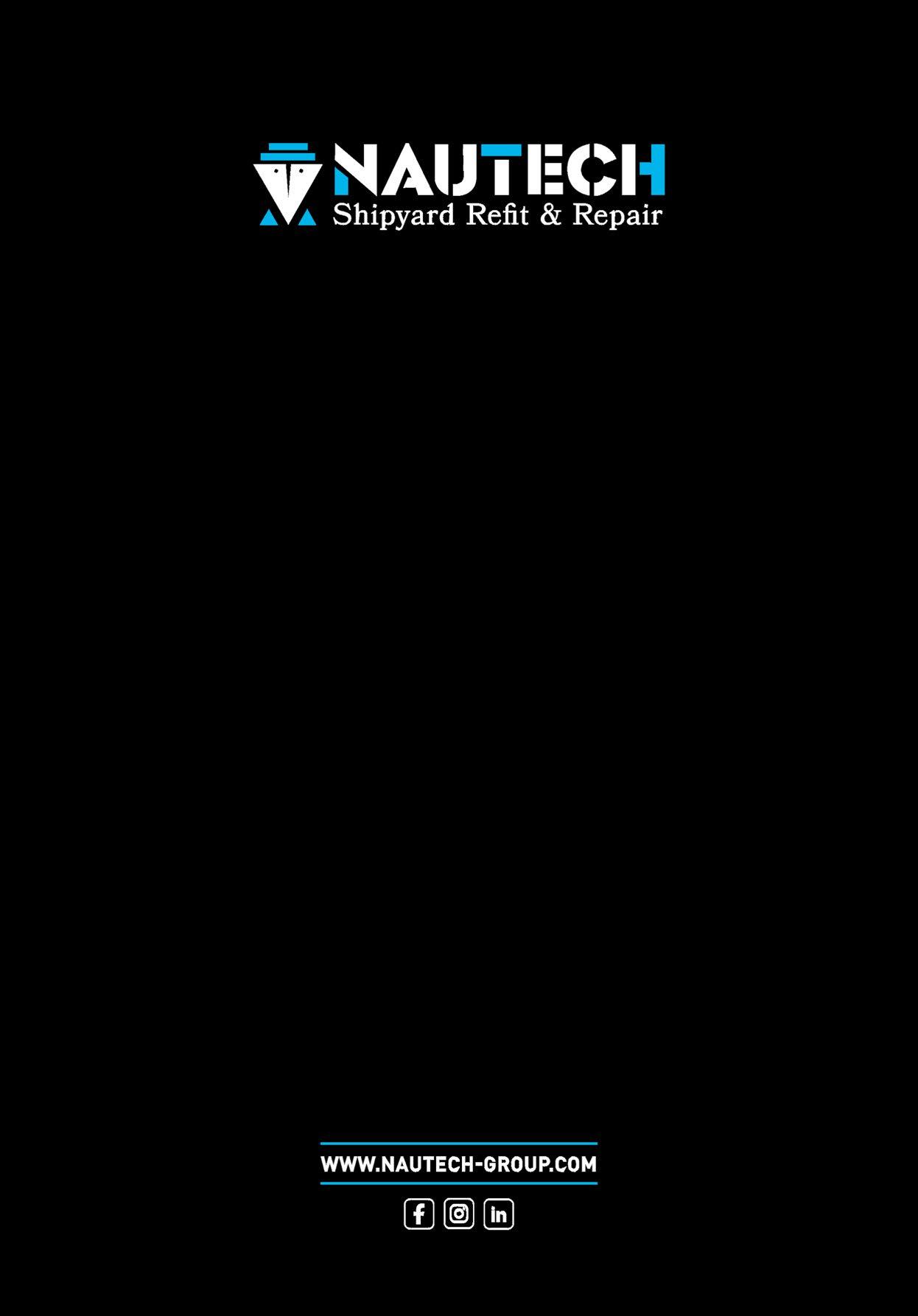

Skip the showcoat – get faster and more efficient with Alexseal HS Prime Coat 435 –it is primer and showcoat in one product.
Visualize even the smallest irregularities of the previous layers with our glossy primer. Boost your primer work with all you need for a professional application: High solids for less VOC and better hiding power, minimized shrinking and easy sanding.
Find all glossy details here →
instagram.com/alexsealpaint linkedin.com/company/alexseal-yacht-coatings
WWW.ALEXSEAL.COM